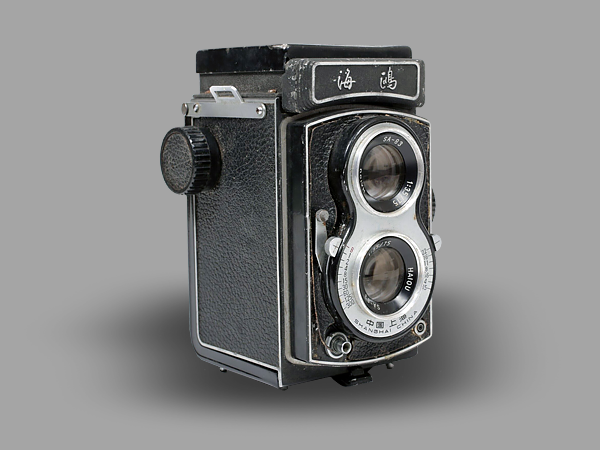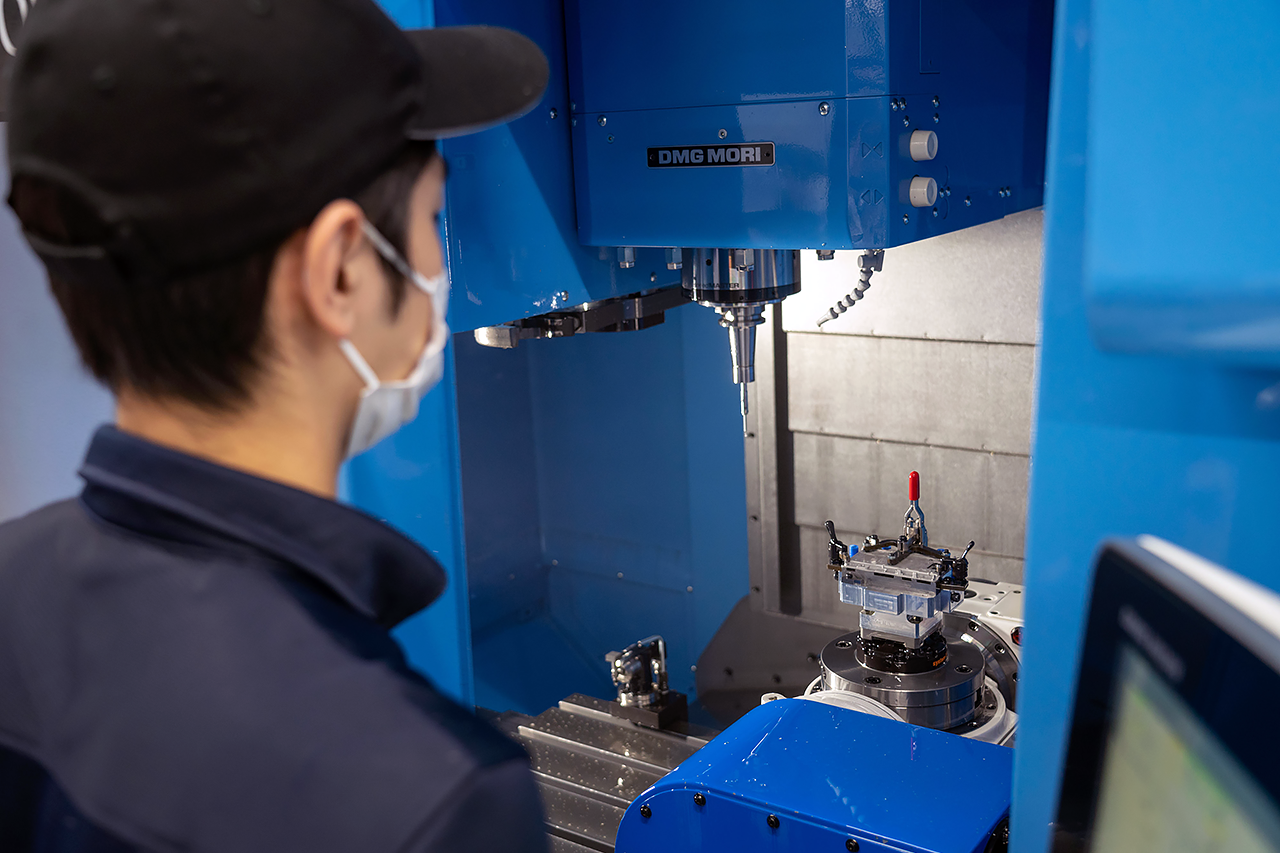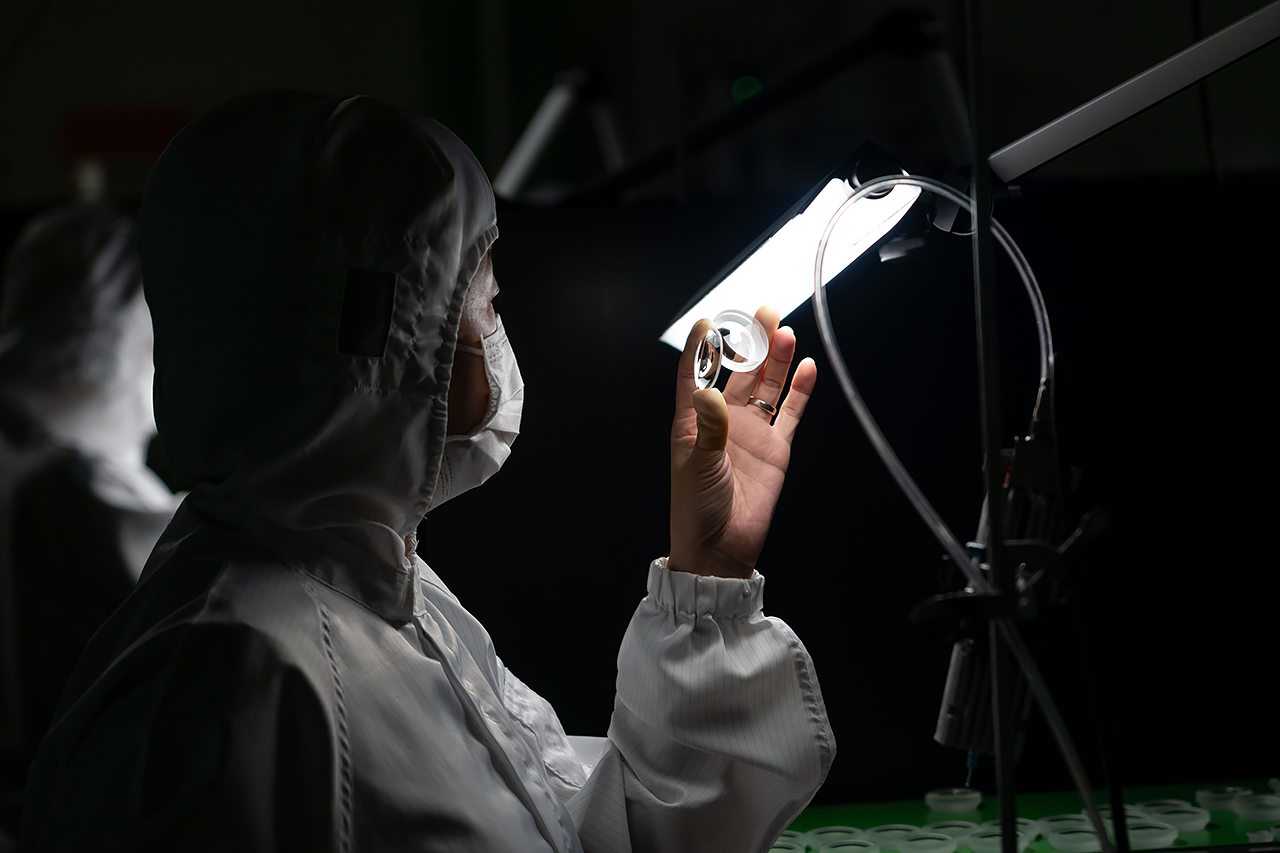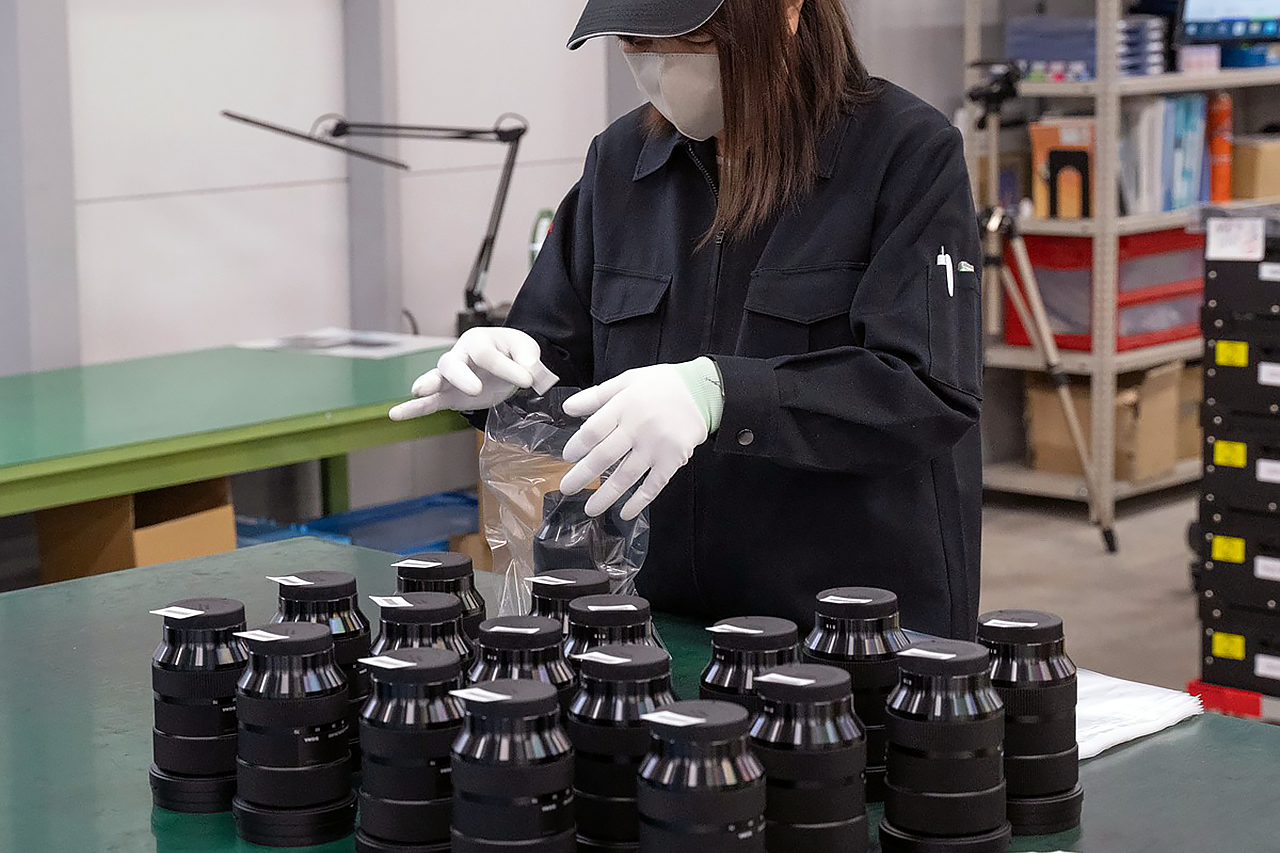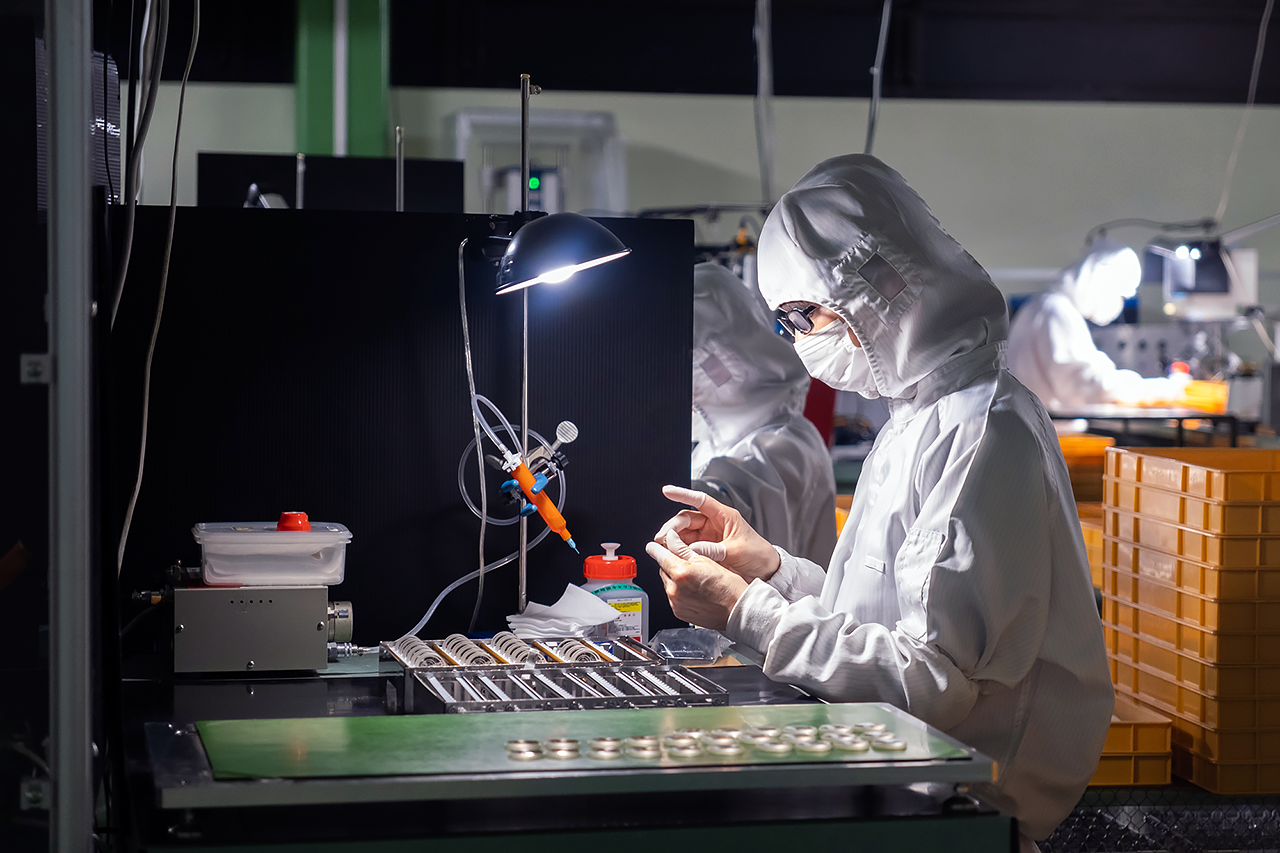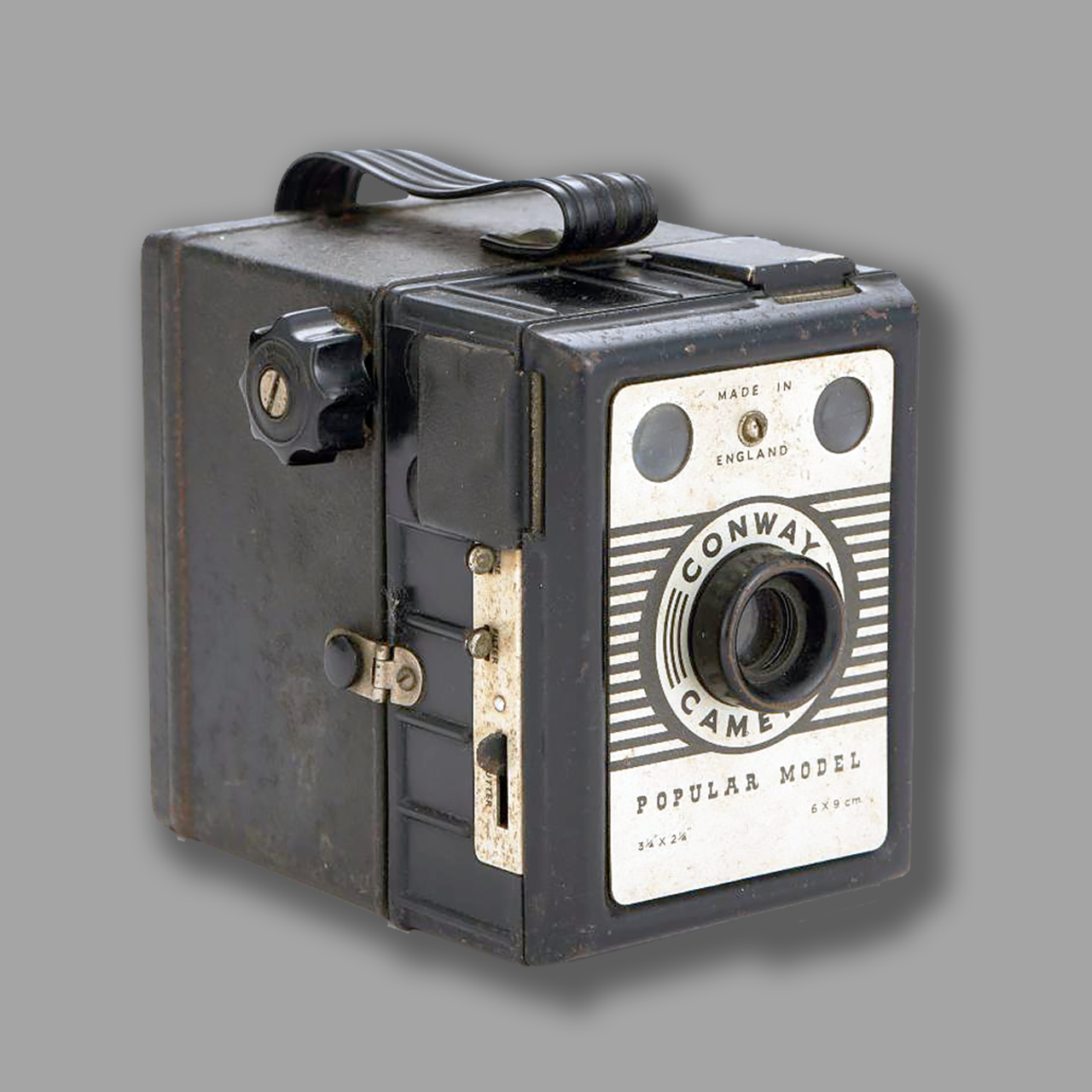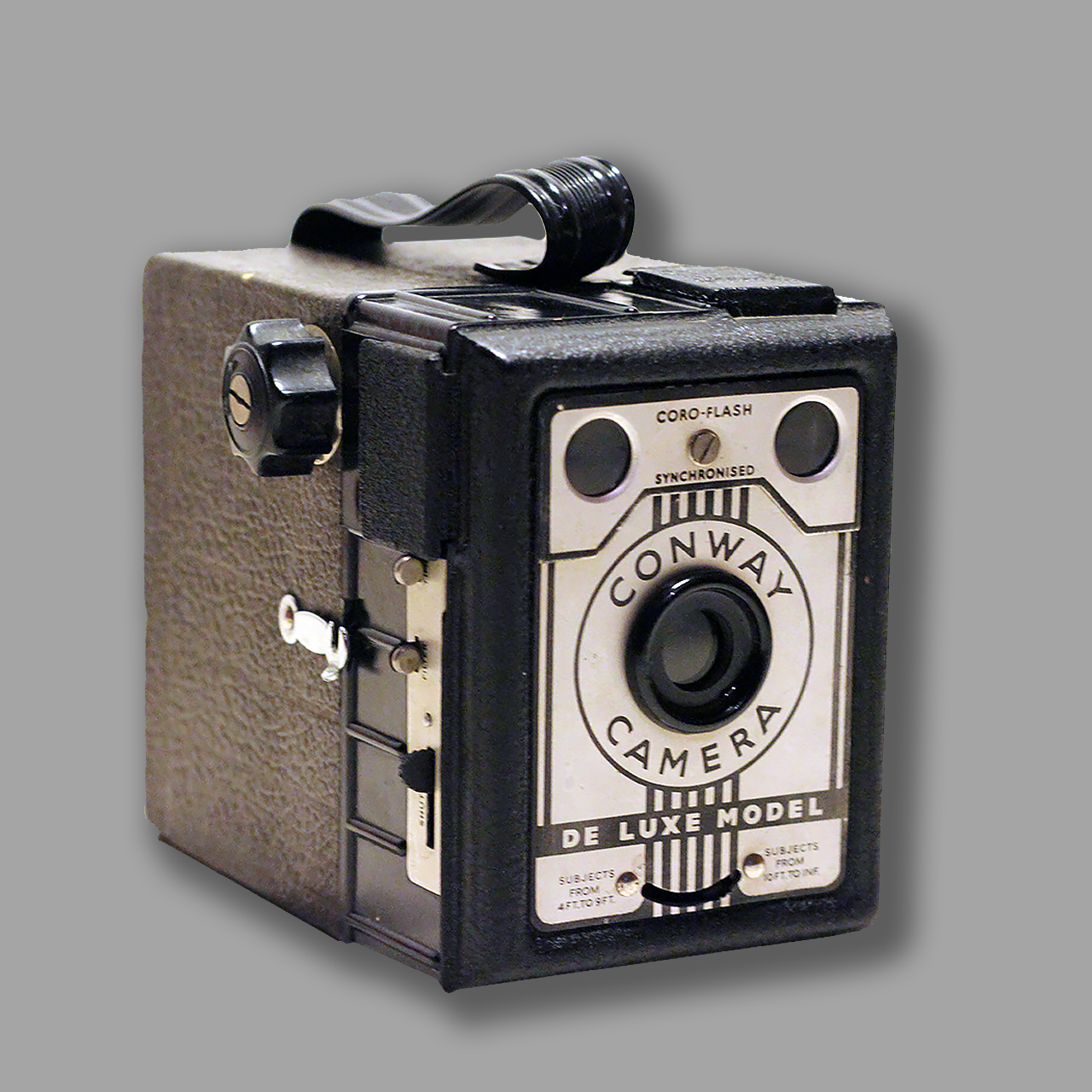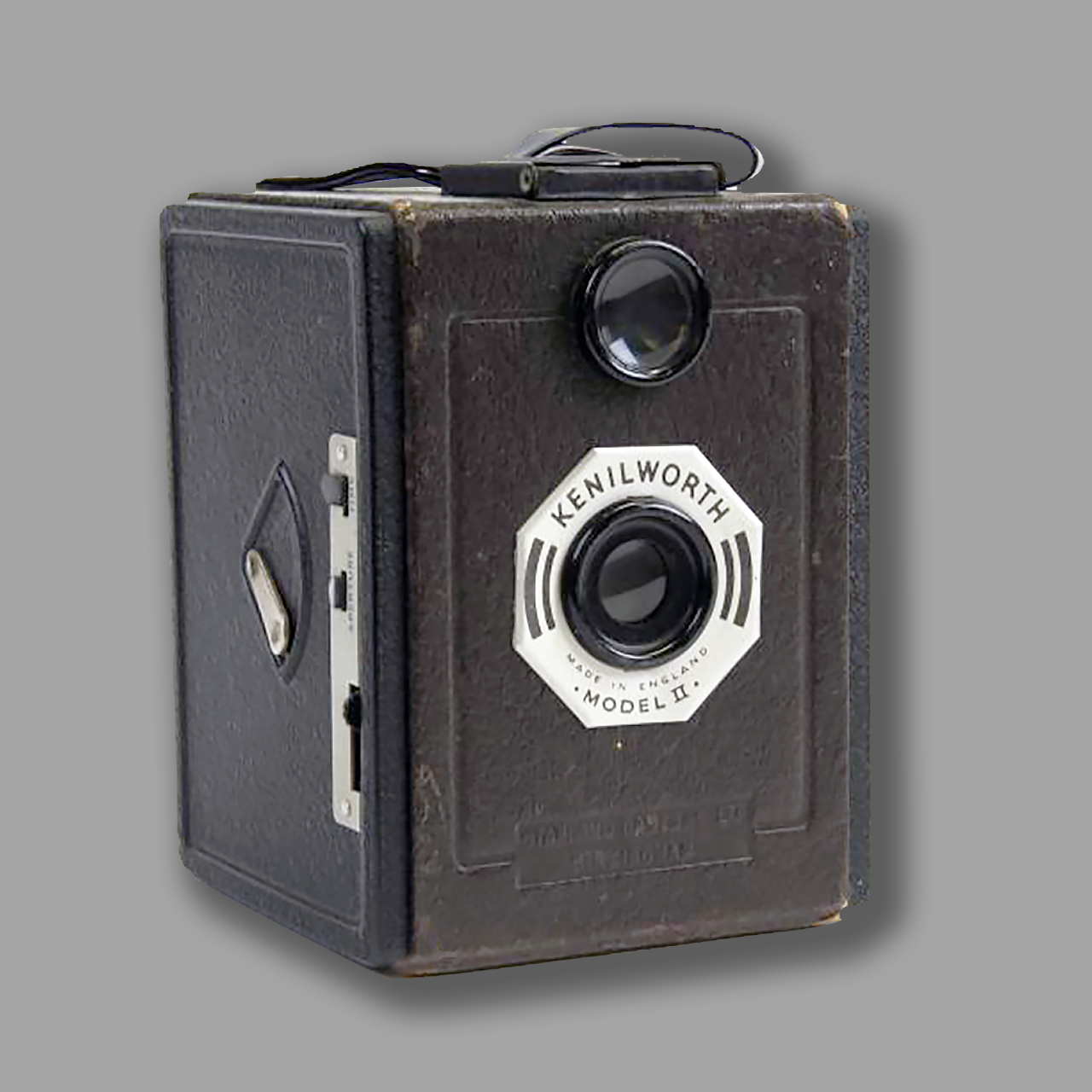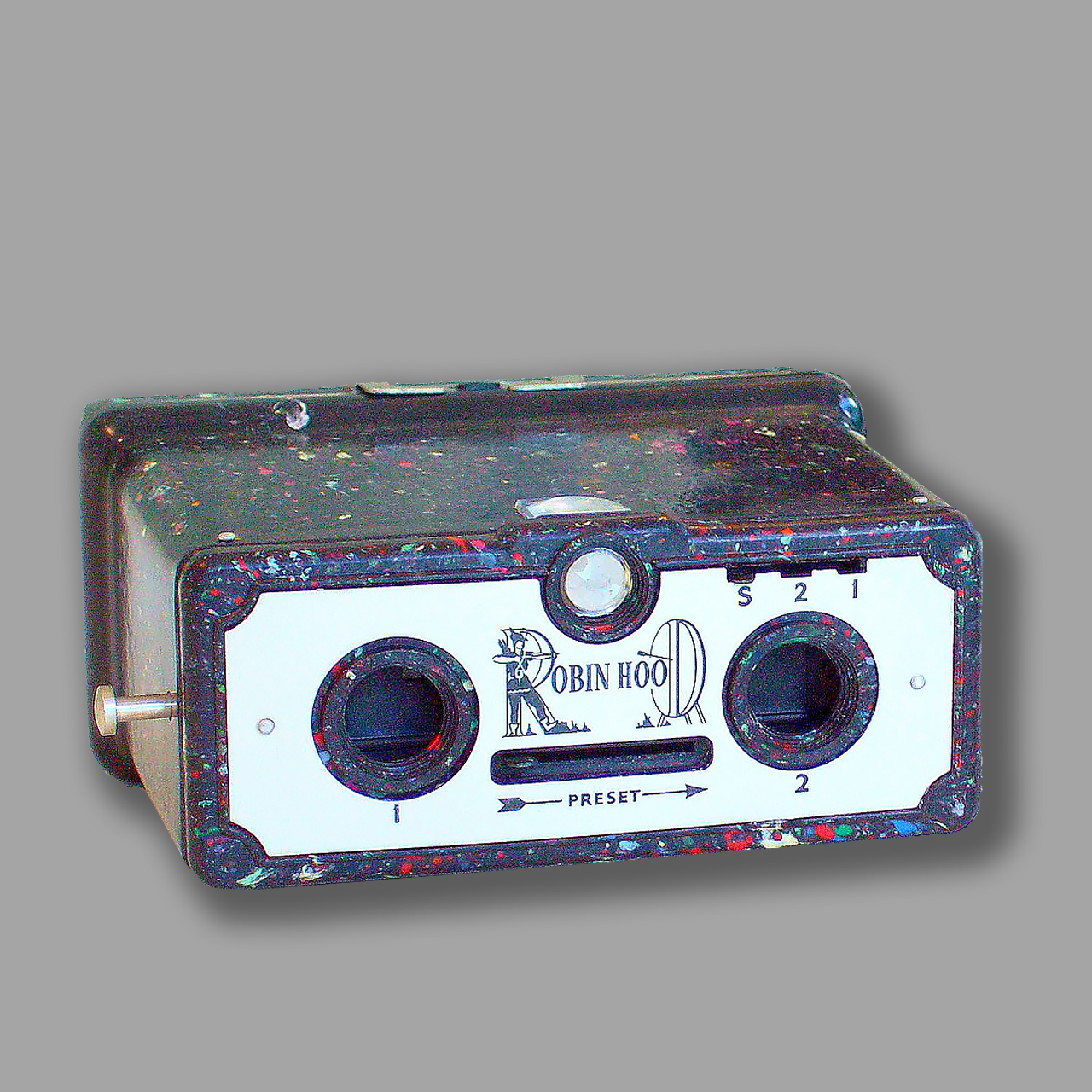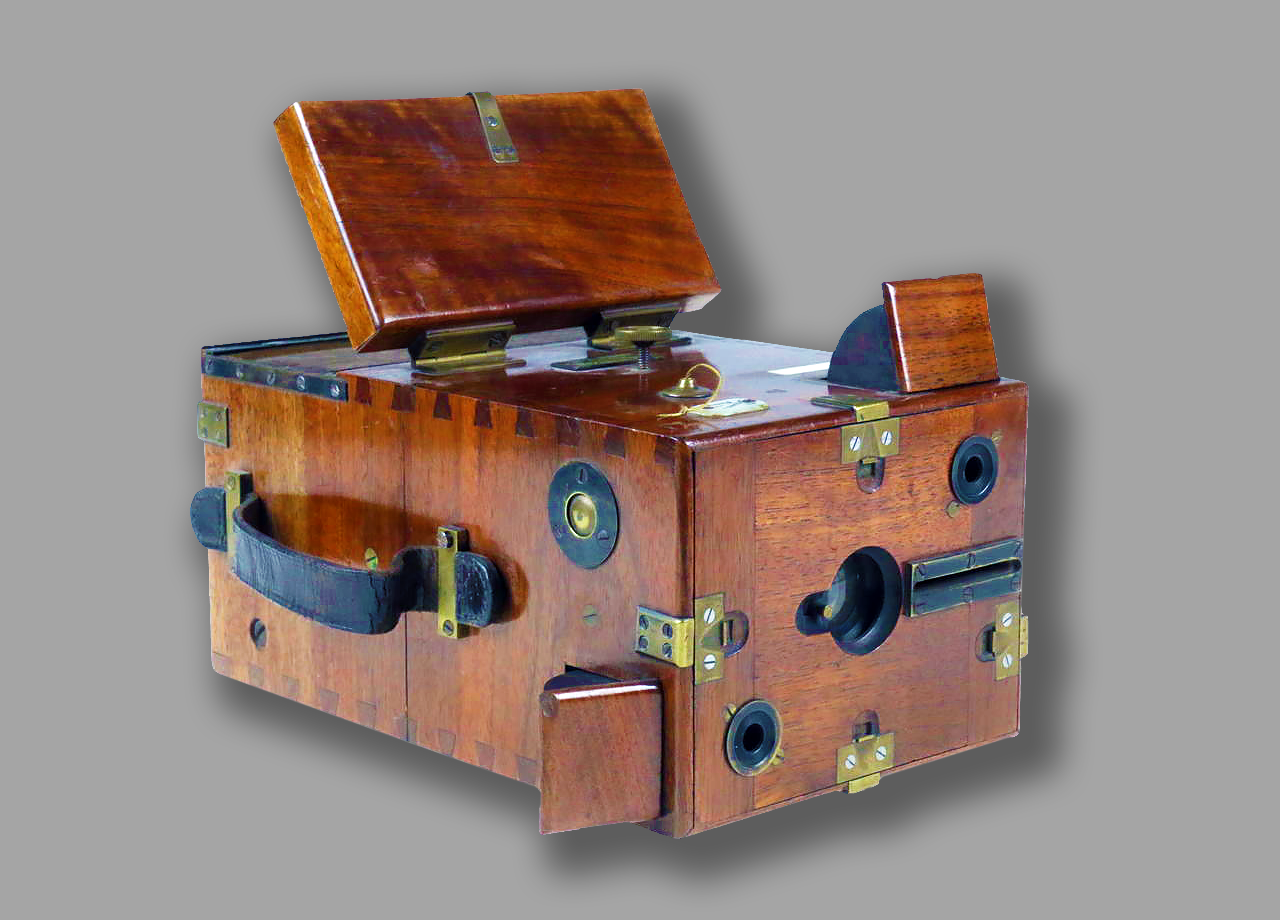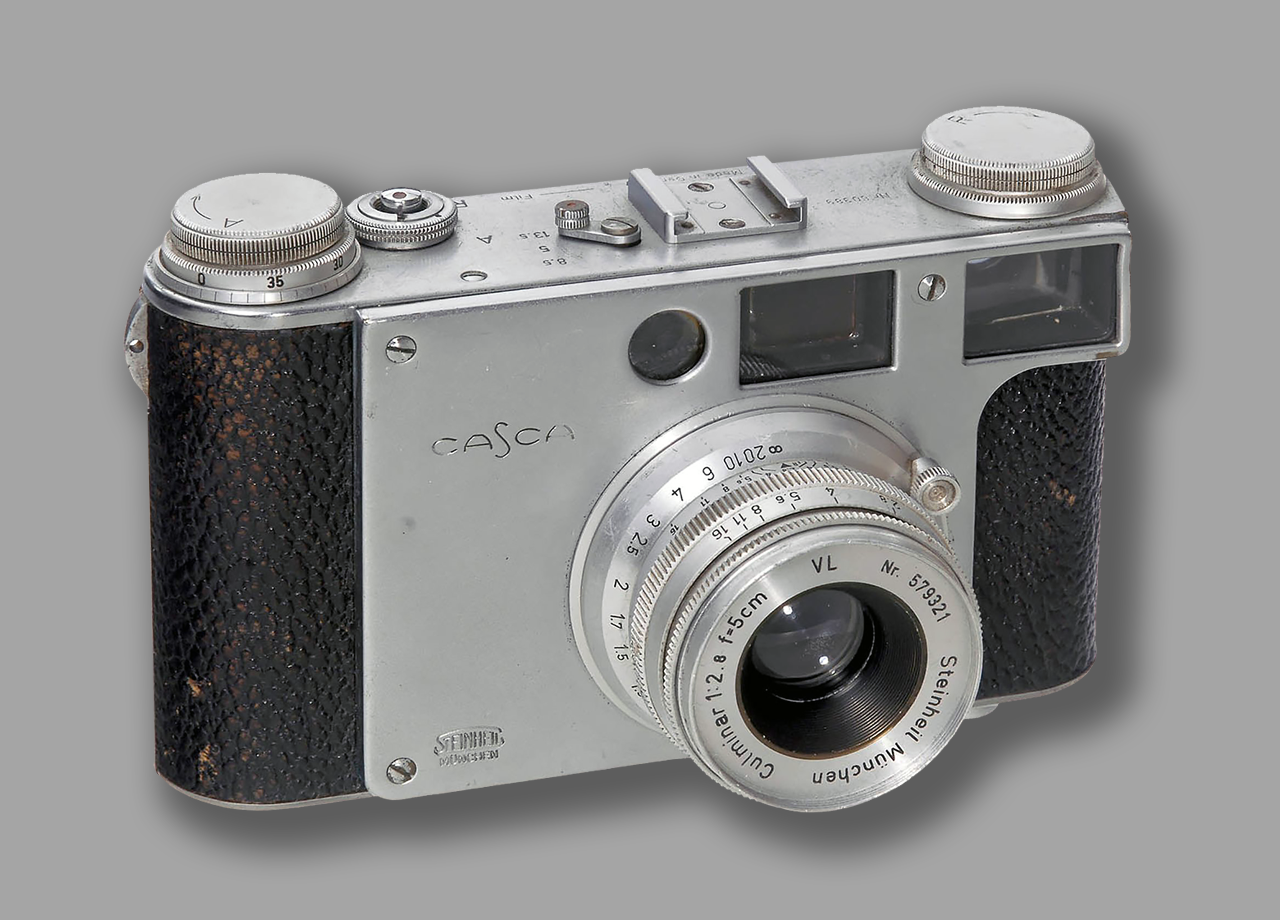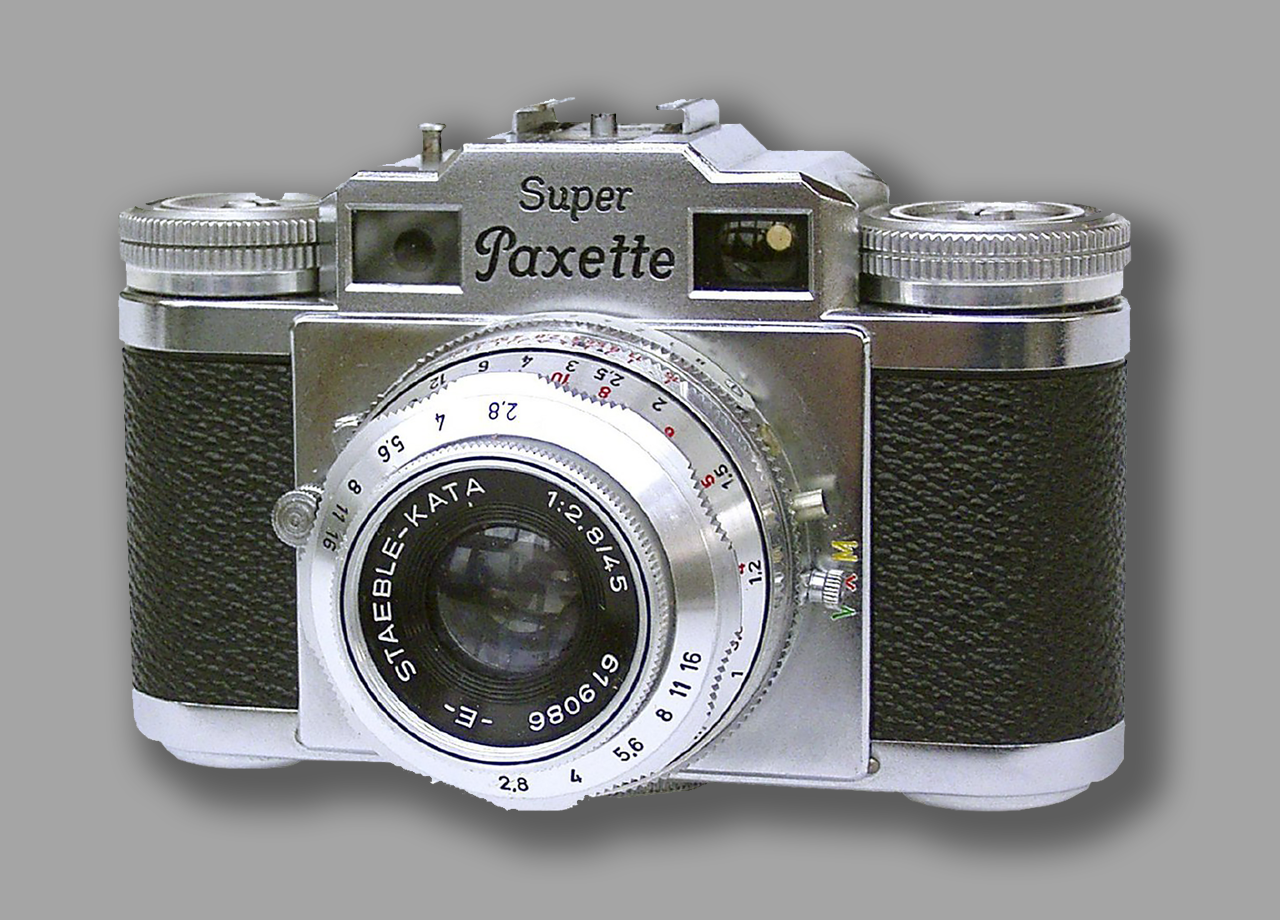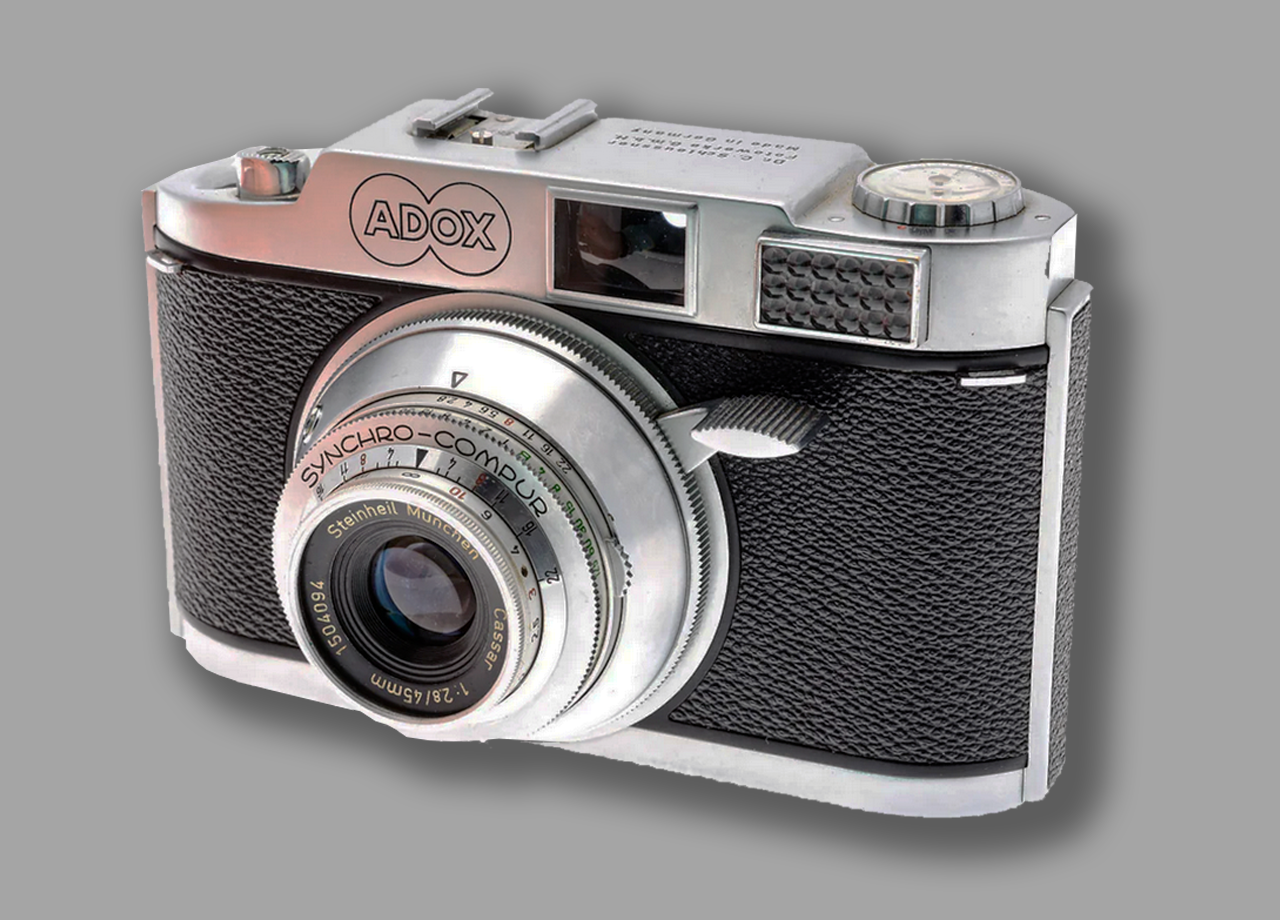Some of the following companies that manufacture(d) photographic material have already passed by in other parts of the site. Here you will find an overview of companies that marketed photographic material in the nineteenth and twentieth centuries. More is usually known about the best known or the most influential companies than about the lesser known ones; therefore they will be discussed more extensively than others.
The emphasis in this part of the site is more on the ups and downs of the company as such, while in other chapters the emphasis was on the product or on the man or woman who founded the company. The order of all companies is alphabetical.
Below are the names of the companies as will be discussed in this or any other chapter. By clicking on a name (so not on the bullet in front of it), you go directly to that part on this page where the manufacturer in question is located. Scrolling is also possible of course, but this service helps you to get to the desired manufacturer in question much faster.
Due to the fact that this introductory page has become much longer than originally planned and desirable due to the large number of manufacturers, we strongly advise you to use the name service below to go to the manufacturer of your choice on this or any subsequent page.
- General Introduction
- ADOX
- Agfa (see also Gevaert)
- Altissa
- Amaloco
- Ansco Camera Co (see also GAF)
- APM/APeM (see also Soho)
Amalgamated Photographic Manufacturers Ltd - Argus Camera Co, Ann Arbor Michigan
- Arsenal (see Kiev-Arsenal)
- Artima Export Ltd (see also Truvox)
- Asahi Pentax
- Bencini
- BOLCo and E Elliott Ltd
(abbrev. for The British Optical Lens Company) - Carl Braun Kamera-Werk
- Canon Inc.
- J.T. Chapman, Manchester
- The Chicago Cluster of Companies
(consisting of 56 companies ) - Chinon
- Concord Camera Corp.
- K.G. Corfield & K.G. Corfield (Sales) Ltd.
- Coronet Camera Company
- Cosina Company, Ltd.
- Dacora
- Dixons
- Durst
- EHO-Altissa company (See Altissa)
- E Elliott Ltd and BOLCo
(abbrev. forThe British Optical Lens Company) - Ellison Kamra
(see also QRS Devry Kamra Company) - ELOP
- Ensign Ltd. (distribution Company of Houghton-Butcher)
- Ernemann-Kamerawerke AG
- Expo Camera Company
- The FED Company
- Ferrania
- Fisher-Price
- Fodor
- Foitzik-Kamerawerke
- C.F. Foth
- Fototecnica
- Franka Kamerawerk –
- Fujica (Camera Division of Fujifilm)
- Fujifilm (brief history)
- Futura
- GAF (see also ANSCO)
(abbrev. for General Aniline & Film) - Louis Gandolfi
- Herbert George Company
- Gevaert Photo-Producten N.V. (see also AGFA)
- Girard et Cie
- GNOME
- GOERZ
- GOMZ (LOMO)
- Graflex (Folmer & Schwing)
- Great Wall Plastics Co
- W. Haking Enterprises Ltd.
- Hanimex
- Hasselblad
- Healthways
- Houghton–Butcher Manufacturing Co (See also Ensign Ltd. and Ross-Ensign Ltd.)
- R.F. Hunter Ltd.
- ICA AG
- Ihagee (Exakta)
- Ilford
- Imperial Camera Corporation
(see the Herbert George Company story ) - Jos-Pe
- Kamera-Werkstätten Guthe & Thorsch
- Keystone
- Kiev Arsenal
- KMZ
- Kochmann
- Kodak USA (incl. Australia, Canada, France, Germany & the UK)
- Konica-Minolta (Konishiroku)
(see also Minolta) - Kowa
- Krügener
- Kürbi & Niggeloh (Bilora)
- Kyocera (Yashica, Contax)
- Lancaster
- Leitz
- Lensless Camera Manufacturing Company
- Linhof
- Lipca (see also Richter-Tharandt)
- LOMO (see GOMZ)
- Loreo
- Mamiya
- Meopta Optotechnica
- Mimosa AG
- Minolta (see also Konica-Minolta)
- Minox Company
- Miranda (Orion)
- MMZ-BeLomo
- Motodori (Condor)
- Dr. August Nagel Kamera Werke
- Neidig Kamerawerk
- Nemrod-Metzeler (See Healthways)
- Nettel
- Nikon Company
- Nimslo Corporation (see also Nishika)
- Nishika Optical Systems (see also Nimslo)
- Noblex (See also K-W Guthe & Thorsch)
- Olympus Company
- ORION (see Miranda)
- ORWO
- Ottico Meccanica Italiana (OMI)
- Paterson Products Ltd.
- VEB Pentacon Dresden
- Pentax (See Asahi Pentax)
- Petri
- Photavit (Bolta)
- Plaubel
- Polaroid
- Photo Porst
- Karl Pouva – VEB Fototechnik Freital (see also Woldemar Beier)
- Purma Cameras Ltd.
- QRS Devry Kamra Company (see also Ellison Kamra)
- Foto-Quelle
- Rectaflex
- VEB Rheinmetall Büromaschinenwerk
- Richter-Tharandt (see also Lipca)
- Ricoh
- Rollei Germany
- Rollei Singapore
- Ross-Ensign (continuation from Ensign Ltd.)
- Ro-To Company
- Sea&Sea-Sunpak
- Shanghai Seagull
- Sida-Fotofex
- Sigma
- Soho Ltd (see also APM)
- Standard Cameras
- Steinheil
- Stenopeika
- Thornton-Pickard
- Topcon (Tōkyō Kōgaku)
- Tougodo Company
- Traid Corporation
- TRUVOX (see also Artima Export)
- Tura AG
- Universal Camera Corp.
- Vivitar
- Voigtländer
- Vredeborch
- Welta
- Werra (C. Zeiss Jena)
- Wirgin
- Kamera-Fabrik Woldemar Beier (see also Karl Pouva)
- Hermann Wolf GmbH
- Wünsche
- Yashica (see also Kyocera)
- Zeiss Ikon AG
- Zion
- Zunow (Teikoku Kōgaku)
FOUNDERS: Masaoki Yamaguchi and Masateru Yamaguchi
COMPANY NAMES:
Sea&Sea Sunpak Co., Ltd.
COMPANY ADDRESS:
1972: 1-4-6 Kitasenzoku, Ota-ku, Tokyo 145-0062, Japan.
Sea&Sea is a manufacturer of underwater cameras, underwater strobes, underwater lights, various housings (with waterproof casings), etc.; the planning, development, production and sale of general underwater imaging equipment.
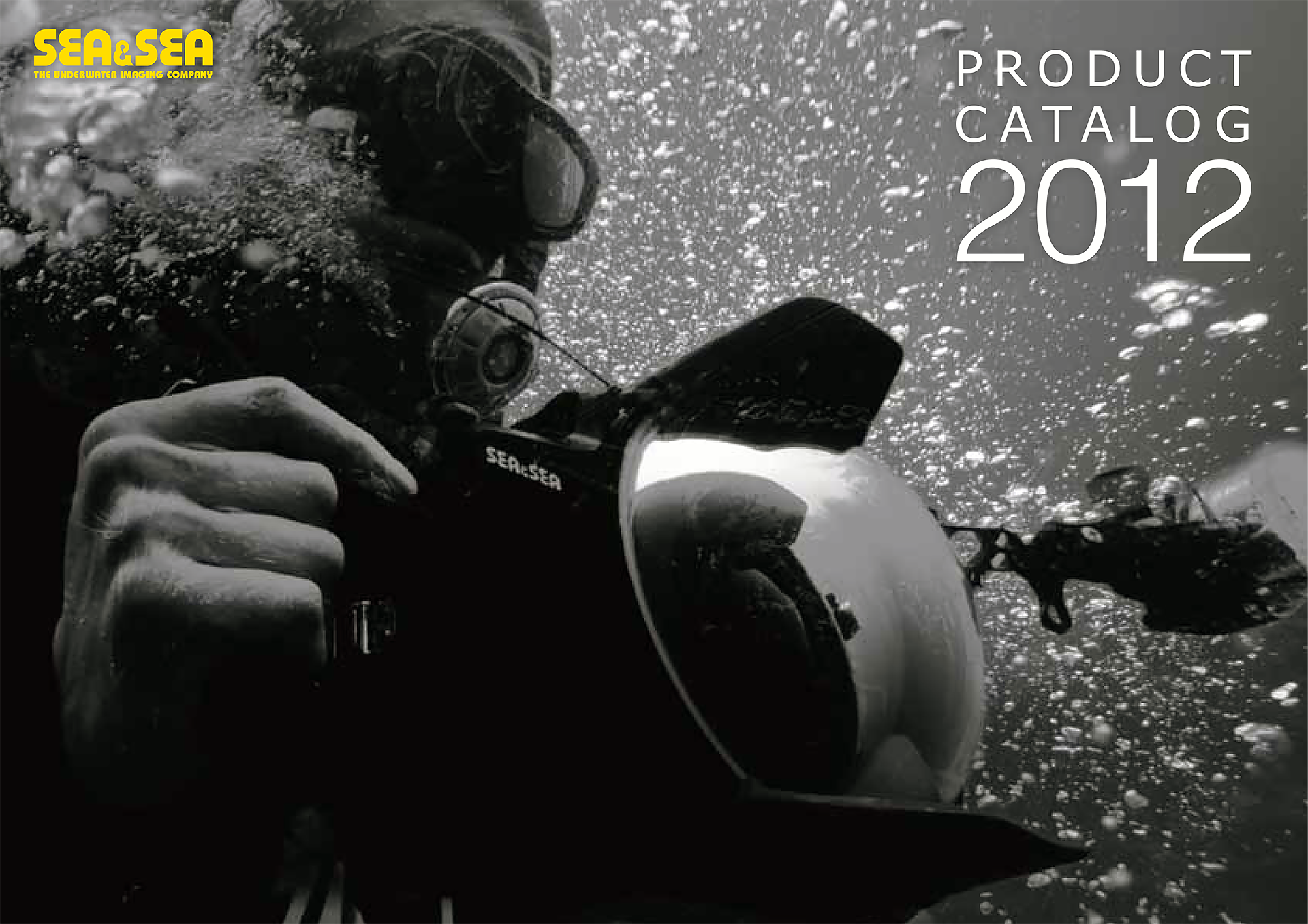
Sea&Sea is a manufacturer of underwater photographic equipment, operating from Tokyo, Japan. They are a division of the corporation Sea&Sea Sunpak Co., Ltd perhaps more widely known for the Sunpak brand of electronic flash units.
The company’s origins were with a waterproof electronic flash unit developed circa 1969 by brothers Masaoki Yamaguchi and Masateru Yamaguchi, and named “Yellow Sub” in honour of the then-popular Beatles song and animated film.
Whether it’s underwater strobes or housings, Sea & Sea is known for producing thoughtful, high-quality underwater systems designed for the divers using them. While in the beginning of scuba diving the 35mm film photography was the standard, nowadays digital imaging is the key for underwater photography too.
Go digital underwater
So Sea&Sea developed among others the DX-6G. The DX-6G is an indestructible, ultra-compact camera made for divers who need a small, easy-to-use camera that they’re going to be bringing to extreme environments. If you’re looking for your first underwater camera, or something simple that you can bring snorkelling and tide-pooling, the DX-6G is a great starting point. The Sea & Sea DX-6G was tested in the cold, current-ridden waters of the Pacific Northwest with an outstanding result.
Any diver and ocean-lover can appreciate durable equipment. Whether you’re a beginner, casual shooter, extreme sports enthusiast, or seasoned professional looking for a small camera, the DX-6G is an excellent underwater tool. If you need more control in your images or 4K video, a larger compact or mirror less system might be a better option. But if you need a durable, simple camera, the DX-6G is the essential “point-and-shoot” system.
Sea&Sea on the DEMA-Show held in Orlando, Florida from November 13 – 16, 2019
![]() Noticing that consumers want more basic luxuries from their housings, Sea&Sea has introduced refined features like yellow silicon handle accents to reduce hand fatigue, ball mounts included as standard, and the new Leak Sentinel 6 detection system to secure cargo.
Noticing that consumers want more basic luxuries from their housings, Sea&Sea has introduced refined features like yellow silicon handle accents to reduce hand fatigue, ball mounts included as standard, and the new Leak Sentinel 6 detection system to secure cargo.
The big headline at the Sea&Sea booth is the new YS-D3 “Lightning” strobe, which boasts a recycle time of 1.5 seconds at full power and 0.6 seconds at half power, with no recycle time at quarter power. The strobe might be a follow-up to the YS-D2 J, but it’s been completely redesigned. Ergonomically, the strobe has increased tapered knob size (power and mode) and a backlit display.
Sea&Sea has also added a 1,000-lumen focus light. While this won’t be enough to light up a wide-angle video scene, it will be more than enough for a focus light and even to light macro video. Other features include a new bayonet for accessories like a dome filter and a snoot.
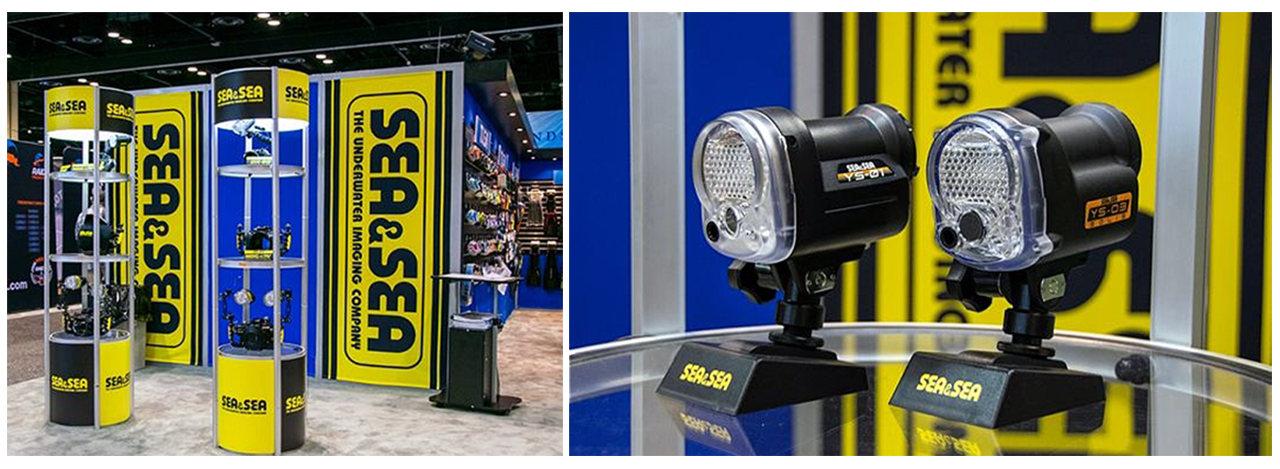
Sea&Sea has also updated their YS-01 and YS-03 “Solis” strobes with new features like a batter post separator and battery exhaust valve
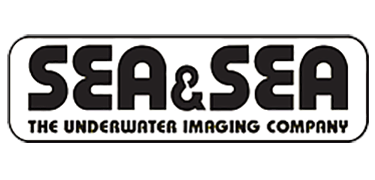
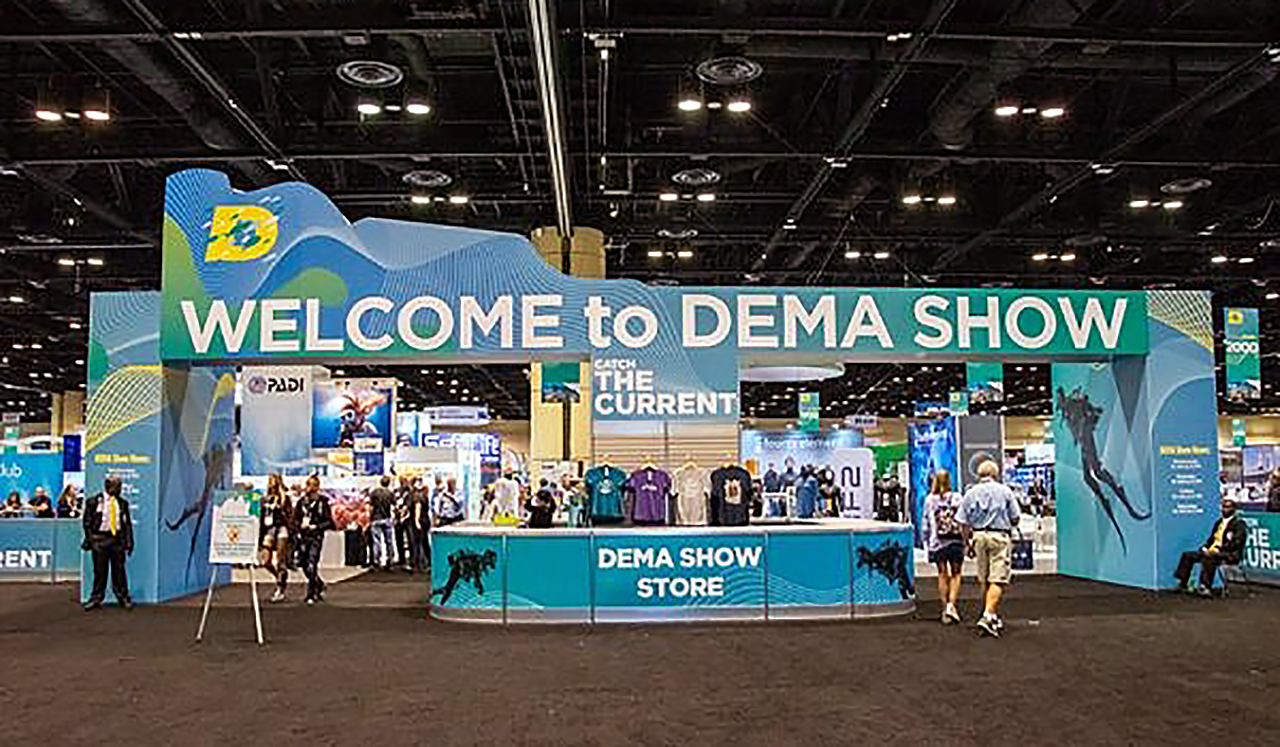
Entrance of the DEMA-Exhibition in Orlando.
Earlier products
Sea&Sea have offered waterproof cameras, housings, and flash units. All of the film cameras which are listed below have been discontinued.
- Pocket Marine 110 SE
- MX-5 II Camera (fixed focus)
- MX-10 Camera (fixed focus)
- Motormarine III (20mm wide-angle lens. Two focus positions, infinity and 2 feet/0.6 m)
- Motormarine II Ex (scale focus & adjustable shutter speed)
- Motormarine II (scale focus)
- Motormarine 35 SE (scale focus)
- Seamaster Pro Ex (scale focus)
- SX-1000 (K-mount 35mm SLR, designed for matching SX-1000 waterproof housing)
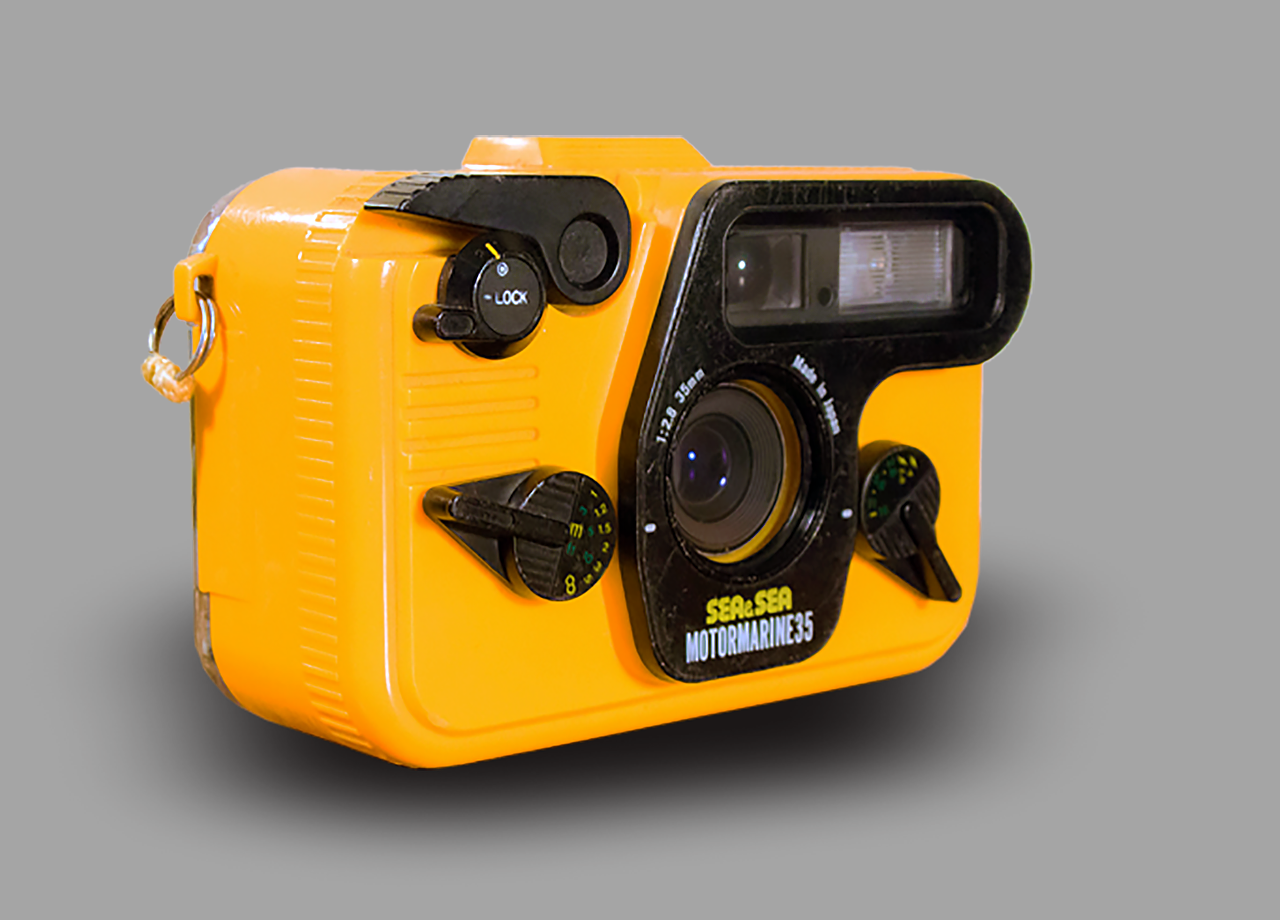
The Motormarine 35 SE is a scale-focusing underwater camera developed in 1983. Its stout yellow plastic housing is claimed to be waterproof to a depth of 45 meters or 150 feet. The “SE” designation was used in Sea & Sea’s advertising and manuals, but does not appear on the camera itself. As the name implies, the camera has motorized film advance and rewind.
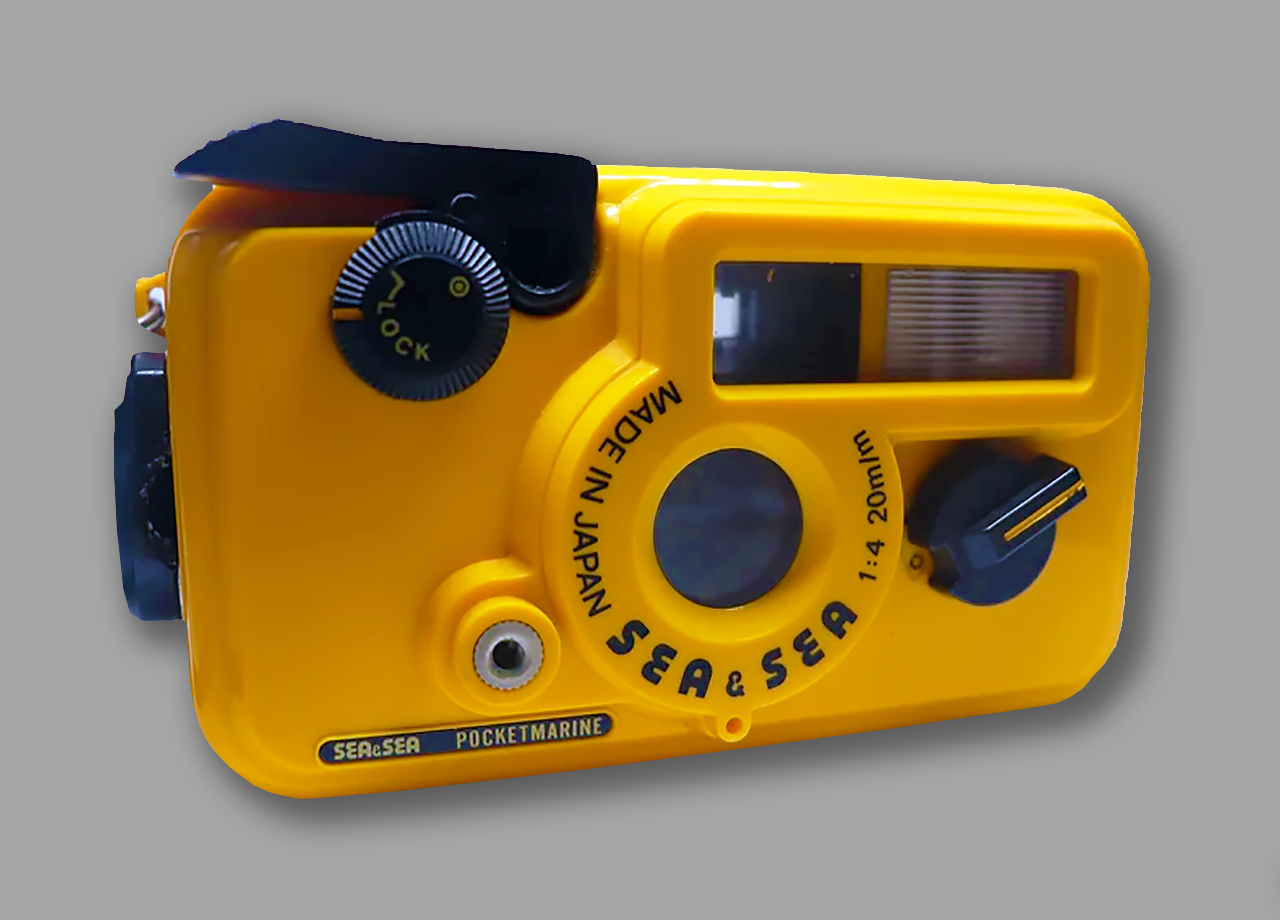
1981 Sea & Sea developed the Pocket Marine 110 SE, the world first motor-driven amphibious 110 camera. Fully waterproof and submersible Uses 110 film Uses two AA batteries. 20mm – 1:4 Lens.
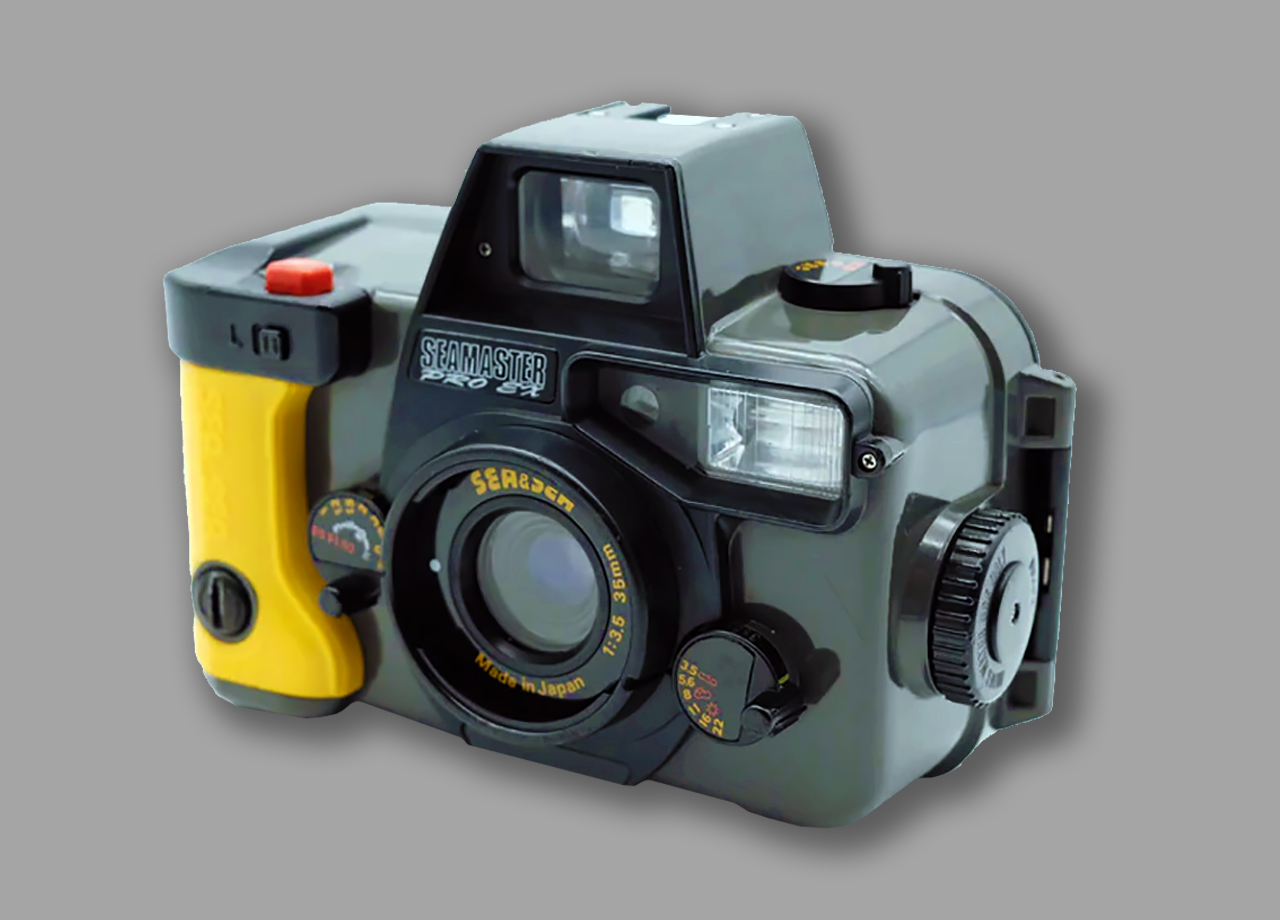
Fully automated amphibious camera, 35mm fixed lens w/extra 16mm wide lens, 3T Macro, TTL and manual operation. Can be used both underwater and on land. Built in close up lens. Bayonet mount so lenses can easily be changed underwater. Has been successfully used at 300ft. The Sea & Sea Motormarine EX II has an automatic winder motor which is useful when you’re underwater.
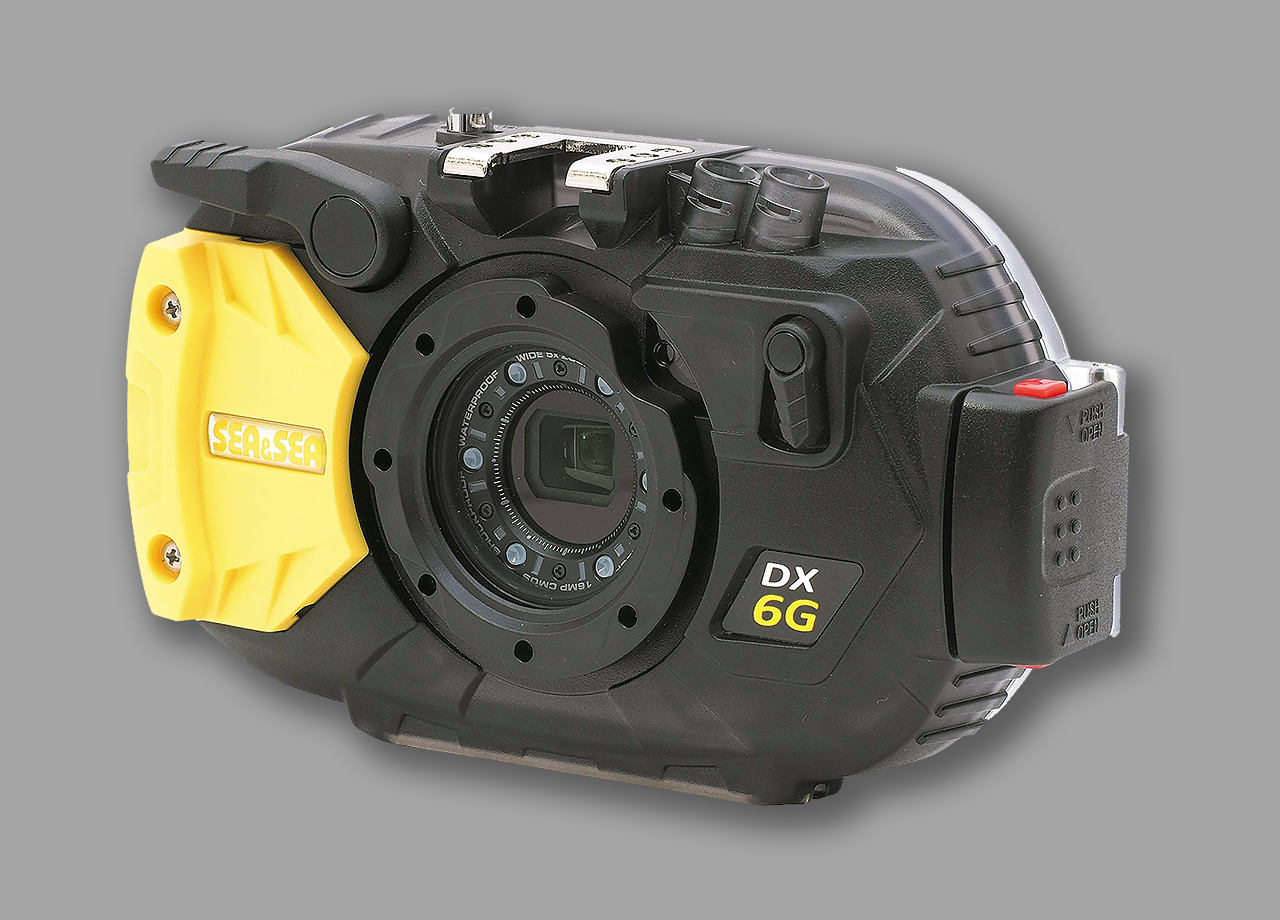
The Sea & Sea DX-6G is a rugged all-weather sports camera combined with underwater housing. The camera is packed with lots of great features for underwater applications, including dedicated underwater and macro modes. With the underwater housing, the camera can be brought down up to 180ft. The camera will also function at temperature as low as -10℃/14°F.
FOUNDING DATE: 1958
FOUNDERS: Unknown
COMPANY NAMES:
1958: Shanghai Camera Factory; 1968: Seagull; 1978: Shanghai General Camera Factory; 2000: Shanghai Seagull Camera Co.,Ltd.
COMPANY ADDRESS:
1958: Shanghai, China; 1978: Songjiang County (now the Shanghai suburb of Songjiang)
Seagull is China’s oldest and largest camera brand, having reportedly manufactured over 21 million cameras since its founding in 1958.
Seagull (Hai Ou = seagull in Chinese), founded in 1958, is the nation’s oldest camera maker. The factories were situated in the Shanghai region, and simply named Shanghai Camera Factory No.1, No. 2, No. 3, … etc. In the literature they are collectively referred as “the Shanghai Camera Factory”.
Initially, the Seagull cameras were called “Shanghai”, but in order to meet export regulations, they were renamed Seagull in 1968. Perhaps Seagull is most widely known for their fascinating Shanghai 58 rangefinder camera, based on the Leica IIIa, which evolved with some modifications borrowed from Canon and FED.
In the days of food and entertainment shortages, a Seagull camera was a luxury item. The Seagull 4A sold for 230 RMB and the Seagull 4A-1 for 290 RMB, whereas a worker earned only 20 RMB per month. Therefore, the camera was really unavailable to ordinary people, and only those who worked for the government and press could afford one.
The product line of the Seagull company included TLR cameras, SLR cameras, folding cameras, CCD and SLR camera lenses, large-format cameras, film, night vision scopes, and angle viewfinders. Seagull’s cameras usually used basic, time-tested mechanical designs that require no batteries.
In 1978, several of the factories relocated a bit further away from central Shanghai and formed the Shanghai General Camera Factory in Songjiang County (now the Shanghai suburb of Songjiang). They manufactured copies of Minolta cameras due to their relatively simple construction as medium format cameras began to fall out of fashion in favour of smaller 35 mm models. Later the cameras were produced with licence from Minolta.
Some SR mount lenses of Seagull’s own brand Haiou were made too. There are also a range of Seagull 35mm rangefinder models, as well as a range of Seagull folding roll film cameras typical of the immediate post war European production.
The famous Seagull-4 series
The Seagull-4 series of TLR cameras, introduced in 1964 and distributed worldwide, was a continuation of the earlier Shanghai TLR; itself quite possibly produced using outdated Japanese tools and manufacturing equipment. These cameras are usually found with knob wind, but the Seagull 4A has lever wind.
The Seagull 4A is the second model from 1968. Some Chinese amateurs consider the 4A and the later 4A-1 variants professional, partly because the camera was unaffordable for most Chinese citizens in the 1960s and 1970s.
Seagull 4A-1 from the 1970s and later 4A-1XX models feature Tessar type lenses. Another noticeable feature is the long-awaited hot shoe. The later 4A-1XX models are mainly for selling overseas, hence the absence of Chinese characters is no surprise.
The Seagull 4B and 4B-1 are simplified models of the 4A. The 4B-1 may take 645 formats. The focus screen of 4B-1 is a Fresnel lens, achieving bright viewing. Unlike 4A, the original lenses for 4B and 4B-1 are three-element triplets. The Seagull 4C can load 135 films. However, this model is very rare.
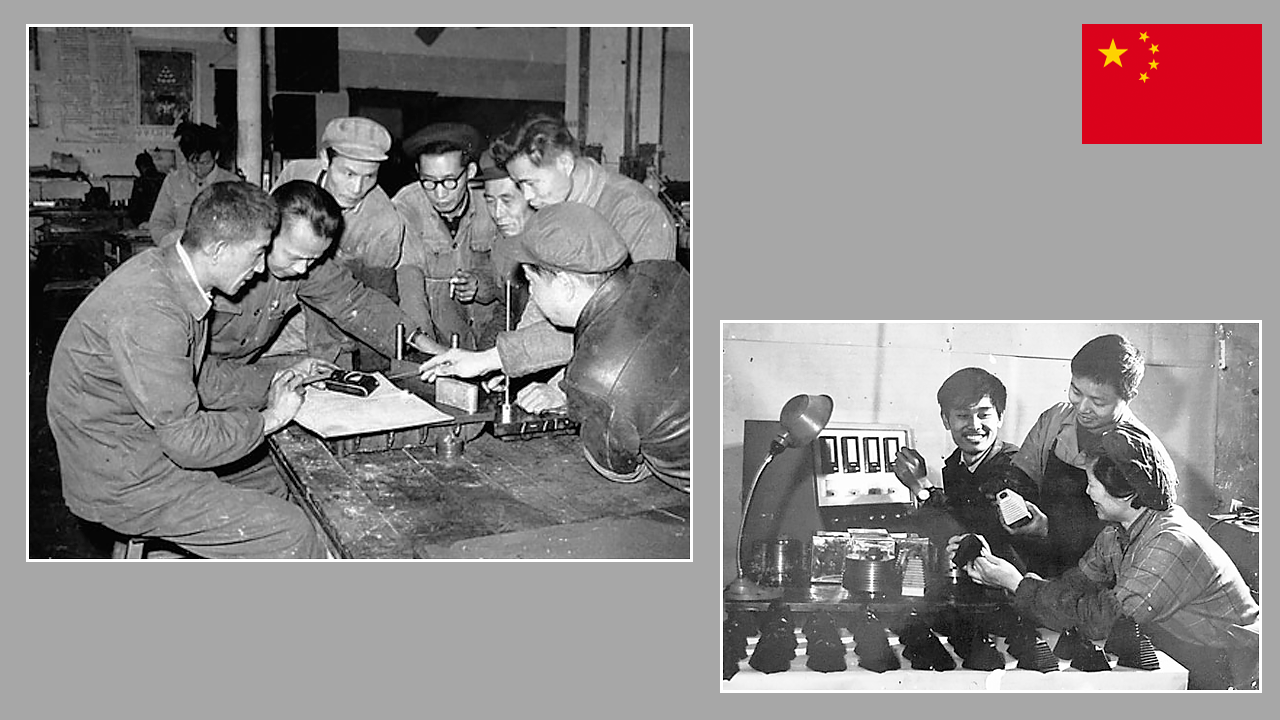
Historic photos from the Seagull factory show workers assembling the much sought-after cameras.
Photo provided to Shanghai Star
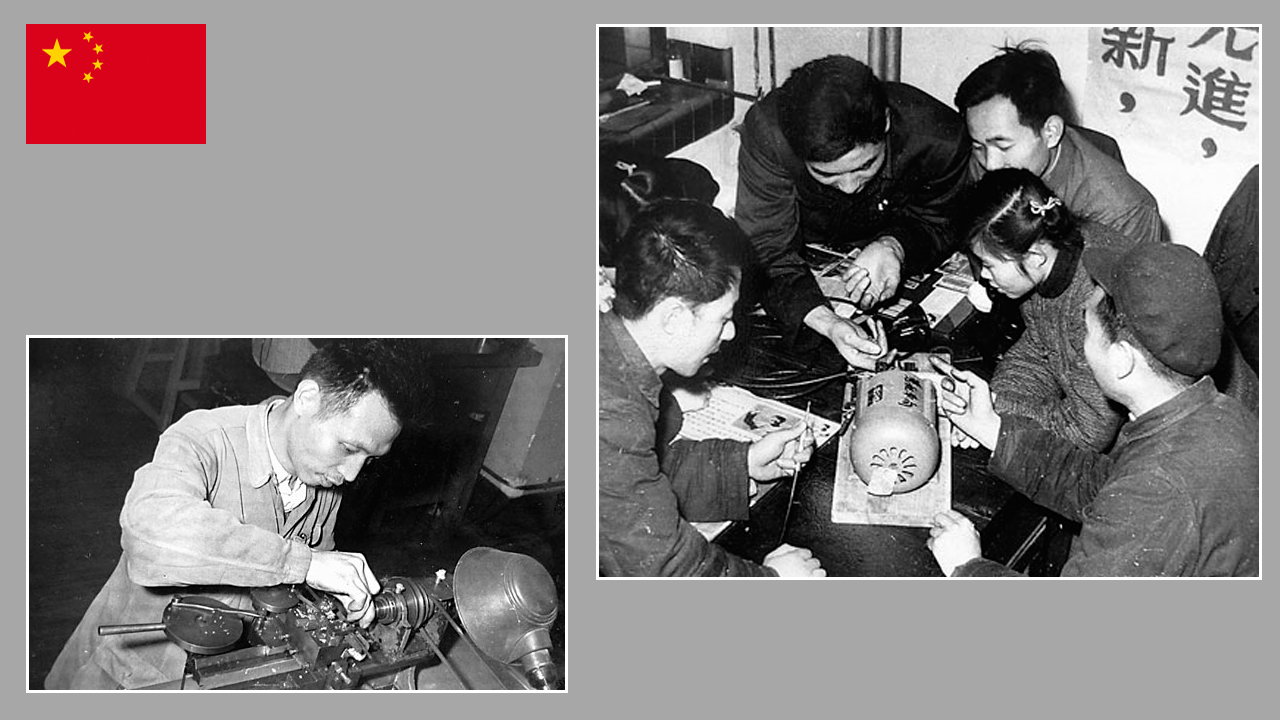
Historic photos from the Seagull factory show workers assembling the much sought-after cameras.
Photo provided to Shanghai Star
A new factory
In 1976 three of the Shanghai camera factories moved together into the new factory Shanghai General Camera Factory in Song Jiang County. The 35mm SLR series Seagull DF- was continued there.
The Seagull CL-A light meter was made in the Shanghai No. 2 Photographic Equipment Factory. Several Seagull camera accessories are known, for example the electronic flashgun SG-100 and several accessory angle finders for SLRs.
The 1980s was the peak of Seagull cameras popularity, and in 1989 alone, the company’s revenue reached 1.5 billion Yuan ($244 million. In 1999 600.000 units (cameras and lenses) could be produced per year. In 1999 600.000 units (cameras and lenses) could be produced per year. In 2001 Seagull planned to produce digital cameras for Kodak.
In 2004, when Seagull stopped making cameras, it had already produced and sold 20.66 million cameras. Between 2004 and 2010, the camera maker experienced a period of downturn, and it became a camera parts producer for Japanese brands.
Restart of the Seagull
After ownership restructuring in 2009, the leadership of the company decided to undertake a branding overhaul. More than 100 million Yuan was invested into research and development over five years with an 80-plus member team in Shanghai and Shenzhen, Guangdong province.
The time-honoured brand launched its first independently developed digital camera, CK 10, on August 15. The new camera model, available in black or brown, is designed for amateur photographers and features several special modes for taking photos such as baby mode, children’s mode, family mode and so on.
And the comeback of the company has already been proven to be a success, with more than 240 new Seagull digital cameras being sold within 40-minutes on a TV shopping program on Dongfang CJ in August.
On June 10, 2012, Shanghai Museum of Old Camera Manufacturing opened to the public. The museum features historic items of the company, most noticeable the production line of Seagull 4A and collections of more than 200 cameras.
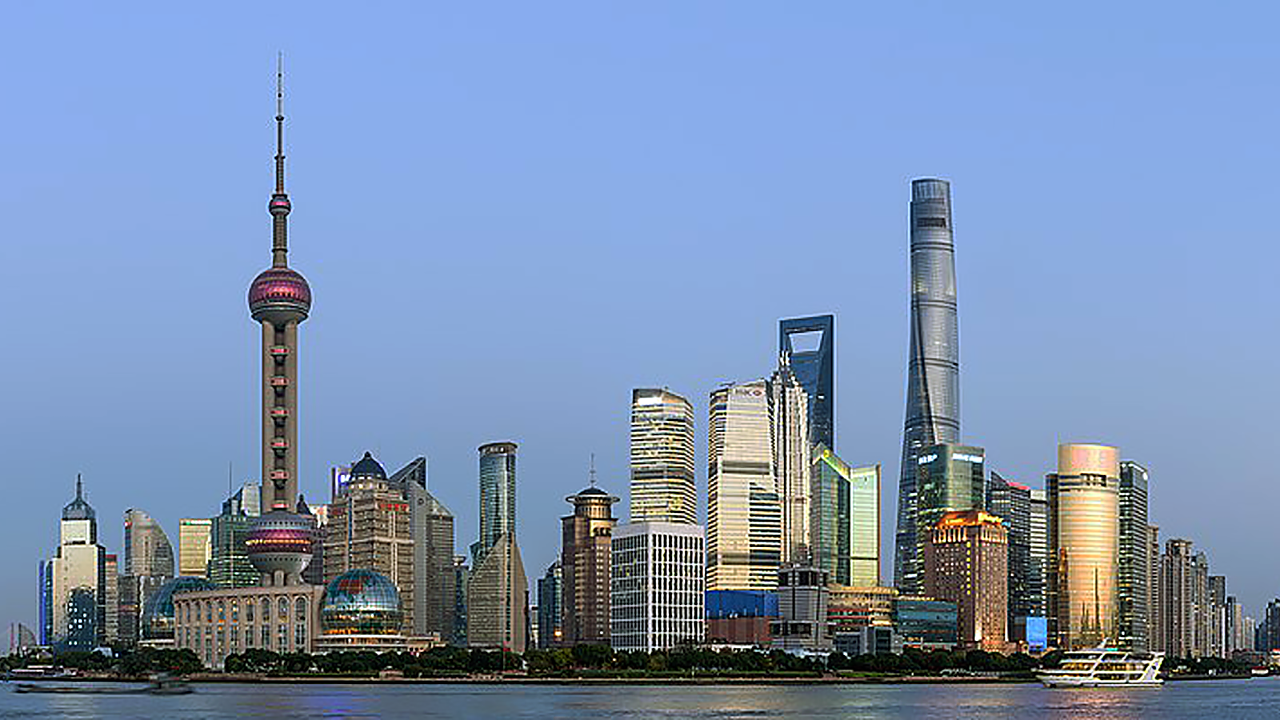
View of Lujiazui skyline from Puxi Pudong Shanghai, November 2017.
comprehensive survey of SEAGULL cameras
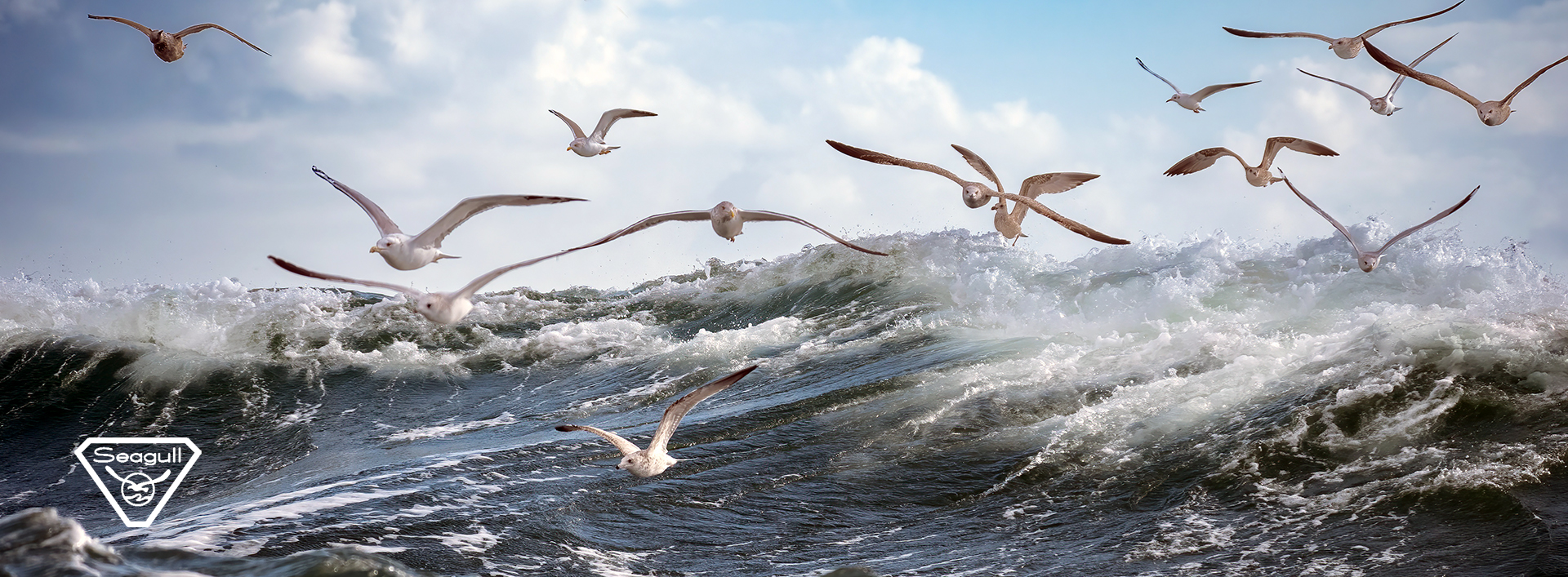
Folder
- Seagull FCL810-A
- Seagull HZX45-IIA
- Seagull HZX57-IIAT
- Seagull 202
- Seagull 203 (6×6 + 4.5×6 rangefinder)
- Seagull 203-I (6×6 + 4.5×6 rangefinder)
- Seagull 203-H (6×6 + 4.5×6 rangefinder)
TLR
- Seagull 4 – A copy of the Shanghai TLR, originally called the 58-III.
- Seagull 4A – Improved on the Seagull 4 by offering a crank type film advance.
- Seagull 4A-103
- Seagull 4A-105 – 1-1/300sec shutter speed.
- Seagull 4A-107 – 1-1/300sec shutter speed.
- Seagull 4A-109 – 1-1/500sec shutter speed.
- Seagull 4B – An inexpensive version of the Seagull 4A, using a ruby window in place of an automatic film advance.
- Seagull 4B-1 – Like the Seagull 4B except for inclusion of a Fresnel screen making it easier to focus.
- Seagull 4B-2
- Seagull 4C – Like Seagull 4B except for a modification to optionally use 135 film
- Seagull 4D
35mm rangefinder
- Seagull KJ-1
- Seagull KS Automatic Aperture
- Seagull 9
- Seagull 209
- Seagull 208
- Seagull 206 (half-frame 35mm)
- Seagull 205A
- Seagull 205 / Phenix 205
35mm slr
The 35mm camera bodies of Seagull were made with Minolta’s SR-lens-bayonet. In addition to the cameras listed below Seagull produced similar products for other camera companies.
- Seagull DF-5000
- Seagull DF-2000A
- Seagull DF-2000
- Seagull DF-1000
- Seagull DF-500
- Seagull DF-400G
- Seagull DF-400
- Seagull DF-300G
- Seagull DF-300E
- Seagull DF-300M
- Seagull DF-300X
- Seagull DF-300A
- Seagull DF-300
- Seagull DF-200A
35mm slr (continued)
- Seagull DF-200
- Seagull DF-100
- Seagull DF-102b
- Seagull DF-99
- Seagull DF-98
- Seagull DF-3
- Seagull DF-2 ETM
- Seagull DF-2
- Seagull DF-102b
- Seagull DF-1 ETM
- Seagull DF-1
- Seagull DF
other
- Seagull 3D 120-III camera
- Seagull 501 (35mm viewfinder camera)
- Seagull DFAB (finderless laboratory cameras)
- Seagull 130 MF panorama camera
- Seagull ZQ 6-35 (360 degree swing camera)
large format
- Seagull HZX45-IIA 4×5″ view camera
- Seagull 4½x6½ inch” view camera
digital
- Seagull DC-33 – 1998 (Agfa ePhoto 780, Polaroid PDC-640)
- Seagull DSC-1100 – 1999
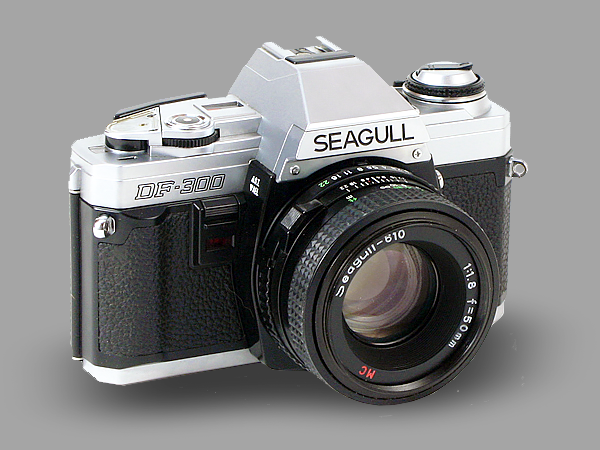
The Seagull DF-300 is a 35mm SLR camera body with Minolta SR-bayonet mount. It can be used with some lenses which are made for Minolta’s manual focus SLRs. On the back it is marked “Shanghai China, licensed by Minolta”. It’s a licensed copy of Minolta’s X-300 which was produced in the same Shanghai General Camera Factory.
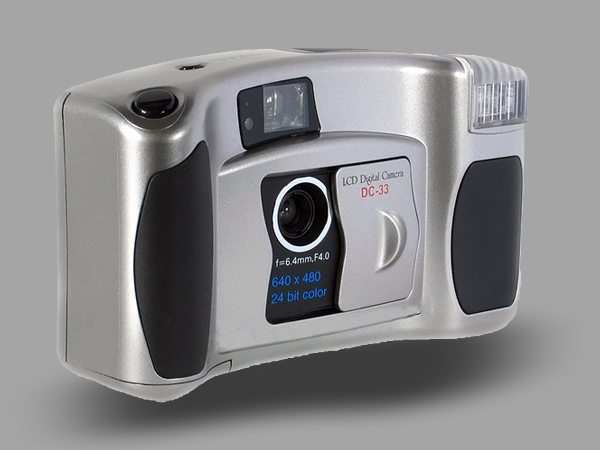
The Seagull DC-33 digital camera was born two years earlier in 1998. It was born as a gift for the 40th anniversary of Seagull (1998), and was brought to Beijing to participate in the 20th Anniversary of Reform and Opening Up. It was only officially put into production in 2000.
FOUNDER: Fritz Kaftanski
COMPANY NAMES:
1927: Fotofex Kameras; 1934: Minifex GmbH which was liquidated in 1936; 1934: Sida GmbH; 1935: British Sida Cameras, Ltd.; 1938: Sida-Fex-Kameras; 1945: Etablissements Kafta (Ets. Kafta); 1951: Societé de Distribution d’Appareil Kafta (SODIKA); 1955: Société Nouvelle d’Optique et de Photographie SA (SNOP); 1956: take-over of SNOP by SECAM (Société d’Etudes Constructions et Applications Mecaniques); 1958: Miniphot.
COMPANY ADDRESSES:
1927: Königgrätzer Street 82, Berlin; 1934: Minifex GmbH Kurfürstendamm 173/74, Berlin.
 Sida and Fotofex were two companies, which were more or less two sides of a coin. This camera history begins with the Fotofex company and transitions smoothly into the emergence of the Sida company. Sida also produced its cameras in several other European countries.
Sida and Fotofex were two companies, which were more or less two sides of a coin. This camera history begins with the Fotofex company and transitions smoothly into the emergence of the Sida company. Sida also produced its cameras in several other European countries.
FOREPLAY
 What follows is the eventful and confusing history surrounding himself, the companies and the products of Fritz Kaftansky.
What follows is the eventful and confusing history surrounding himself, the companies and the products of Fritz Kaftansky.
Fritz Kaftanski was born on 10 November 1899 in Essen am Ruhr (Germany) as son of Julius Kaftanski and Julie Kaftanski-Kehr. The religion of his parents was Jewish.
From 1902 to 1912 was the family living in Düsseldorf. Fritz’ father was “Kaufmann” (merchant), a common profession for Jews in those days.
The kind of businesses in Düsseldorf varied from import and export, agency-trade, a mail-order firm of dentist-equipment to the fabrication and trade of novelties, armoury, gas burners and refrigeration equipment.
Berlin period
In November 1927 Fritz Kaftansky started a camera factory called Fotofex Kameras, with financial aid of his father. The aim of the firm was the manufacture and trade of photo-cameras and accessories. Fritz was the only owner of the firm, which was registered at the Königgrätzer Street 82. The building had 2 office-rooms, 1 workshop and 1 storeroom, where 3-5 employees were working, including 1 commercial employee and 3 sales representatives. Camera parts were bought from specialised manufacturers and Fritz himself assembled the cameras.
Four types of cheap wooden box cameras for plates saw the light there, namely:
- the WERBEFEX wooden box camera for 4.5 x 6 cm, 2 DM
- the REKORD-FEX wooden box camera for 6.5 x 9 cm, 3.85 DM
- the ROLLFEX, a 4.5 x 6 cm wooden box camera for rollfilms, 6 DM and the
- KLAPPFEX, a folding wooden box camera for 4.5 x 6 or 9 x 12 cm, 25 DM.
Conclusion: Fotofex was nothing special, there were more similar firms, making similar cameras.
But there was a substantial difference: Fritz, so Fotofex, approached photography in his own way. He wanted to offer mass access to photography with cheap cameras and accessories. For comparison: the cheapest plate camera from Balda at that time cost 5 DM (Fotofex 2 DM) and a roll film box 10.50 DM (Fotofex 6 DM). Furthermore Fotofex sold cassettes, plates, films, printing frames and chemicals for a really low price.
Furthermore, Fotofex had special promotion methods, like price-contests and distributing leaflets at the school-gates, so there was a lot of talk about the Fotofex-cameras.
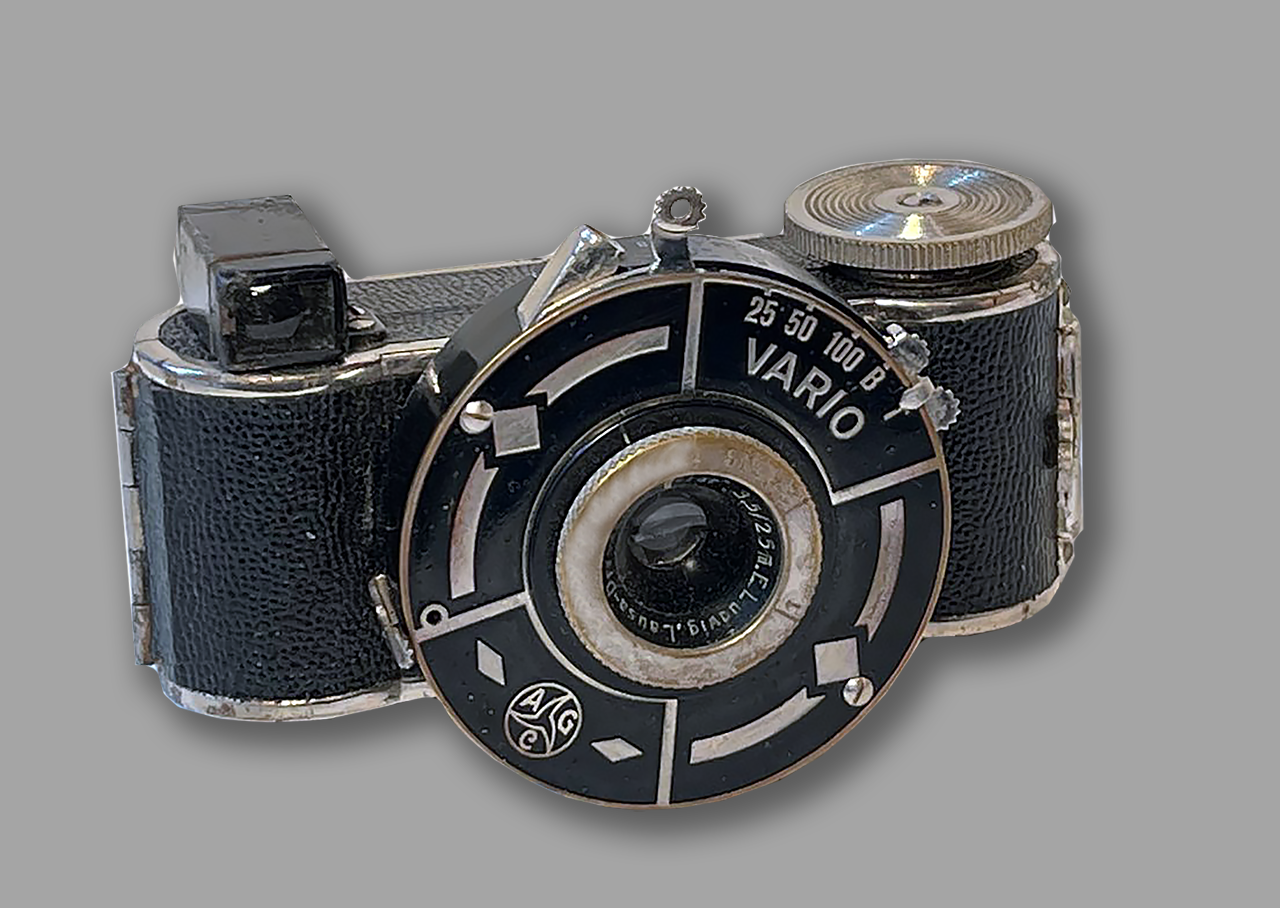
The Minifex is a subminiature camera made in the 1930s. The Minifex camera has a very small body, with knob advance and rigid optical finder. It makes 36 13x18mm pictures on special 16mm film (Mimosa film) with back paper.
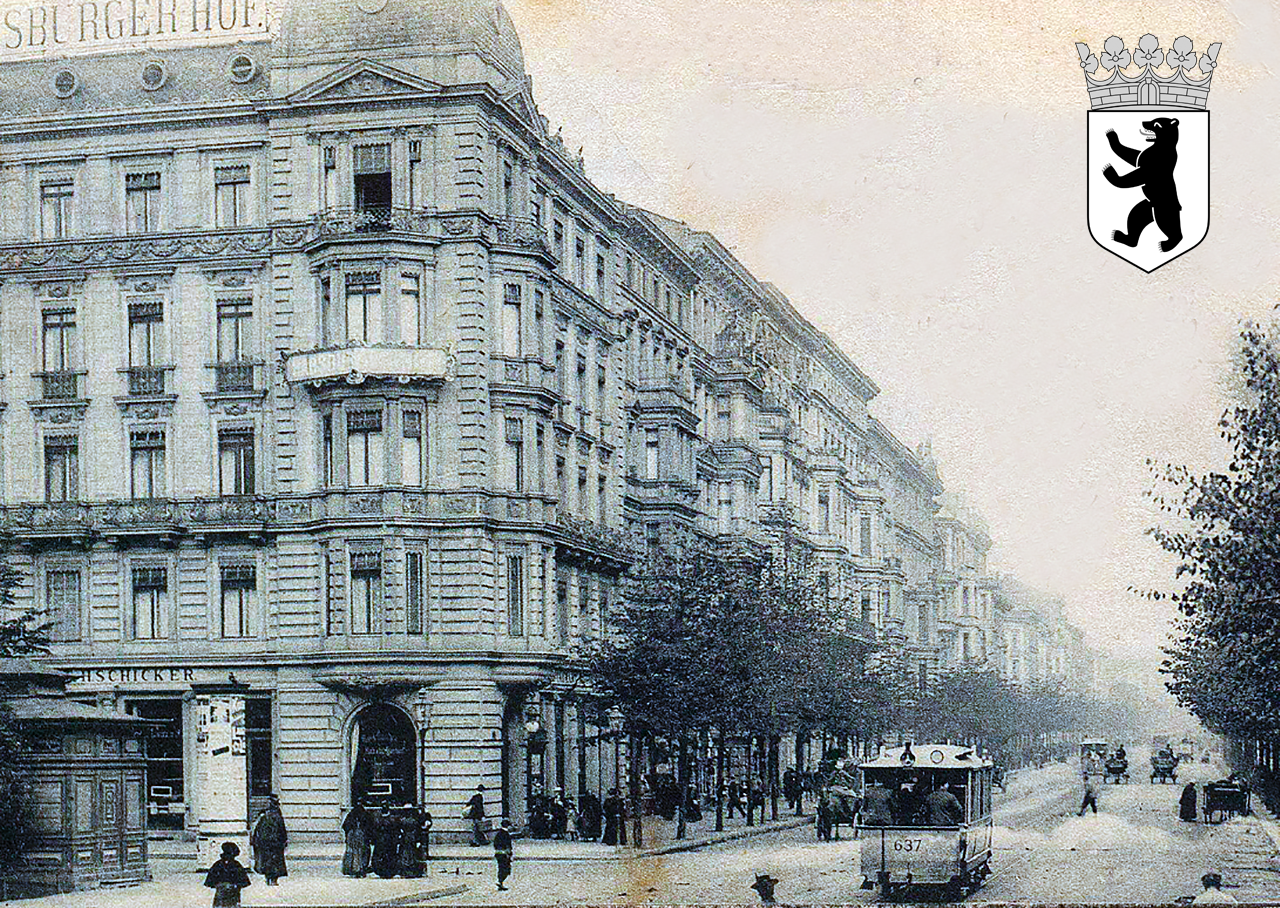
Königgrätzer Street Berlin (today Stresemann street).
New products
In the spring of 1931 Fotofex-Kaftanski introduced on the Leipziger Messe a new, so-called “Seeing-camera”, the VISOR-FEX, a folding rollfilm-camera focusing on a ground-screen. This combination of plate- and rollfilm camera was not new, but it was the only one available in that period.
Also in 1931 two other cameras were introduced, the FEXOR and the PARLOR-FEX. The FEXOR was an all-metal, rollfilm-box for 16 exposures 3 x 4 cm on 127 film. The price of the FEXOR was again extremely low: 4.50 DM! The PARLOR-FEX is a folding camera for rollfilm that gives a (visual) warning as long as shutter and diaphragm are not adjusted. These two cameras got less attention in the press.
In 1932 Fritz Kaftanski came up with a camera concept with which he would live up to his name forever: the MINI-FEX. This miniature camera has a shutter and a lens of normal sizes of that period, but it had exceptional small dimensions of the camera-body of about 8 x 4 x 4 cm.
The camera was equipped with various quality lenses, made by Astro of Berlin, a must for this small camera to get negatives of sufficient sharpness. It used special rollfilm for 36 exposures 13×18 mm made by Mimosa of Dresden. Perforated 16 mm cine-film could be used too, while Perutz of Munich made also their Rectapan film in Mini-Fex format as from 1934.
The success of the camera depended strongly on the promotion in the press in which expressions like “Secret-camera” and the “smallest camera in the world” were used. In favour of the concept too, was the low price (0.90 DM) of the film and the big number of exposures (36) on it.
Fritz used less conventional methods of promotion again. He gave a MINI-FEX for testing to Professor Stenger and when the Zoo of Berlin organised a photo-contest he doubled the price if the winning photo was made with a MINI-FEX.
In 1933 Fotofex introduced her top-model: the MINI-FEX with an Astro-Tachon lens of 0.95! It is needless to say that this model got much attention in the press, stating that it was not only the smallest but also the camera with the highest light-sensitivity in the world.
Less attention in the press was put on the fact that the camera with a price of 750 DM was also the most expensive camera in the world. For comparison: the most expensive Leica III was only 275 DM and that was already more than 5 monthly wages of a labourer.
Focusing with such a lens had to be done very exactly. Therefore the separate available Focuskop, a kind of coupled rangefinder, made by Astro of Berlin, was very handsome, but it added another 130 DM to the 750 DM of the camera.
At the end of 1933 a “new” model was patented and introduced, the “Volks-Mini-Fex”, a simple model with a Vario-shutter and a fix-focus Anastigmat 4.5 for only 24 DM. It looks like whether this introduction was a return to the philosophy of cheap cameras, followed by the introduction of the SIDA in the next year. About the same time the export to Great Britain has started, where R.E. Schneider of London, was the importer.
In July 1934 Minifex GmbH is founded. The aim was to make and sell photo-cameras and accessories, especially the MINI-FEX. The managing directors were Karl Gumpel and Fritz Kaftanski. From an advertisement in October 1934 we know the business-address of the company, Kurfürstendamm 173/74. The company took part in the Leipziger Messe of 1935, but in 1936 Astro of Berlin showed their products. On 5 October 1936 it was decided to liquidate the company.
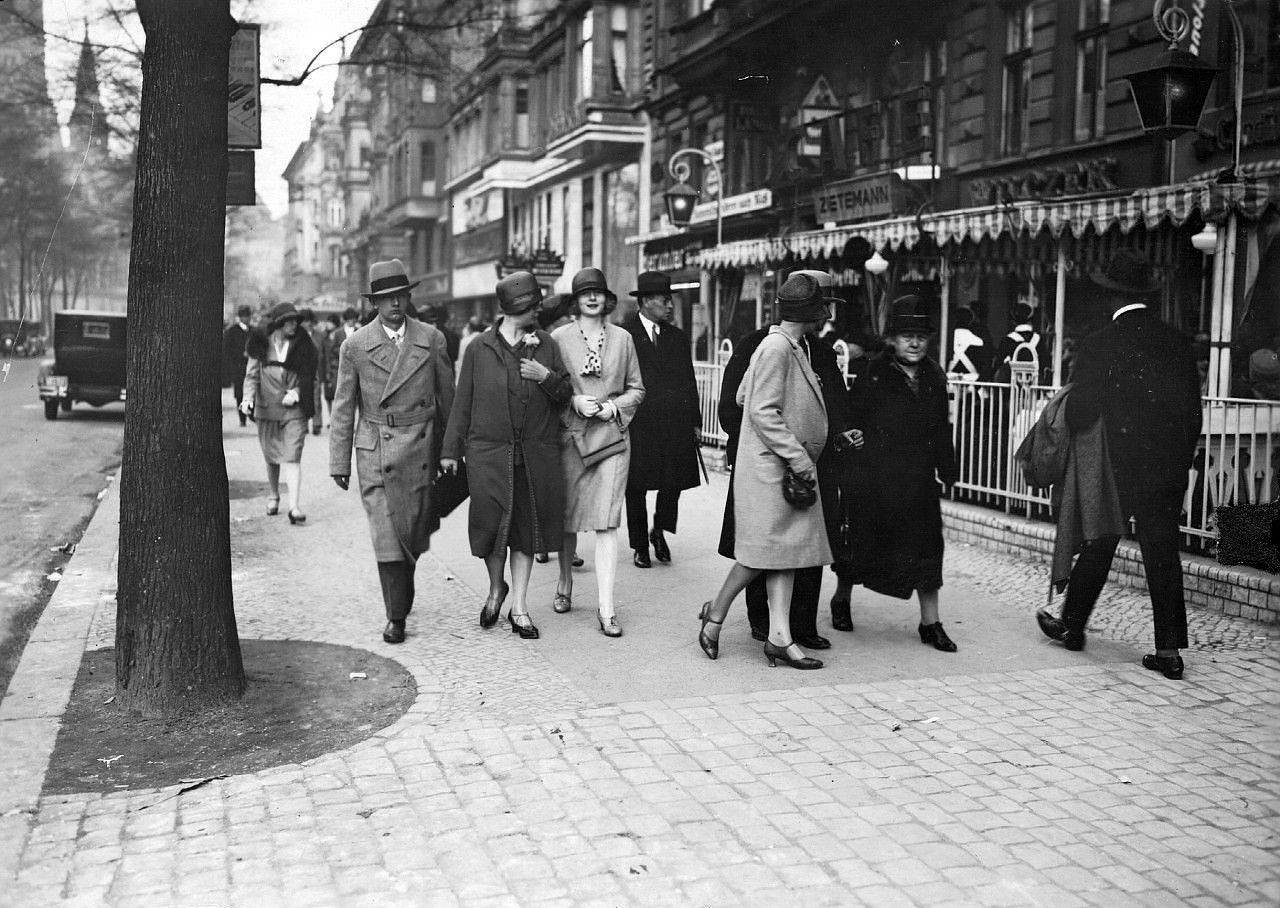
Kurfurstendamm, Berlin, 1930’s.
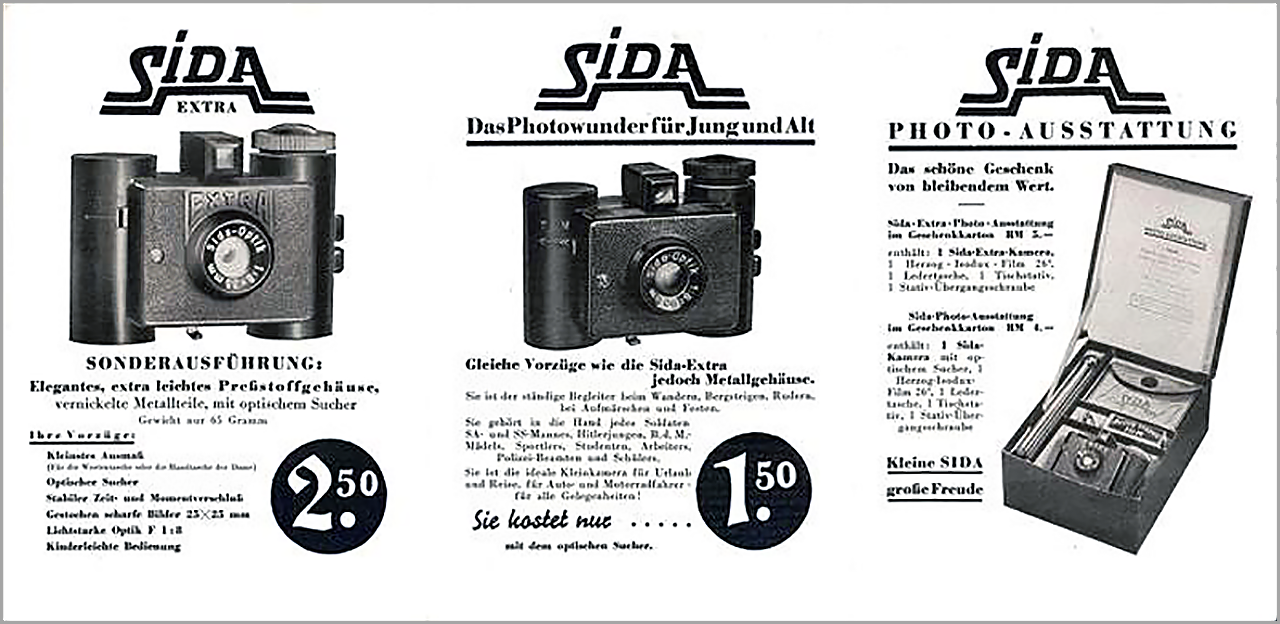
Advertising had always been one of Fritz Kaftansky’s strengths. Here’s an ad from the 1930s for the Sida with multiple options.
On 1 September 1934 another new company was founded, the Sida GmbH. The managing director was Karl Gumpel, the former managing director of Minifex. The name Sida is a contraction of the German “siehe da”, what in English means: Look there!
Remarkable is that the corresponding notarial, dated 1 September 1934 states that the companions Karl Gumpel and Paul Knoche, both taking part for 50%. However an act of the same date states, that Fritz Kaftanski takes over the shares of Paul Knoche on the day of registration of the company! In this way Fritz was not registered in the trade register or was his name published in the legal journal.
The SIDA, his next camera, was mentioned for the first time in the press in August 1935, so the introduction would have been in the autumn of 1934 or at the beginning of 1935.
At least 4 different types of the SIDA camera are known. The first model is made of metal and has the shutter release about below the lens. Type two of bakelite was introduced in August 1935 and got the name Sida-Extra. Type three is an improved metal model with a removable optical viewfinder. The last type is a metal model, sold under the name Standard, and has a shutter release beside the lens.
The company introduced in 1937 the RENA, called in 1938 the TURF, a bakelite folding camera for 4.5 x 6 cm exposures on a rollfilm with special spools. In 1940 the TURF 40 is introduced for 6×9 exposures.
In 1935/36 Kaftanski and Gumpel started to expand their commercial activities outside Germany. In March 1935 they tried to establish in a new limited company in Czechoslovakia, but the Czechoslovak authorities refused the firm. However, the name CS-SIDA is used on trade fairs, in advertisements and in the press, while the name of Kaftanski or Gumpel is never used in public.
They were more successful in England. On 23 December 1935 British Sida Cameras, Ltd. was registered. This company advertised in 1937 with the SIDA for just £5/-.
 In Italy the production of the SIDA-camera was licensed to Guiseppe Pozzuoli of Milan, a factory of bakelite electromechanical equipment. The Italian model has on the front the name SIDA instead of EXTRA.
In Italy the production of the SIDA-camera was licensed to Guiseppe Pozzuoli of Milan, a factory of bakelite electromechanical equipment. The Italian model has on the front the name SIDA instead of EXTRA.
A similar firm existed in Belgium, 11-13 Arenbergstraat, Brussels, also selling SIDA cameras.
Sida cameras are mentioned too as made in the USSR, France, Spain, Poland and even the USA. The examples from the USSR were non-licensed imitations.
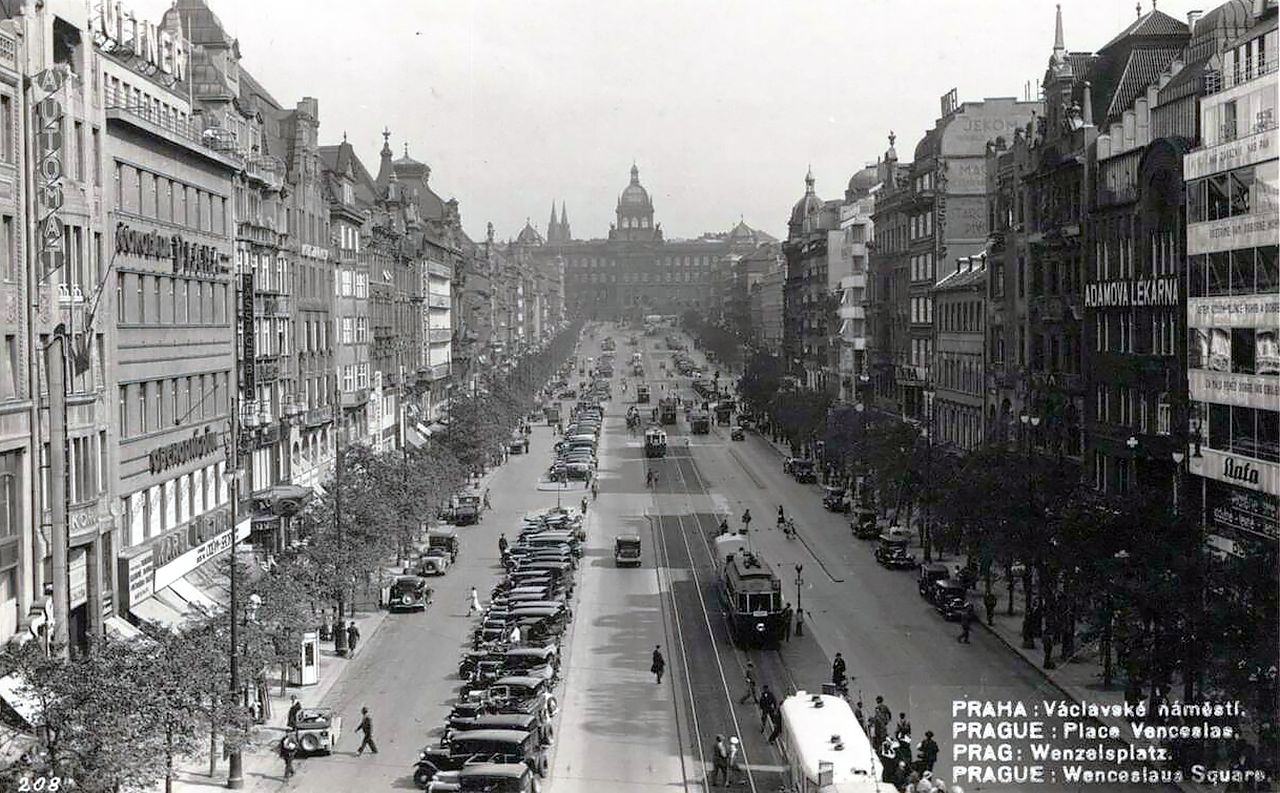
Prague, the Wenceslaus Square 1937.
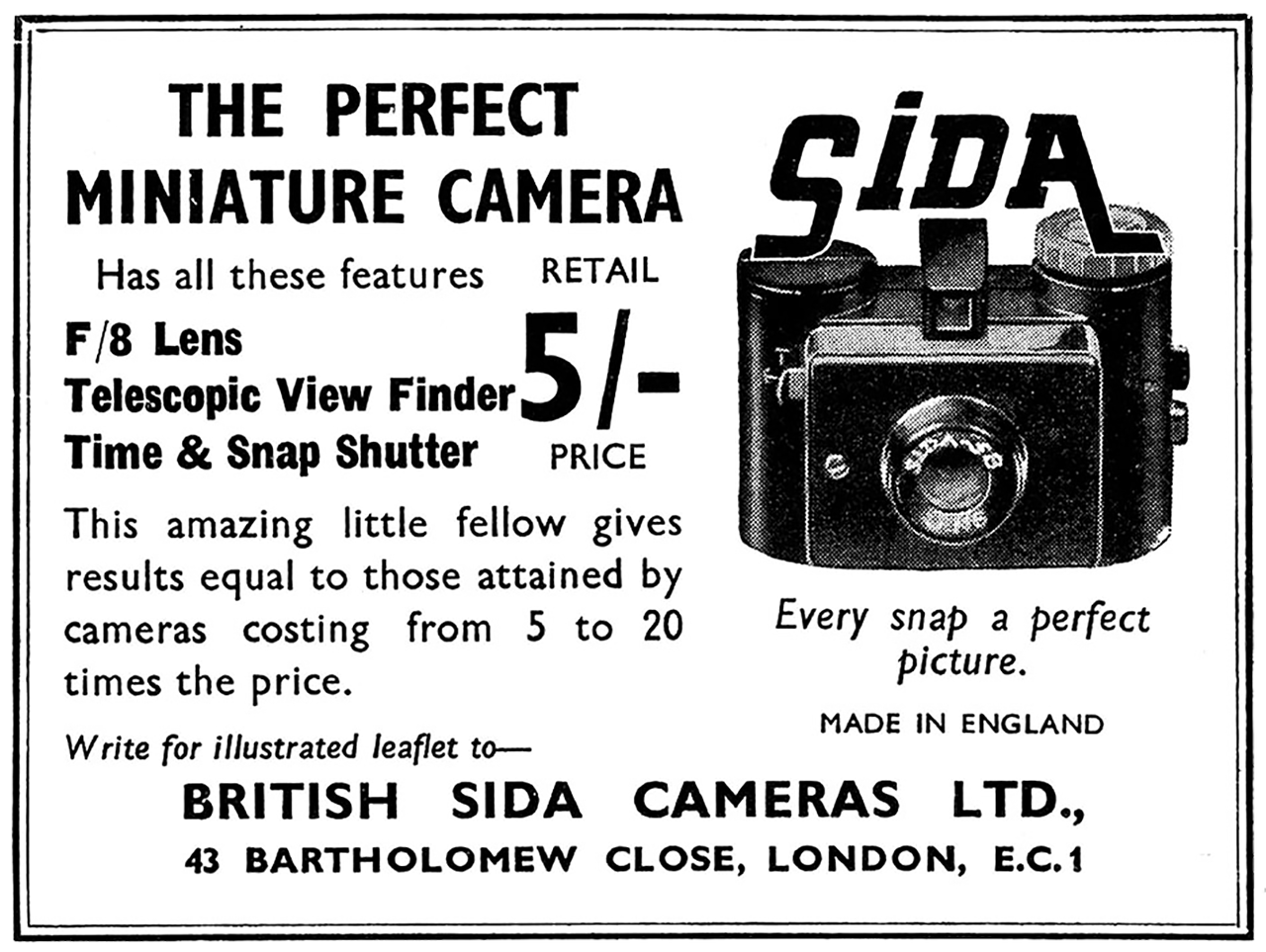
The advertisement mentioned in the text in the UK where the Sida is offered for only £5.
Escaping to Czechoslovakia
The Trade Chamber of Berlin started in December 1937 the procedure to remove Fotofex from the Trade Register, because the firm has been closed and Kaftanski would have been moved to Prague. However, a non-public Czech document states that Fritz and his wife were registered already in August 1936 in Prague. In Prague Fritz started to use the name Bedrýich, the Czech equivalent of the German Friedrich.
 Products introduced by the Czech “firm” are the SIDA camera in April 1935, the MINEX, an enlarger for 24×36 mm in October 1936, the SIDAX, a camera for 4 x 4 cm on special rollfilm in August 1937, and the FEX, a rollfilm camera for 4.5 x 6 cm on 127 rollfilm in March 1938. All made of bakelite and always the cheapest or second or third to the cheapest products of their kind.
Products introduced by the Czech “firm” are the SIDA camera in April 1935, the MINEX, an enlarger for 24×36 mm in October 1936, the SIDAX, a camera for 4 x 4 cm on special rollfilm in August 1937, and the FEX, a rollfilm camera for 4.5 x 6 cm on 127 rollfilm in March 1938. All made of bakelite and always the cheapest or second or third to the cheapest products of their kind.
E.g. the FEX was advertised in Germany by SIDA-FEX-KAMERAS of Prague for 3.50 DM. SIDA-FEX-KAMERAS was the name that Fritz used at that time for his business.
The bakelite SIDA and most probably all products were made by Gummon-Werke, a small firm in Bratislava owned by Jews and producing bakelite with a license of Ford Motor Company of the USA. The sale of FEX cameras was a success. It was available in 2 models, with a bakelite frame viewfinder or with an optical viewfinder.
The information for the period 1939 – 1945 is very scarce; there are nearly no official documents or publications at all. Based on the addresses in his French patent applications it can be concluded that Fritz moved in August 1939 from Prague to France. On 12 December 1939 he lived in France, department Seine (Paris and surroundings).
According to his new French companion, a manufacturer of cleaning agents, Fritz lived around 1942 in Lyon. Fritz convinced this companion to start with the production of popular photo cameras. This was almost impossible in 1942, but Fritz showed once more that he was able to produce a working camera with little, the COMPA-FEX.
It was a simple box camera for 4×6.5 cm exposures, made of thin wood and covered with black paper. It had a plastic frame viewfinder. The biggest problem was to find suitable lenses, but Angenieux provided them. Angenieux did not wanted his name related to the COMPA-FEX, because of its appearance, so the engraving on the lens was painted black.
On 21 March 1945 Fritz (now going through life with the French version of his name Frédéric) married in Lyon Yvonne Chedepeau, born on 15 May 1904. In the same year the couple moved to Nogent-sur-Marne (near Paris) and before 1948 to Paris where they lived at least until 1970 at 17, Avenue de Friedland in the 8th arrondissement, not far from the Champs-Elissee and the Arc de Triomphe.
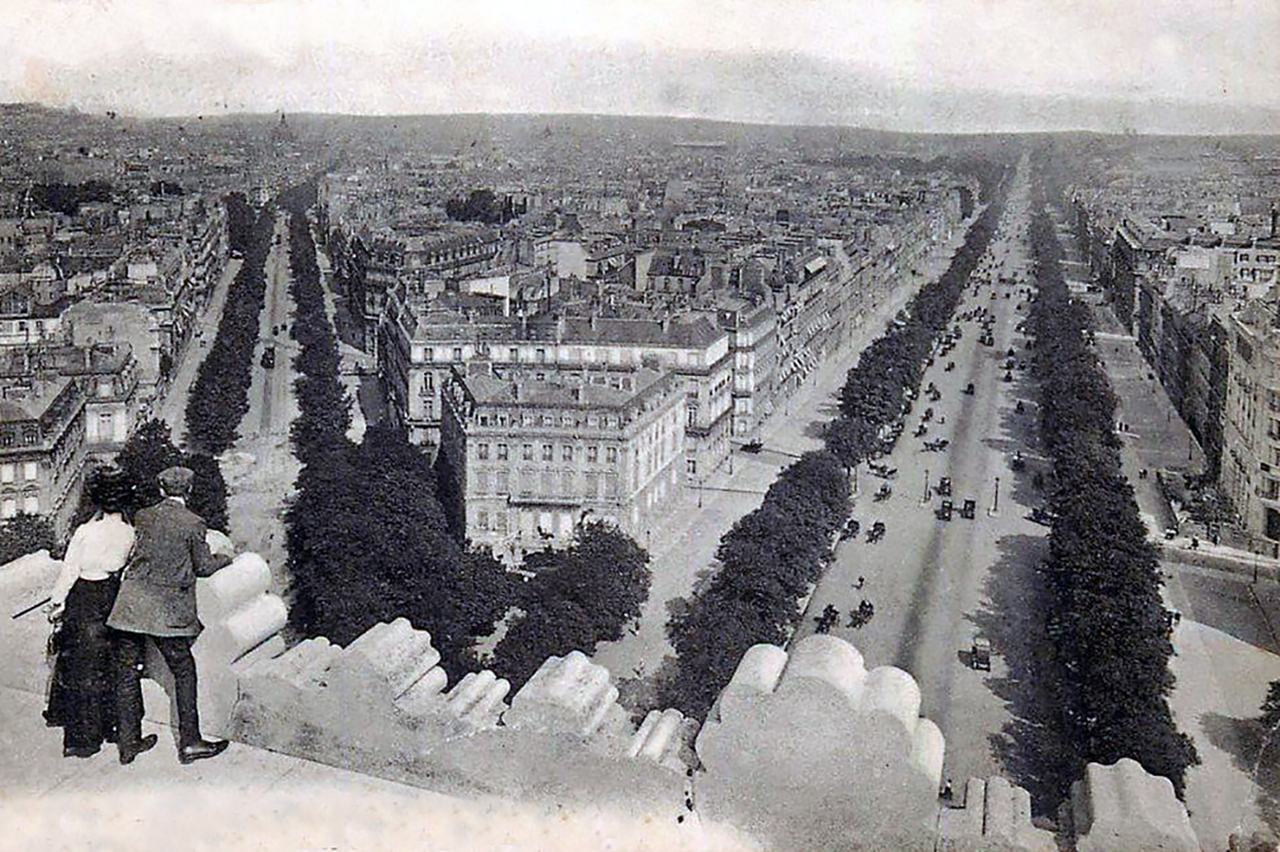
Panorama taken from the Arc de Triomphe, Paris on Avenue Friedland and the Champs Eliseés.
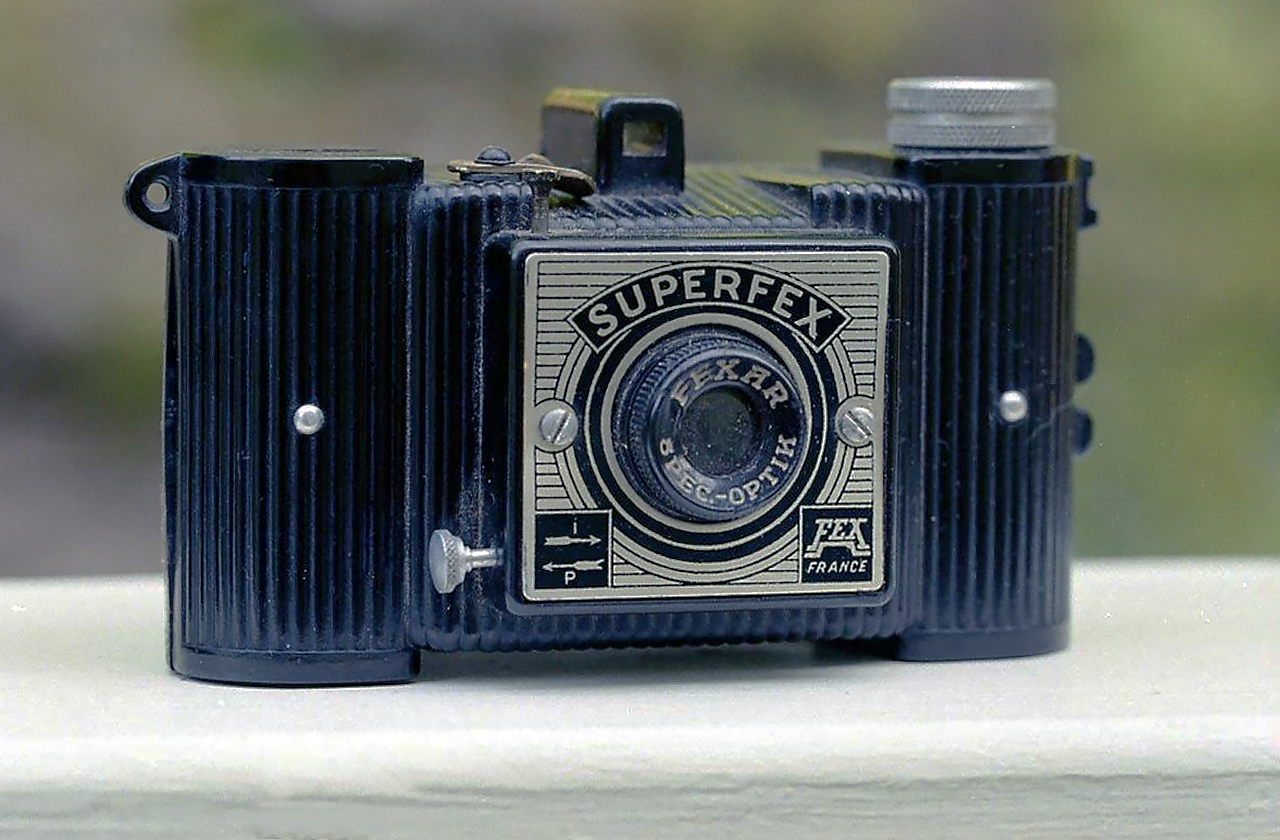
The Superfex (1945) was a small size format, 4 x 6.5 for 127 film. Its shutter has a single speed (1/30 sec) and time exposure . Its lens is a meniscus .Its career was quite long, from the end of the Second World War until the mid- 50s. Several versions were produced . This version has, as all the first versions, a flat viewfinder, the attachment of the decorative plate by screws with slotted heads and a lens -Optik Fexar Spec ( K is important). The knob used for the winding of the film is knurled with a dual strip . The shutter button has a conical shape. The back of the body is held by pressure.
And again a new company
On 5 May 1945 a new company is founded in Paris, “Etablissements KAFTA (Ets. KAFTA)”. Companions are Frédéric Kaftanski and the owner of the Lyon factory. After the problems with the moulds of the FEX-camera were solved, the production of the FEX started. The first product advertised in the spring of 1946.
 It was renamed SUPERFEX in 1947 and improved by another closing mechanism and film-spool holders. Accessories for the SUPERFEX were a yellow filter, a portrait lens and a carrying case. The camera was produced in Lyon until 1957. During the production, details were changed, so one can find at least 6 different variants made in France.
It was renamed SUPERFEX in 1947 and improved by another closing mechanism and film-spool holders. Accessories for the SUPERFEX were a yellow filter, a portrait lens and a carrying case. The camera was produced in Lyon until 1957. During the production, details were changed, so one can find at least 6 different variants made in France.
A Turret optical exposure meter, the TEMPOR and a simple exposure meter for box cameras, the IRIS were introduced. Turret was the manufacturer of the lenses for the FEX too. Finally a new invention of Frédéric was shown on the Salon de Paris, the PROJECTA-CAMERA, a combination of movie-camera and -projector, today a very rare collectors item.
The ULTRA-FEX is introduced in 1948, a bakelite rollfilm camera for 6 x 9 cm with a rectangular tubus, but with the same shape as the SUPERFEX. The ULTRA-FEX was made up to 1963 in different variations and also for other firms.
And again, a change of management
Around the beginning of 1949 there is a financial conflict between Frédéric and his partner of Lyon. On 19 December the legal connection between Frédéric and this partner terminates when Frédéric bought out his partner. A new partner took over 5% of the company and Frédéric the other 95%.
In December 1949 the SIDAX was introduced and the KAFTAX begin 1950. The first is an improved SIDA using existing rollfilm Lumière No 1. It was sold with a wristband, under the name “Photo-Bracelet”.
The KAFTAX is a simple, bakelite camera for 6 x 9 cm on rollfilm with a fixed-focus lens with a similar style as the PHOTAX, but with a fixed tubus. It has a curved film plane. Ets. Kafta sold also a slide projector made of aluminium called DIAX for 24 x 36 mm slides. In 1954 the DIAX projector was modified and renamed FÉERIE.
Sodika
On 28 Augustus 1951 the Societé de Distribution d’Appareil KAFTA (SODIKA) was founded. The aim of the company was to sell photographic, cinematographic and television equipment, especially items made by Ets. KAFTA. Mrs Kaftanski was one of the companions with 399 of the 600 parts and Mr Jean Roux was managing director.
In 1952 an improved model of the KAFTAX was introduced and a viewer called DIASCOPE. The viewer could be used in daylight to see microfilms and colour slides projected as well on a ground screen of 15×15 cm as on a wall.
In May 1952 the sale of the KAFTAX cameras was transferred to the Tiranty-company, while the name of the camera was changed to BANCO. Tiranty sold the cameras, namely the BANCO, the BANCO LUX, the BANCO PERFECT and the BANCO SPECIAL up to the end of 1955.
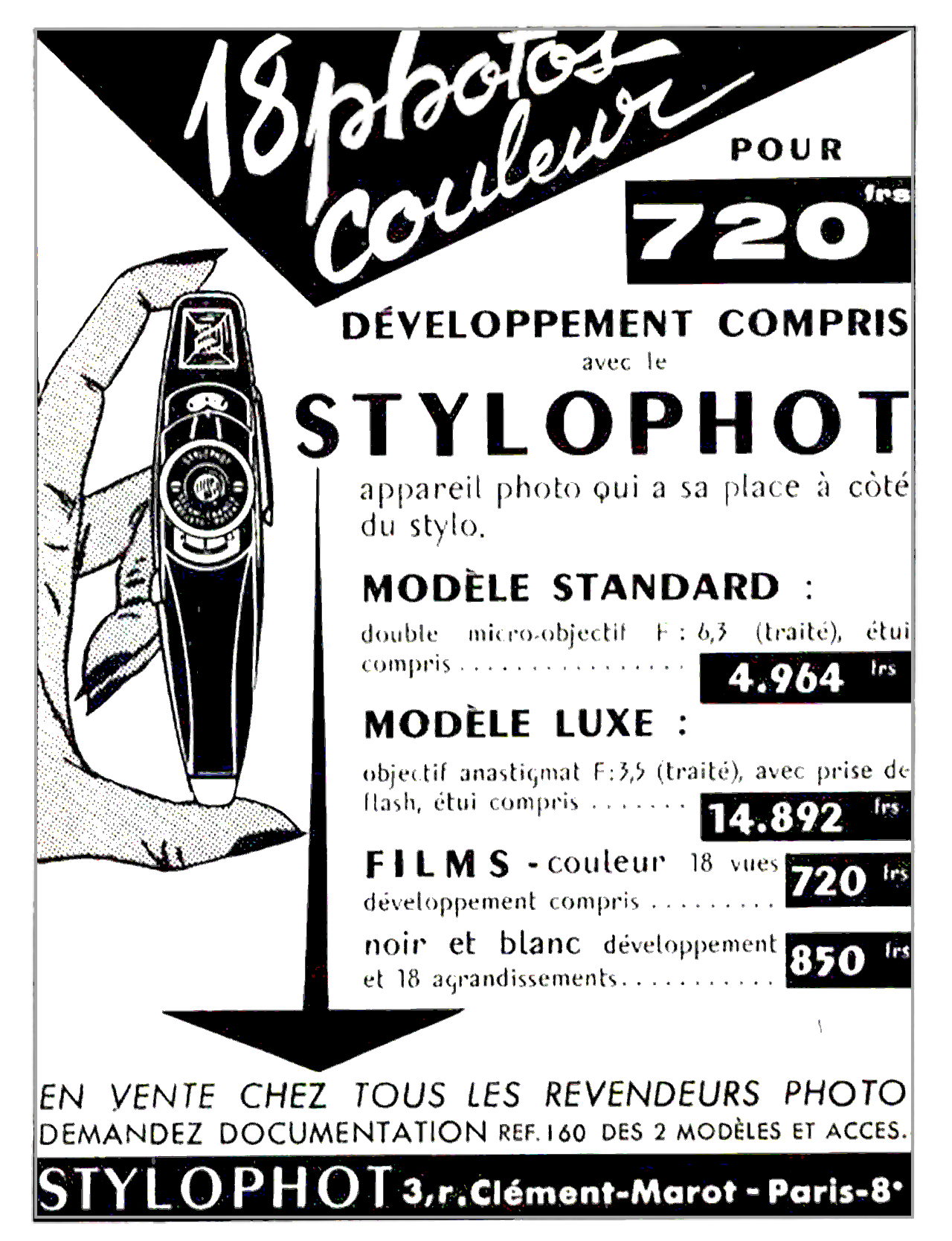
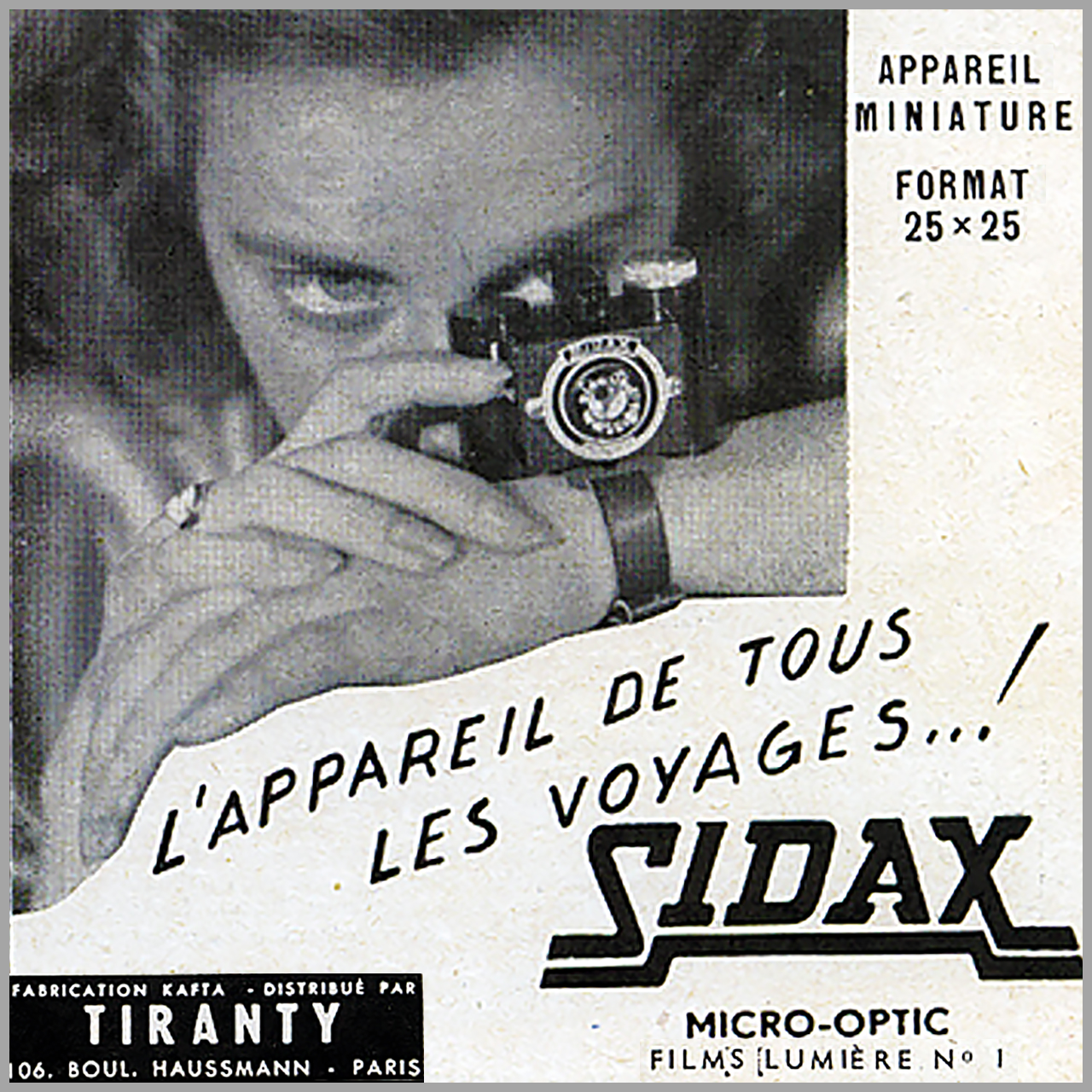
An advertisement of the Kafta Tiranty Sidax Micro-Optic. The SIDAX was sold with a bracelet dedicated to long exposures which gave it its nickname of “PHOTO BRACELET”
Kaftansky and sitting still? That doesn’t go together
Frédéric Kaftansky had started new activities in the meantime. On 24 January 1955 he applied for a patent on a miniature camera. This camera was shown on the Biennale in April and called STYLOPHOT.
The STYLOPHOT is spindle-shaped like a fountain pen, with a clip to put it in a pocket. Its picture format is 10×10 mm on standard 16 mm movie film in special cartridges. The cameras were made and sold by a company called Société Nouvelle d’Optique et de Photographie SA (SNOP) founded on 3 June 1955 and with address 3, rue Clément-Marot, Paris. Frédéric had all founder shares of the company.
In March 1956 started negotiations between the SNOP-company and SECAM (Société d’Etudes Constructions et Applications Mecaniques, founded in 1924) for a fusion of the two companies. The negotiations resulted on 21 December 1956 in a take-over of SNOP by SECAM on 1 January 1956. Frédéric brought in his patent on the STYLOPHOT and got for his founder-shares of SNOP normal shares of SECAM. The sales office, and maybe the “factory” was 48, rue Taitbout, Paris where in 1956 also the cameras made by Ets. KAFTA were sold.
Taking pictures with a pen
The camera was strongly promoted. There were advertisements in the most important French journals and magazines. To increase the number of retailers, each got one black-and-white film including processing free of charge. It was even stated in advertisements that a colour photo was cheaper than a black-and-white one. In December 1956 a second model was introduced, the STYLOPHOT LUXE. The first model was now called the STYLOPHOT STANDARD. The STYLOPHOT LUXE had a focusing Anastigmat 3.5/27 made by Roussel and a shutter with 1/75 sec and a flash contact.
Already before the negotiations of the fusion between SNOP and SECAM started, Frédéric Kaftansky applied for a new patent on a miniature camera similar to the STYLOPHOT. This patent application included also a guillotine-type shutter, a construction to avoid accidental exposures and a device to take stereo-pictures with two STYLOPHOTS simultaneously. The stereo-device was introduced in March 1958 together with a cheap stereo-viewer. The device was called STÉRÉOPHOT and used 2 Standard STYLOPHOTS, which also could be used separately. Or like the advertisements of those days said: “one for colour and one for black-and-white” or “one for Mister and one for Madam”.
Believe it or not: again another company
On 22 November 1958 Fritz Kaftanski and Georges P. Morineaux founded a limited company for the study, fabrication and wholesale of parts of photographical, optical, cinematographical, projection, radio, television and sound equipment called MINIPHOT.
Frédéric contributed 2/3 of the capital of the company by licenses of his patents on the STYLOPHOT and the slide-viewer, including the patents that were part of the fusion between SNOP and SECAM, while his companion contributed the funds. Managing director was Mr Morineaux and the legal address of the company was the same as that of Ets. KAFTA, 74, rue de la Federation, Paris.
But in advertisements in 1959, the same address was used as SECAM at the rue Clement-Marot no. 3. The sale was promoted by combining a camera with case and one colour film in a “golden” box for a slightly reduced price.
The end of the Kaftansky story
In 1960 a “new” model was introduced, the STYLOPHOT COLOR. It was identical to the STANDARD, but it had only 2 diaphragms marked colour (6.3) and noir (11). In the same year the camera was also shown on the Photokina in Köln (Germany). Advertisements for the STYLOPHOT COLOUR and STYLOPHOT LUXE could also be found in 1961 and 1962. In the 1960s the cameras were made in license by Walter Kunik of Frankfurt am Main (Germany) under the name FOTO-FÜLLER.
Then it became quiet around the STYLOPHOT, till the revival in 1970, when a new model, STYLOPHOT SECRETO, and the STYLOPHOT COLOUR were advertised as second camera by … SECAM! The SECRETO had a reflex-viewfinder, so one could take pictures at an angle of 90.
Biographical information of Frédéric Kaftansky after 1970 could not be found, but he did certainly not die in Paris; possibly he moved with his wife to Tours, where she died on 9th March 1988.
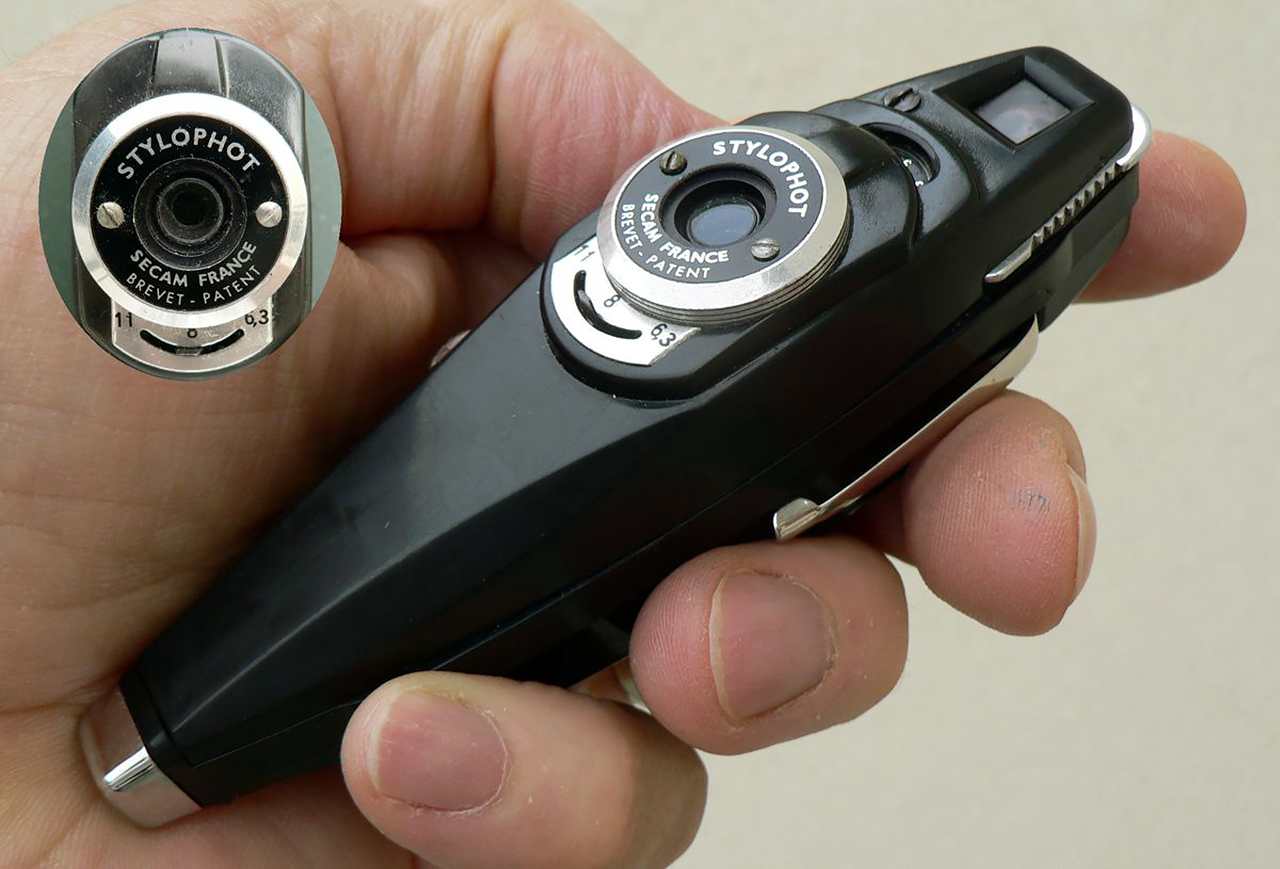
sida-Fotofex cameras
The usual camera sites on the internet did not provide an overview of the Sida-Fotofex cameras manufactured over the years.
Based on the company history on this site I have compiled a list, which will undoubtedly contain the necessary shortcomings, but in my opinion: something is better than nothing.
- WERBEFEX; a wooden box camera for 4.5 x 6 cm, 2 DM;
- REKORD-FEX; a wooden box camera for 6.5 x 9 cm, 3.85 DM;
- ROLLFEX; a 4.5 x 6 cm wooden box camera for rollfilms, 6 DM;
- KLAPPFEX; a folding wooden box camera for 4.5 x 6 or 9 x 12 cm, 25 DM;
- VISOR-FEX; a folding rollfilm-camera for 120 rollfilm or 6 x 9 cm plate;
- FEXOR; an all-metal, rollfilm-box for 16 exposures 3 x 4 cm on 127 film, 4.50 DM;
- PARLOR-FEX; a folding camera for rollfilm;
- MINI-FEX; a miniature camera for 36 exposures 13×18 on special rollfilm
- VOLKS-MINI-FEX; 2 DM;
- SIDA; (1936): metal-bodied viewfinder camera for 25×25-mm images on special, unperforated 35mm roll-film.
- SIDA Standard; (1938): later, metal-bodied version of the Sida; hardly changed.
- SIDA Extra; (1938): later, plastic-bodied version of the Sida.
- TURF (RENA); (1938-9): a bakelite-bodied folder for 4.5×6-cm exposures on special roll-film.
- TURF Extra; (1939 a new version of the Turf, now for 120 film.
- TURF 40; a version of the Turf designed for 6×9-cm exposures, but not actually made.
- SIDAX; (1937) a Bakelite subminiature 4×4 camera on special roll film
- FEX; (1938) a Bakelite subminiature 4×6.5 camera on 127 film
- Compa-FEX; (1942) a 4×6.5 wooden box camera
- SUPERFEX; (1947) a 4×6.5 bakelite-bodied camera
- ULTRA-FEX; (1948) a bakelite rollfilm camera for 6 x 9
- KAFTAX; (1950)bakelite camera for 6 x 9 cm on rollfilm
- 1952 KAFTAX became the BANCO, the BANCO LUX, the BANCO PERFECT and the BANCO SPECIAL up to the end of 1955
- STYLOPHOT STANDARD (1955) pen-shaped camera for 10×10 mm on standard 16 mm movie film
- STYLOPHOT LUXE (1956) also pen-shaped camera for 10×10 mm on standard 16 mm movie film
- In 1960 the STYLOPHOT cameras were made in license under the name FOTO-FÜLLER
- STYLOPHOT SECRETO (1970) also pen-shaped camera for 10×10 mm on standard 16 mm movie film
- STYLOPHOT COLOUR (1970) also pen-shaped camera for 10×10 mm on standard 16 mm movie film
FOUNDING DATE: 1961
FOUNDER: Michihiro Yamaki
COMPANY NAMES:
1961: Sigma Corporation (Kabushiki-gaisha Shiguma)
COMPANY ADDRESS:
2023: Asao-ku, Kawasaki, Kanagawa 215-8530, Japan; the plant is 300 km north of Tokyo because it needs clean air and clean water for making optical precision products with glass free of arsenic and lead.
Since the founding in 1961, SIGMA has produced cameras, lenses, flashes and other photographic accessories. All Sigma products are produced in the company’s own Aizu factory in Bandai, Fukushima, Japan. Although Sigma produces several camera models, the company is best known for producing high-quality lenses and other accessories that are compatible with the cameras produced by other companies. Nowadays Sigma also produces SLR camera models. Sigma is the world’s largest independent lens manufacturer and is a family-owned business.
 The tale of Sigma begins in 1961 when Michihiro Yamaki established the company in Tokyo, Japan, who was Sigma’s CEO until his death at age 78 in 2012.
The tale of Sigma begins in 1961 when Michihiro Yamaki established the company in Tokyo, Japan, who was Sigma’s CEO until his death at age 78 in 2012.
Yamaki’s vision was straightforward yet ambitious: to produce high-quality, innovative lenses that would challenge the industry’s status quo. The company’s early days were marked by a spirit of innovation and a relentless pursuit of optical excellence that would come to define Sigma’s ethos.
The company’s inaugural offering was the Sigma 200-500mm/3.5-4 Telephoto Zoom, an innovative lens that showcased Sigma’s commitment to creating versatile and reliable photography equipment. The lens was a testament to Sigma’s dedication to craftsmanship and precision, traits that would become integral to the brand’s identity.
As the 1970s unfolded, Sigma began to make its mark on the global stage. The brand consistently produced high-quality lenses that rivalled, and in some cases exceeded, the performance of those produced by established camera manufacturers. This period was marked by a series of innovative product launches that firmly established Sigma as a force to be reckoned with in the photography world.
One standout product of this era was the Sigma 12-24mm F4.5-5.6 DG HSM lens, which was heralded for its extreme wide-angle capabilities. As one of the first lenses of its kind, it showcased Sigma’s willingness to push the boundaries of lens design and optical technology.
Sigma also made significant strides in developing lenses for various camera mounts, providing photographers with more choice and flexibility. This opened up a world of possibilities for photographers who were no longer confined to lenses produced by their camera’s manufacturer.
Pioneering Innovation (1990s – 2000s)
By the end of the 1980s, Sigma had solidified its reputation as a manufacturer of high-quality, reliable, and innovative lenses. The brand had proven that it could stand shoulder to shoulder with the most established names in the industry.
Sigma products work with cameras from Canon, Nikon, Pentax, Sony, Olympus and Panasonic, as well as their own cameras. Sigma has also made lenses under the Quantaray name, which have been sold exclusively by Ritz Camera. Similarly, Sigma lenses were sold exclusively by the former Wolf Camera, but following the merger of Wolf and Ritz, both brands can be purchased.
As Sigma entered the last decade of the 20th century, it continued to break new ground, pushing the limits of what was possible in lens technology. This period marked a time of profound innovation for the company, with several notable achievements that further elevated Sigma’s status within the industry.
In 1994, Sigma introduced the world’s first ultra-wide-angle 20mm F1.8 lens, a truly ground-breaking product that opened up new creative avenues for photographers. This lens was celebrated for its ability to capture expansive scenes without distortion, a trait particularly valuable in landscape and architectural photography.
Sigma continued to innovate, delivering the world’s first large-aperture 50mm F1.4 lens in 2008. This lens, with its superior low-light performance and depth-of-field control, was a game-changer for portrait photographers and solidified Sigma’s reputation as a manufacturer of top-tier prime lenses. In late 2008 Sigma purchased sensor designer Foveon.
This era also saw Sigma extend its innovation to the world of camera bodies. The launch of the Sigma SD series marked a significant departure from traditional digital cameras. At the heart of these cameras was the Foveon X3 sensor, a unique technology that captured red, green, and blue light at every pixel location. This resulted in images with remarkable detail and colour fidelity, making the SD series a favourite among many photographers.
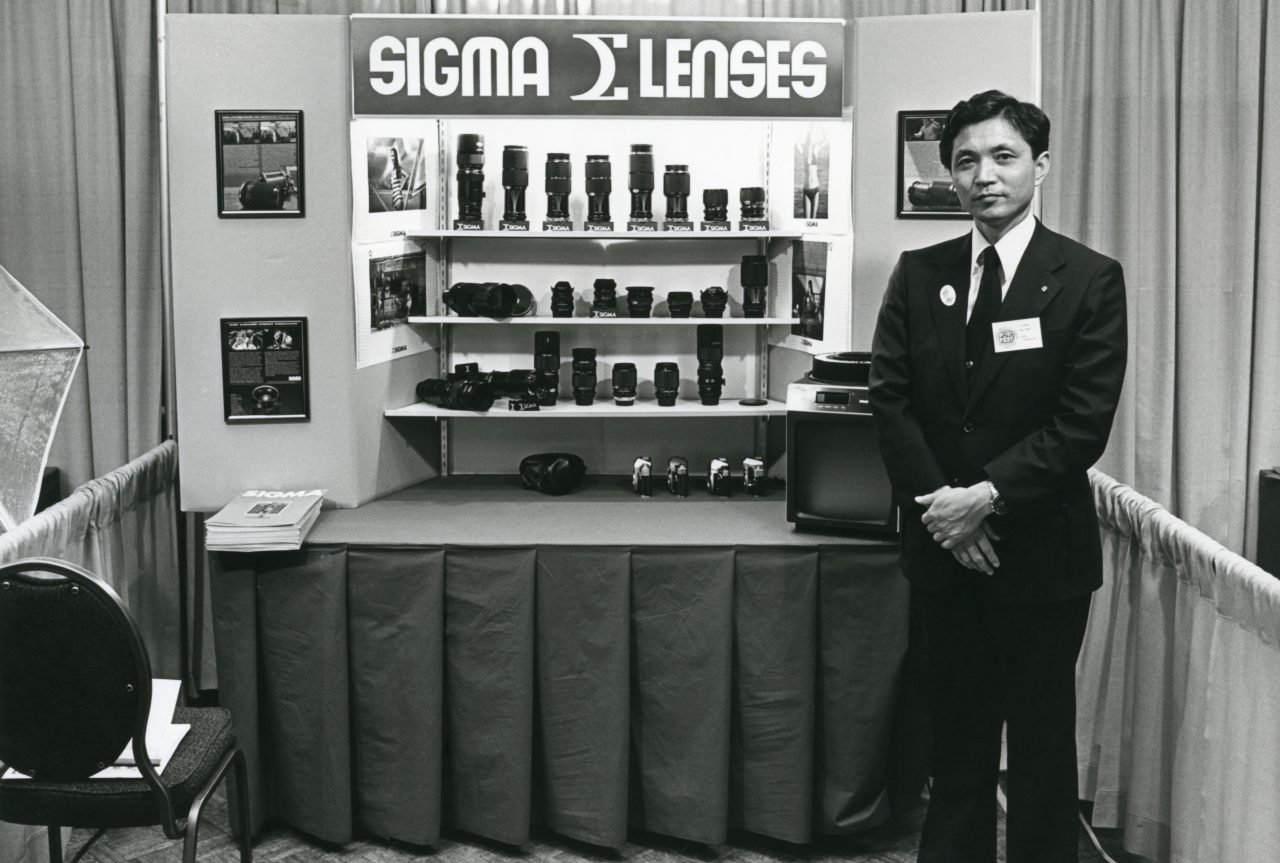
Michihiro Yamaki showing the products at the Japan Camera Show in 1961.

The early days, circa 1961, in front of SIGMA Research Institute Co., Ltd. in Setagaya Ward. The supporting members gather for a group photo. (Michihiro Yamaki on the right).
The Art, Contemporary, and Sports Lines (2010s – Present)
The past decade has seen Sigma continue to redefine the landscape of photography with its innovative approach to lens design. In a bold move in 2012, Sigma restructured its entire lens line-up into three distinct categories: Art, Contemporary, and Sports. This rebranding not only clarified Sigma’s offerings but also highlighted the company’s commitment to meeting the diverse needs of photographers.
The Art line, as the name suggests, is geared towards photographers who prioritize artistic expression. These lenses boast exceptional optical performance and a wide range of focal lengths. The standout star of this line is arguably the Sigma 35mm F1.4 DG HSM Art, a lens celebrated for its superior sharpness, beautiful bokeh, and remarkable low-light capabilities.
Sigma’s Contemporary line is designed with the modern photographer’s needs in mind. These lenses balance high optical performance with compactness and versatility, making them ideal for travel and everyday photography. The Sigma 18-300mm F3.5-6.3 DC MACRO OS HSM Contemporary is a shining example, providing photographers with a vast range of focal lengths while maintaining excellent image quality.
The Sports line, on the other hand, caters to photographers who require lenses capable of capturing fast-moving action with precision. Notably, the Sigma 150-600mm F5-6.3 DG OS HSM Sports offers a phenomenal reach, weather sealing, and sharp results, making it a favourite among wildlife and sports photographers.
In September 2018 Sigma became one of the founding members of the L-Mount Alliance; it announced that it will cease to develop SA-mount cameras and instead use Leica’s L-Mount. A new full-frame mirrorless camera, Sigma FP, was launched in 2019 along with a range of L-Mount lenses and adapters.
Cameras
Sigma has made a number of film SLR cameras, including the SA-300, SA-5, SA-7 and SA-9. Their latest consumer digital SLR is the SD15. During Photokina 2010, Sigma announced a new flagship DSLR camera, the SD1. SD1 features a new 46MP Foveon X3 sensor with 1.5x crop, as opposed to the 1.7x crop of previous models.
All Sigma SLR, DSLR, and mirror-less cameras use the Sigma SA mount, which is mechanically similar to the Pentax K mount and electrically an adaptation of the Canon EF lens mount lens control system.
Sigma also produces the DP series of high-end compact digital cameras. The Foveon APS-C sized sensors are similar to those used in the DSLR line. The current line makes use of the Quattro sensor, a variant of the Foveon design that has a higher resolution top layer and lower resolution lower layers combined into a final image that is claimed to be equivalent to a 39 Megapixel colour filter array image. The four compact cameras are differentiated by their fixed prime lens, with the ultra wide DP0, the wide DP1, the normal DP2 and the telephoto DP3.
In February 2016, Sigma announced two new mirrorless cameras—the SD Quattro and SD Quattro H. Both cameras use the full-depth Sigma SA mount, allowing the use of existing SA-mount lenses, and also use Foveon Quattro sensors. The SD Quattro uses an APS-C sensor with 19.6 MP in the top layer, while the SD Quattro H uses an APS-H (1.35x crop) sensor with 25.5 MP in the top layer. The company claims that the Foveon Quattro technology produces a level of detail equivalent to that of a Bayer sensor with twice the pixel count.
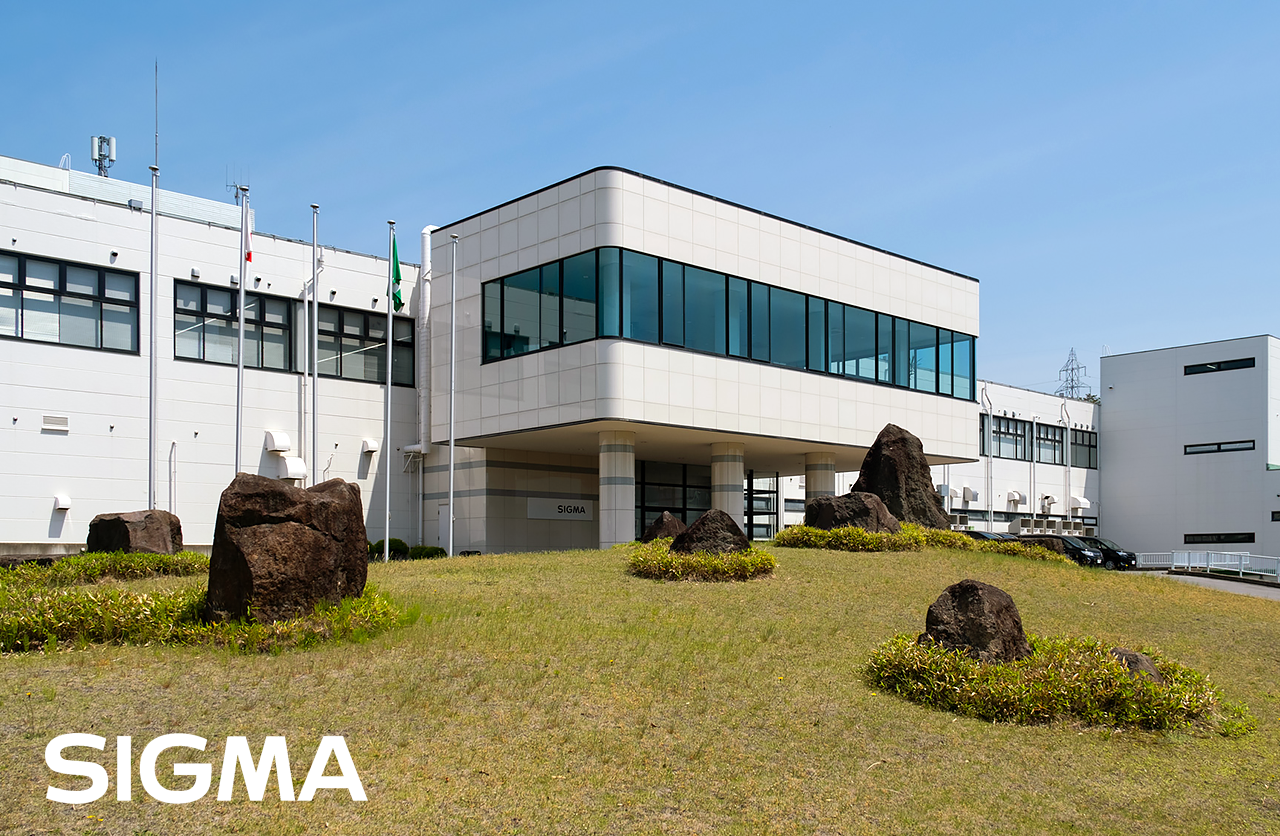
The front of the main building of the SIGMA Aizu factory, SIGMA’s only manufacturing base was established in 1973. The clear climate and the honest character of the people of Aizu was the decisive factor to set up the factory here.
Impressions of production in the Sigma factory and
a list of cameras and lenses manufactured
Sigma has a rule: ”Small Office, Big Factory”. It means they limit the office area to the minimum, focusing on lowering overheads and maximizing productive capacities.
Accordingly, in the Kawasaki office work just 200 people and 75% of them are engineers responsible for designing new products. The administration, sales and marketing divisions are manned by just several dozen of employees – no mean feat in a company which annual sales turnover amounts to 38.2 bilion yens.
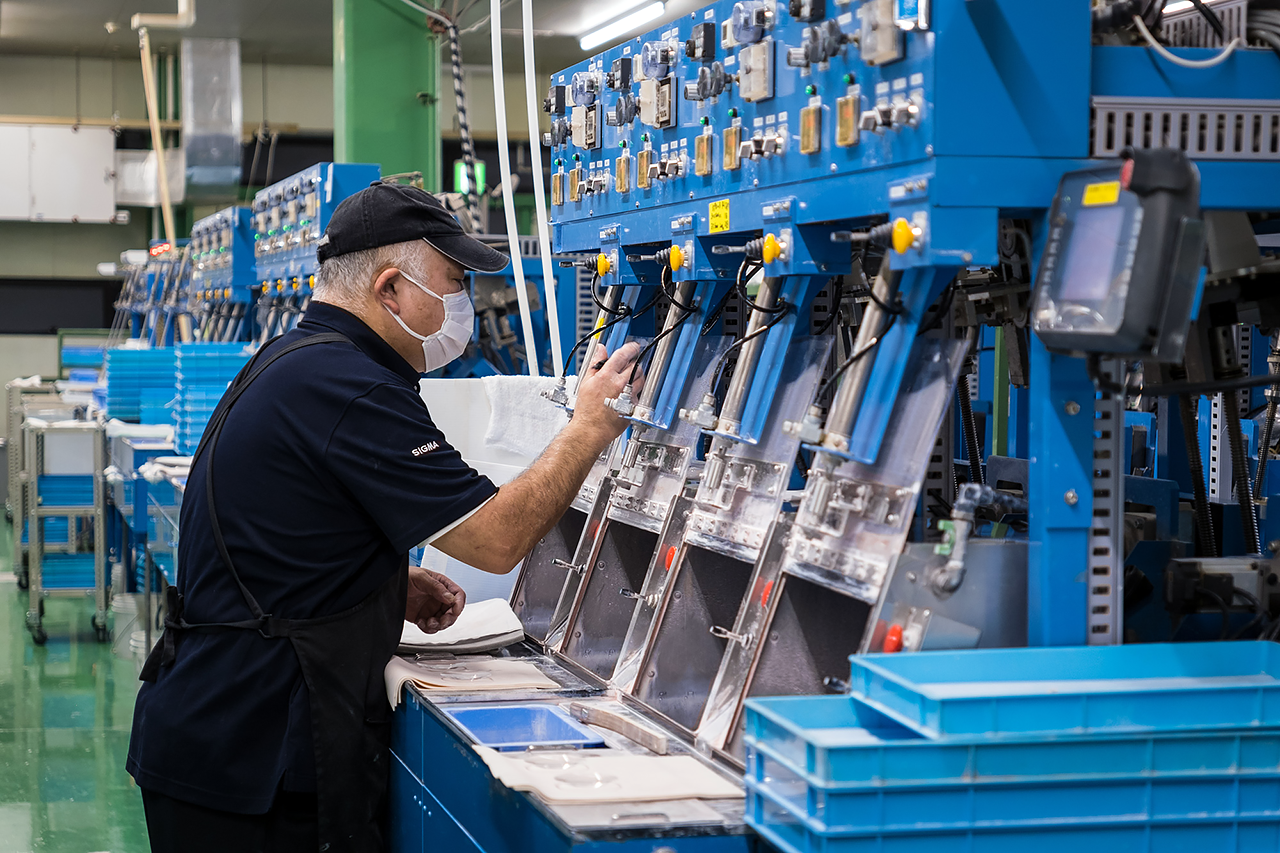
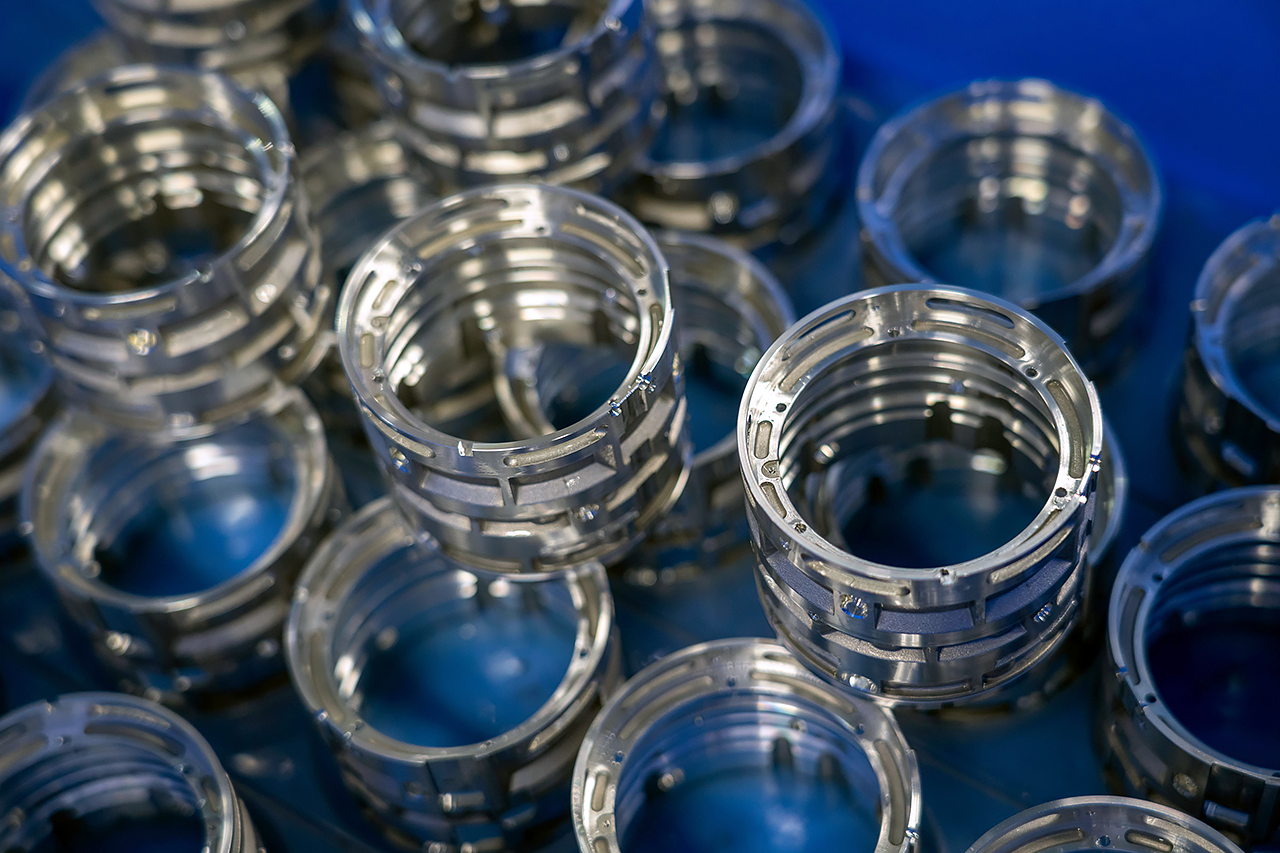
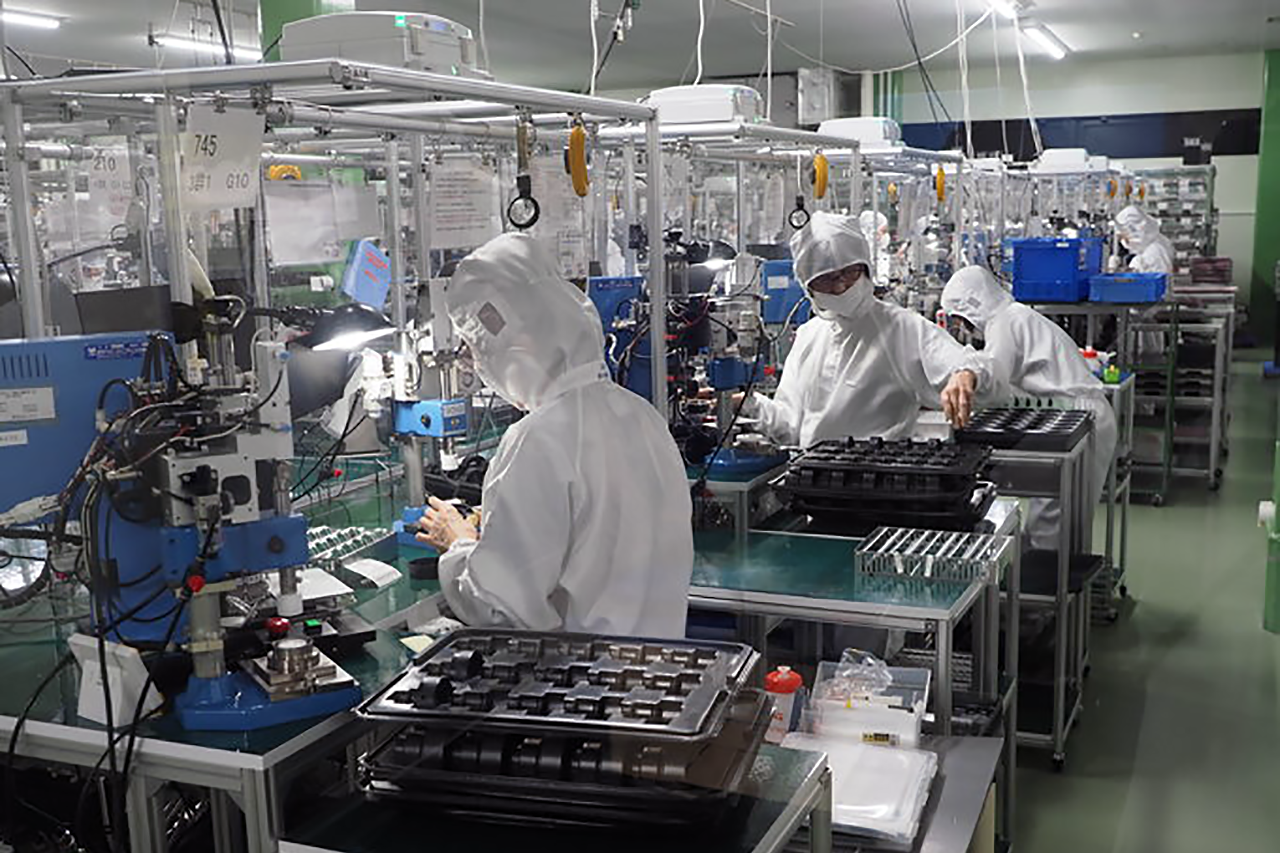
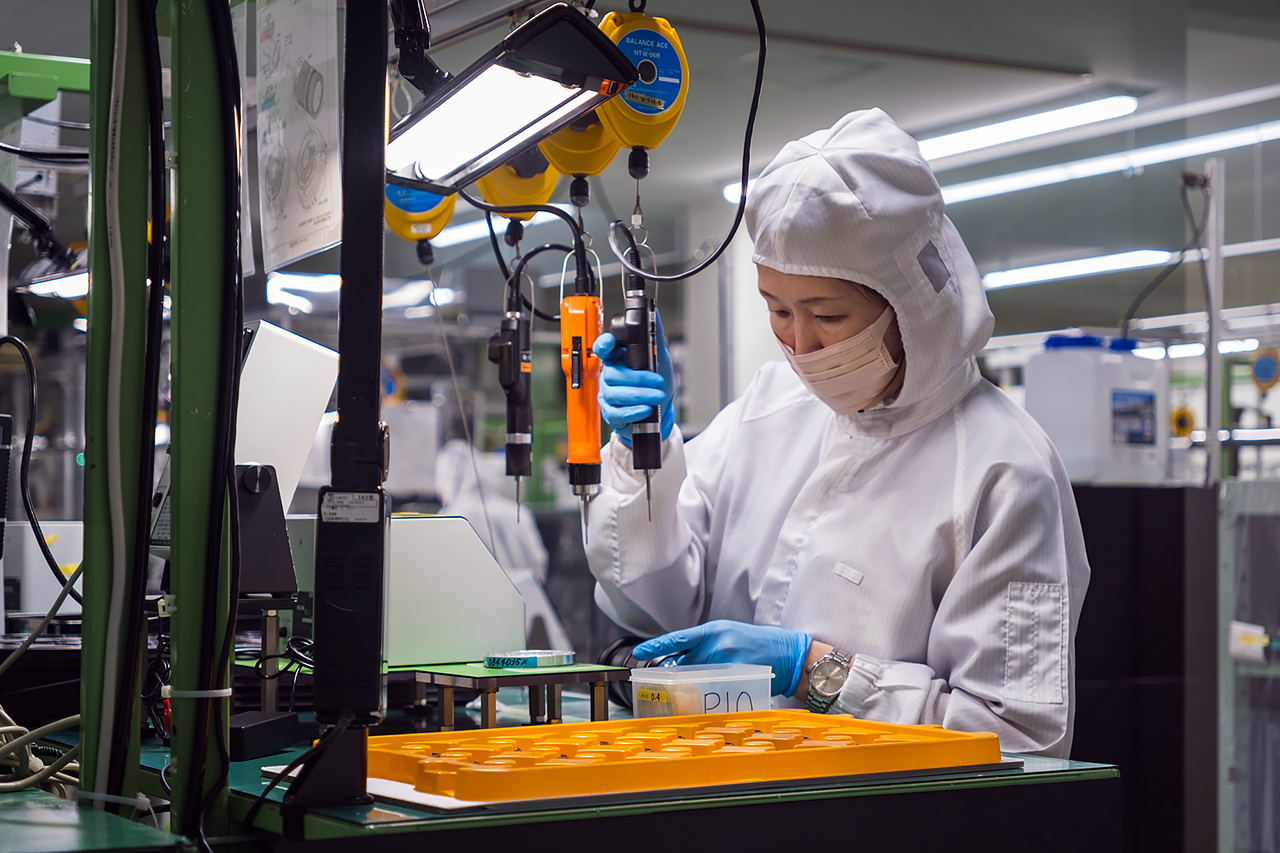
(SD series)
- SD1
- SD1m (2012)
- SD-9 (3.4 / 10.2 MP, 2002)
- SD-10 (3.4 / 10.2 MP, 2004)
- SD-14 (4.6 / 14 MP, 2006)
- SD-15 (4.6 / 14 MP, 2009?)
(DP series)
- DP1 (28mm equiv., 4.6 / 14 MP, 2008)
- DP1s (2009)
- DP1x (2010)
- DP1m (2012)
- DP1 Quattro (2014)
- DP2 (41mm equiv,. 4.6 / 14 MP, 2009)
- DP2s (2010)
- DP2x (2011)
- DP2m (2012)
- DP2 Quattro (2014)
- DP3 (75mm equiv, 2013)
- DP3 Quattro (2014)
- DP0 Quattro
(SD series)
- sd Quattro
- sd Quattro H
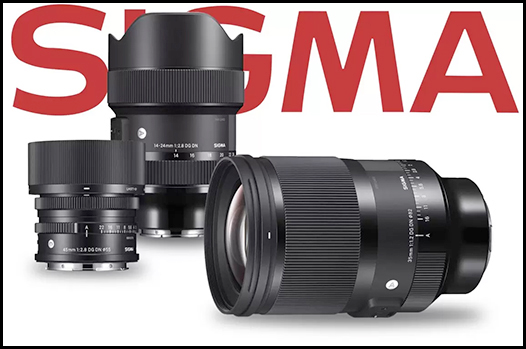
SLR
- Mark-I (M42 thread mount SLR, based on Ricoh Singlex TLS, 1976)
- SA-1 (K-mount SLR, based on Ricoh XR7, 1983)
SLR SA mount
- SA-300
- SA-300N
- SA-5
- SA 7 QD (modern automatic SLR)
- SA 9 QD (modern automatic SLR, more features, exposure times down to 1/6000 sec)
Point and shoot
- Sigma 28AF Zoom (1990)
- Sigma 35AF Zoom (1990)
- Sigma 50AF Zoom (1990)
- Sigma AF35D-TF
- Sigma AF Zoom Super 28 (1991)
- Sigma AF Zoom Super 70 (1991)
- Sigma AF Zoom Super 100 (1991)
- Sigma Mini Zoom 105 Macro
LENSES
wide Lenses
- 8mm F3.5 EX DG Circular Fisheye
- 15mm F2.8 EX DG DIAGONAL Fisheye
- 20mm F1.8 EX DG ASPHERICAL RF
- 24mm F1.8 EX DG ASPHERICAL MACRO
- 28mm F1.8 EX DG ASPHERICAL MACRO
Wide Zoom
Lenses
- 12-24mm F4.5-5.6 EX DG ASPHERICAL HSM
- 15-30mm F3.5-4.5 EX DG ASPHERICAL
- 17-35mm F2.8-4 EX DG ASPHERICAL HSM
- 20-40mm F2.8 EX DG ASPHERICAL
Standard Zoom
Lenses
- 24-60mm F2.8 EX DG
- 24-70mm F2.8 EX DG MACRO
- 28-70mm F2.8 EX DG
- 28-70mm F2.8-4 DG
- 28-300mm F3.5-6.3 DG Macro
Telephoto Zoom
Lenses
- APO 50-500mm F4-6.3 EX DG HSM
- APO 70-200mm F2.8 II EX DG MACRO HSM
- APO 70-200mm F2.8 EX DG MACRO HSM
- 70-300mm F4-5.6 DG MACRO
- 70-300mm F4-5.6 APO DG MACRO
- 80-200mm F3.5-4 High-Speed Zoom
- APO 80-400mm F4.5-5.6 EX DG OS
- APO 100-300mm F4 EX DG HSM
- APO 120-300mm F2.8 EX DG HSM
- APO 135-400mm F4.5-5.6 DG
- APO 170-500mm F5-6.3 DG
- APO 200-500mm F2.8/400-1000mm F5.6 EX DG
- APO 150-500mm F5-6.3 DG OS HSM
- APO 120-400mm F4.5-5.6 DG OS HSM
- APO 300-800 F5.6 EX DG HSM
STANDARD Lenses
- 50mm F1.4 EX DG HSM
MACRO Lenses
- AF MACRO 50mm F2.8
- MACRO 50mm F2.8 EX DG
- MACRO 70mm F2.8 EX DG
- MACRO 105mm F2.8 EX DG
- APO MACRO 150mm F2.8 EX DG HSM
- APO MACRO 180mm F3.5 EX DG IF HSM
TELEPHOTO Lenses
- APO 800mm F5.6 EX DG HSM
- APO 500mm F4.5 EX DG HSM
- APO 300mm F2.8 EX DG HSM
DC LENSES for
Digital SLR Camera
- 10-20mm F4-5.6 EX DC HSM
- 17-70mm F2.8-4.5 DC MACRO
- 17-70mm F2.8-4.5 DC MACRO HSM
- 18-50mm F2.8 EX DC MACRO
- 18-50mm F2.8 EX DC MACRO HSM
- 18-50mm F3.5-5.6 DC
- 18-50mm F3.5-5.6 DC HSM
- 18-125mm F3.8-5.6 DC OS HSM
- 18-200mm f3.5-6.3 DC OS HSM
- 18-200mm F3.5-6.3 DC
- 18-200mm F3.5-6.3 DC OS
- APO 50-150mm F2.8 II EX DC HSM
- APO 50-150mm F2.8 EX DC HSM
- 55-200mm F4-5.6 DC
- 55-200mm F4-5.6 DC HSM
- 5mm F2.8 EX DC Circular Fisheye HSM
- 10mm F2.8 EX DC Fisheye HSM
- 30mm F1.4 EX DC HSM
(XQ series (1975-1980)
- 16mm f/2.8 Fisheye
- 18mm f/3.2
- 24mm f/2.8
- 28mm f/2.8
- 35mm f/2.8
- 55mm f/2.8 Macro
- 100mm f/2.8 Macro
- 135mm f/1.8
- 200mm f/2.8
- 200mm f/4
- 300mm f/4
- 400mm f/5.6
- 500mm f/4 Mirror
- 500mm f/8 Mirror
- Sigma XQ Mini-Zoom 39-80mm f/3.5 Macro
- 70-230mm f/4.5 Macro
- 80-200 f/3.5 Macro
- 120-300 mm f/5.6
- Sigma Super Wide 24mm f/2.8
- Sigma Super Wide-II 24mm f/2.8
- Sigma 28mm f/2.8 Mini-Wide
- Sigma 28mm f/2.8 Mini-Wide II
- Sigma Zoom 28-80mm f/3.5-4.5
- Sigma Zoom Kappa-II 70-210mm f/4.5
- Sigma Zoom 70-210mm f/4-5.6 UC
- Sigma Zoom Delta-II 70-250mm f/3.5-4.5
- Sigma Zoom Kappa-III 75-210mm f/3.5-4.5
- Sigma Zoom Lambda-II 75-300mm f/4.5-5.6
- Sigma Zoom 80-200mm f/3.5-4
- Sigma Zoom 100-200mm f/4.5
- 600mm F8 Mirror Lens
FOUNDER: reforming of the Amalgamated Photographic Manufacturers (AMP) Ltd.
COMPANY NAMES:
1929: Soho Ltd.; 1946: Kershaw-Soho Ltd. ; 1947: Kershaw-Soho (sales) Ltd.; 19??: GB Equipments Ltd.; 19??: the company stopped producing cameras.
COMPANY ADDRESSES:
1929: 3 Soho Square, London; 1942: Colham Mill Road, West Drayton, Middlesex; 1943: Germain Street, Chesham, Buckinghamshire.
The Soho Ltd. company was established in July 1929 from the reforming of the Amalgamated Photographic Manufacturers (AMP) Ltd.
Soho Ltd. was located at 3 Soho Square in London and continued to carry the quality cameras of the AMP brand like the Reflexes and the studio and field camera.
The company slowed down during world war II beginning in 1942 and was operating from Colham Mill Road, West Drayton, Middlesex and then in 1943 from Germain Street, Chesham, Buckinghamshire. The company re-emerged after the war in 1946 as the Kershaw-Soho Ltd. The new firm was essentially the sales division of the Kershaw company.
The Kershaw family sold the company to the Rank organisation in 1947. The company name became Kershaw-Soho (Sales) Ltd. It was during this period that many of the folding cameras, perhaps the most familiar of Kershaw’s products, were produced.
Kershaw-Soho named most of its cameras after birds, the directors being keen birders. The company name changed again, to GB Equipments Ltd, cameras being branded G.B. Kershaw. Finally, the company stopped producing cameras, but the ‘Kershaw Division’ remained a distinct part of the Rank organisation for some time.
Cameras
- Baby Soho Reflex
- Soho Altrex
- Soho Beltrex
- Soho Cadet
- Soho Celtrex
- Soho Combintation No. 1
- Soho Dualex
- Soho Feltrex
- Soho Laltrex
- Soho Model B
- Soho Myna All Distance
- Soho Myna Model SK-12
- Soho No 3
- Soho No. 4
- Soho No. 5
- Soho Pilot
- Soho Precision
- Soho Press
- Soho Reflex
- Soho Rollfilm Focal Plane
- Soho Studio
- Soho Tuon
- Soho Vest Pocket
- Soho Vest Pocket Deluxe
- Stereoscopic Soho
- Kershaw 110
- Kershaw 450
- Kershaw 630
- Curlew (three models)
- Eight-20 King Penguin
- Eight-20 Penguin
- Peregrine (three models)
- Raven
- Soho Reflex (numerous models and sizes; see the brochure, linked below)
- Ilford Prentice
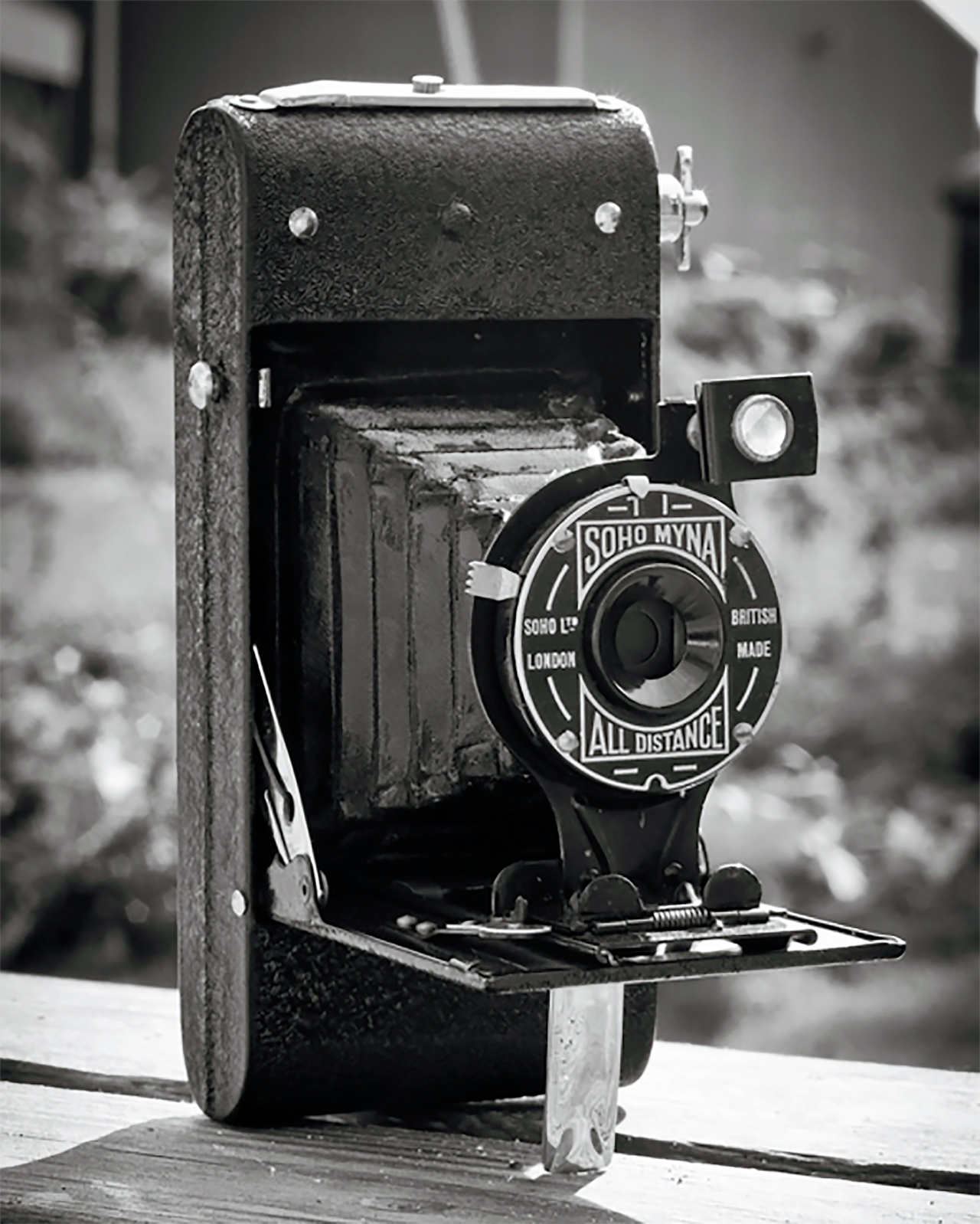
FOUNDER: UNKNOWN
COMPANY NAMES:
1931: Standard Cameras Limited.; 1955: The Standard Camera Ltd Co. went out of business.
COMPANY ADDRESSES:
1931: 51 Mott Street, Birmingham.

Not much was found on the Internet about Standard Cameras Limited of Birmingham. It is possible that the information on this page can be supplemented later. If you have more information about this company, please send it to info@p3b.nl.
Cameras have been made in Birmingham since 1880, by companies such as J. Lancaster & Son and in 1926 the Coronet Camera Company joined the marketplace. Most noted for its box cameras, it was established at 48 Great Hampton Street, Aston, by Frederick Pettifer. Coronet’s aim was to market a cheaper range of cameras and by 1933 over 510,000 Coronet cameras had been sold.
Coronet also had links to another Birmingham based camera firm, Standard Cameras, which made a cheap box camera called the Conway. Standard Cameras Limited traded between 1931 and 1955. The company was located at 51 Mott Street and made a cheap camera range branded Conway. Most of these Conway Cameras took 6 x 9 cm images on 120 film.
The cameras are very similar to some of the Coronet products. The box cameras have folding covers on the viewfinders which provided some shade when in use. It turns out that they have also interchangeable parts with the Coronet-cameras.
Therefore, it seems likely that this company either had a relationship with the Coronet Company or purchased the same plastic camera bodies and parts from Edwin Elliot’s plastics firm in Birmingham, because as stated above, many of the Coronet cameras was of the same design.
BOX CAMERAs
- Conway
- Conway Camera – Colour-Filter Model
- Conway Camera – De Luxe Model
- Conway Camera – Popular Model
- Conway Camera – Synchronised Model
- Conway Super Flash
BOX CAMERAs (CONTINUED)
- Coronet Conway
- Kenilworth
- Vernak; the Colour-filter Conway, re-badged for the short-lived Vernak Film Company
STEREO CAMERAs
- Robin Hood
FOUNDER: Carl August von Steinheil
COMPANY NAMES:
1855: Steinheil Optical Institute; 1870: C. A. Steinheil Söhne; 1930: C. A. Steinheil Söhne AG; 1950s: Optische Werke C. A. Steinheil Sohne GmbH; 1962: Elgeet Optical Company acquired ownership of Steinheil through a purchase of 80% of the company’s stock; 1964: Elgeet sold Steinheil to Lear Siegler, Inc. and became Steinheil-Lear Siegler; 1988: Steinheil-Lear Siegler was sold to British Aerospace and renamed Steinheil Optronic; 1995: British Aerospace dissolved Steinheil and sold off bits and pieces of the subsidiary; The Steinheil trademark itself expired on 26 December 1994 and was not renewed.
COMPANY ADDRESSES:
1855: Munich; 1954: St. Martinstrasse 76, Munich 8, Germany.
C. A. Steinheil Söhne was a Munich-based optical manufacturing company that manufactured astronomical telescopes, camera lenses, and other optical devices. The company was founded in 1855 by Carl August von Steinheil and existed until 1995.
 A. Steinheil Söhne Optical and Astronomical Works was a German optical company based in Munich (München), Bavaria. It made optical equipment and camera lenses from the 19th century until at least the 1970s.
A. Steinheil Söhne Optical and Astronomical Works was a German optical company based in Munich (München), Bavaria. It made optical equipment and camera lenses from the 19th century until at least the 1970s.
The company was founded in 1855 by Carl August von Steinheil (1801-1870), a German physicist and astronomer. At the time of founding, the organization was known as the Steinheil Optical Institute.
The company made many of the astronomical telescopes for German observatories include those at Upsala, Mannheim, Leipzig, and Utrecht.
Carl’s son Hugo Adolph Steinheil (1832-1893) bought out father’s interest in the Institute, renamed it to C. A. Steinheil Söhne and continued as owner of the company after his father’s death in 1870.
In 1866 the company invented the Aplanat lens. In 1890, Adolph’s son, Rudolph Steinheil (1865-1930), joined the family business, eventually became owner in 1892. During the early years, the company referred to itself as C. A. Steinheil Söhne but was commonly known simply as Steinheil. In the 1930s, Steinheil became a stock company and was jointly owned by Rudolph Steinheil’s five daughters.
Steinheil made a few cameras at various times, and during the late 1940s, it developed an advanced 35mm camera with interchangeable lenses, the Casca.
On 24 Oct, 1952 C.A. Steinheil filed for a United States trademark on the word Steinheil. The trademark registration was granted on 23 March, 1954. At the time of filing L. F. Von Hornstein was listed as the Director of the company and the address was listed as St. Martinstrasse 76, Munich 8, Germany.
 The company name on trademark filings in the 1950s was shown as Optische Werke C. A. Steinheil Sohne GmbH. The trademark application states that the name Steinheil was first used in commerce in 1884.
The company name on trademark filings in the 1950s was shown as Optische Werke C. A. Steinheil Sohne GmbH. The trademark application states that the name Steinheil was first used in commerce in 1884.
During the early 1960s, Steinheil lenses were distributed in the United States by Ponder & Best. In 1962 The Elgeet Optical Company, a large, Rochester, NY based American lens manufacturer, acquired ownership of Steinheil through a purchase of 80% of the company’s stock for $560,000 USD.
Two years later, in 1964, Elgeet sold Steinheil to Lear Siegler, Inc., an American aviation conglomerate. The company became a subsidiary known as Steinheil-Lear Siegler and primarily developed optics for aviation applications such as gun sights and navigation instruments.
In the late 1980s Steinheil-Lear Siegler was sold to British Aerospace for £17 million. The company was again renamed, this time to Steinheil Optronic.
In 1995, British Aerospace dissolved Steinheil and sold off bits and pieces of the subsidiary to various companies.
Tank site manufacturing was sold to STN Atlas Elektronik in 1995; pump and actuator manufacturing was sold to an investor group; gyroscope manufacturing to German company, Autoflug; some of the optical manufacturing and trademarks were acquired by Jenoptik AG.
The Steinheil trademark itself expired on 26 December 1994 and was not renewed.
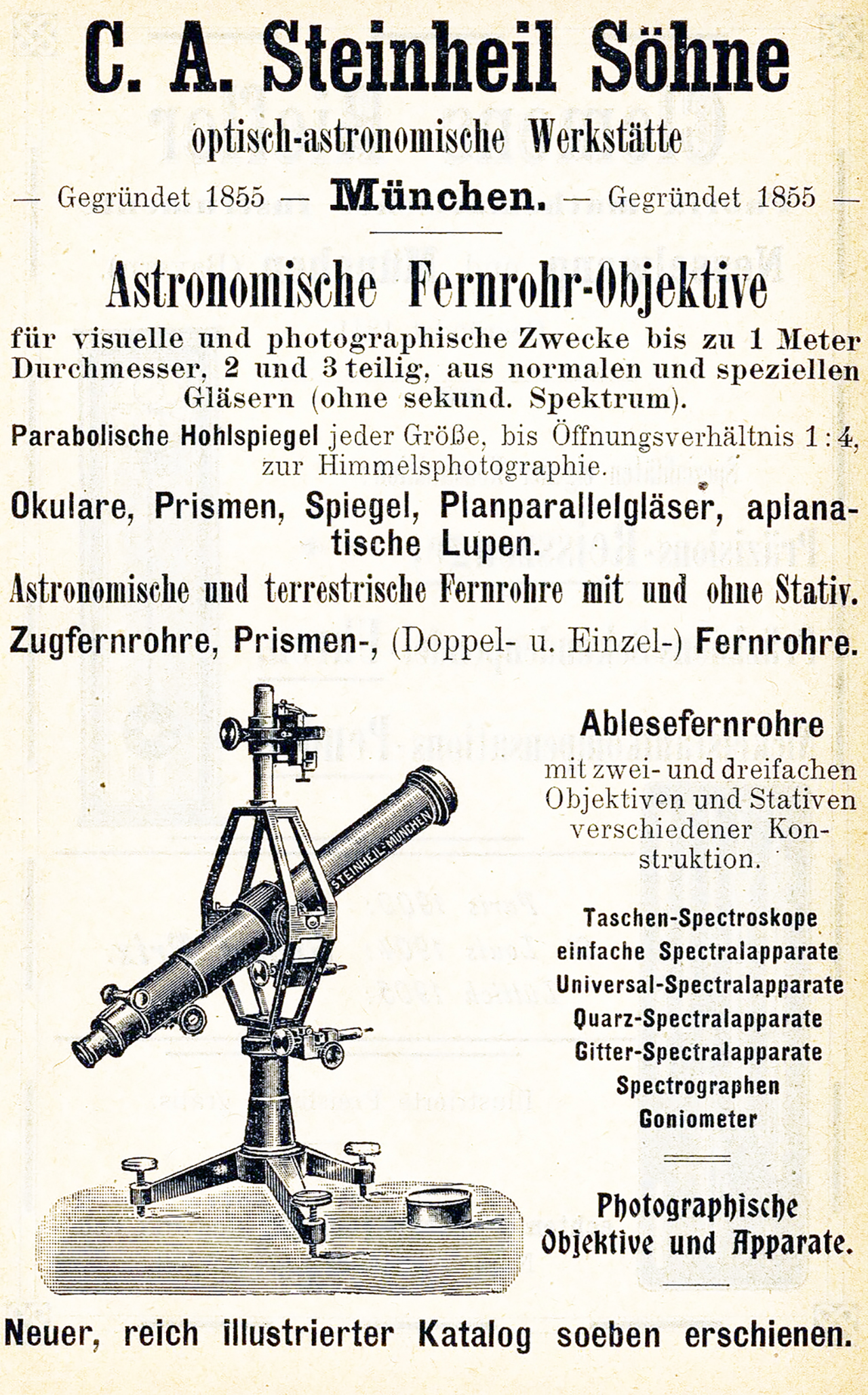
An advertisement from the early twentieth century.

- Alto-Stereo-Quart (1903)
- Alto-Stereo-Quart III (1905)
- Alto-Stereo-Quart IV (1905)
- Boxkamera
- Casca I
- Casca II
- Detektiv-Camera (c1890)
- Detectiv-Camera Stereo (Detective Camera; c.1896)
- Detektiv-Geheim-Kamera (separate model to Detektiv?)
- Daguerreotypie-KA
- Folding plate camera (c.1930)
- Klappkamera Stereo (Folding Stereo)
- Kleinfilm-Kamera Mod.I and Mod.II
- Multo-Nettel (1907)
- Rocktaschenkamera (Pocket camera)
- Steinheil Speed Camera (c.1933; 3×4 and 4x5cm versions)
- Spectrographen Kamera
- Tropical Camera (Klappkamera Tropen)
- Universal Kamera
- Steinheil Munich Cintagon 100mm f/3.5 (Argus C44)
- Steinheil Munich Culmigon 35mm f/4.5 (Exakta)
- Steinheil Munich Culminar 50mm f/2.8 VL
- Steinheil Munich Culminar 85mm f/2.8 VL
- Steinheil Munich Culminar 135mm f/4
- Steinheil Munich Culminon 210mm f/4.5 enlarging lens
- Steinheil Munich Quinar 85mm f/3.5 (Leica M39)
- Steinheil Munich Macro-S-Quinar 100mm f/2.8 (Exakta)
- Steinheil Munich Auto Quinar 100mm f/3.5 (Exakta)
- Steinheil Munich Auto Tele Quinar 135mm f/2.8 (Nikon F, Exakta)
- Steinheil Munich Auto D Tele Quinar 135mm f/2.8 (Exakta)
- Steinheil Munich Auto D Tele Quinar 135mm f/3.5 (Exakta)
- Steinheil Munich Tele Quinar 200mm f/4 (Exakta, Nikon F)
- Steinheil Munich Tele Quinar 300mm f/4.5 (Exakta, M42)
- Steinheil Munich Auto-Quinaron 35mm f/2.8 (Exakta)
- Steinheil Munich Auto Quinon 55mm f/1.9 (Exakta, Leica M, M42)
- Steinheil Munich EDIXA-Auto-Cassaron 50mm f/2.8 (M42)
- Steinheil Munich Doppelanastigmat Unofocal
Some Heliostar lenses are engraved “M. Steinheil München”, but there is some doubt on their origin. A Japanese zoom lens badged as MC Auto Steinheil seems to be identical to the Super Albinar 100-200 mm f/5.6, both are almost certainly badge names.
- Cassar: A basic three element anastigmat lens design.
- Cassarit: replaced the Cassar around 1955 with new glass types and larger diameter for better correction
- Cassaron
- Culminon: enlarging lens 4 elements
- Culmigon: 5 elements
- Culminar: A Tessar design lens with four elements in three groups.
- Noctar
- Orthostigmat
- Quinar and Tele-Quinar
- Quinaron
- Quinon
- Triplar
- Unofocal
- Adox 300 and Adox Sport
- Argus C44 (accessory wide & tele lenses)
- Braun Norca
- Bolsey Jubilee and Bolsey B3
- Bolsey Explorer
- Certo Dollina I, Dollina II, Dollina III and Super Dollina
- Dacora-Matic 4D
- Edinex
- Edixa Vero
- Hapo 10
- Iloca Rapid B
- Iloca Stereo Rapid – Cassarit lenses
- Ilford Sportsman
- King Regula models
- Rocca Automatic and Rocca Super Reflex
- Welti
- Braun Super Paxette
- Georges Mendel appareil photographique
- Need
- Regula Super
- Sun plate folder
FOUNDING DATE: 2009
FOUNDER: Samuele Piccoli
COMPANY NAMES:
2009: StenopeiKa.
COMPANY ADDRESSES:
Pistoia, Tuscany, Italy.
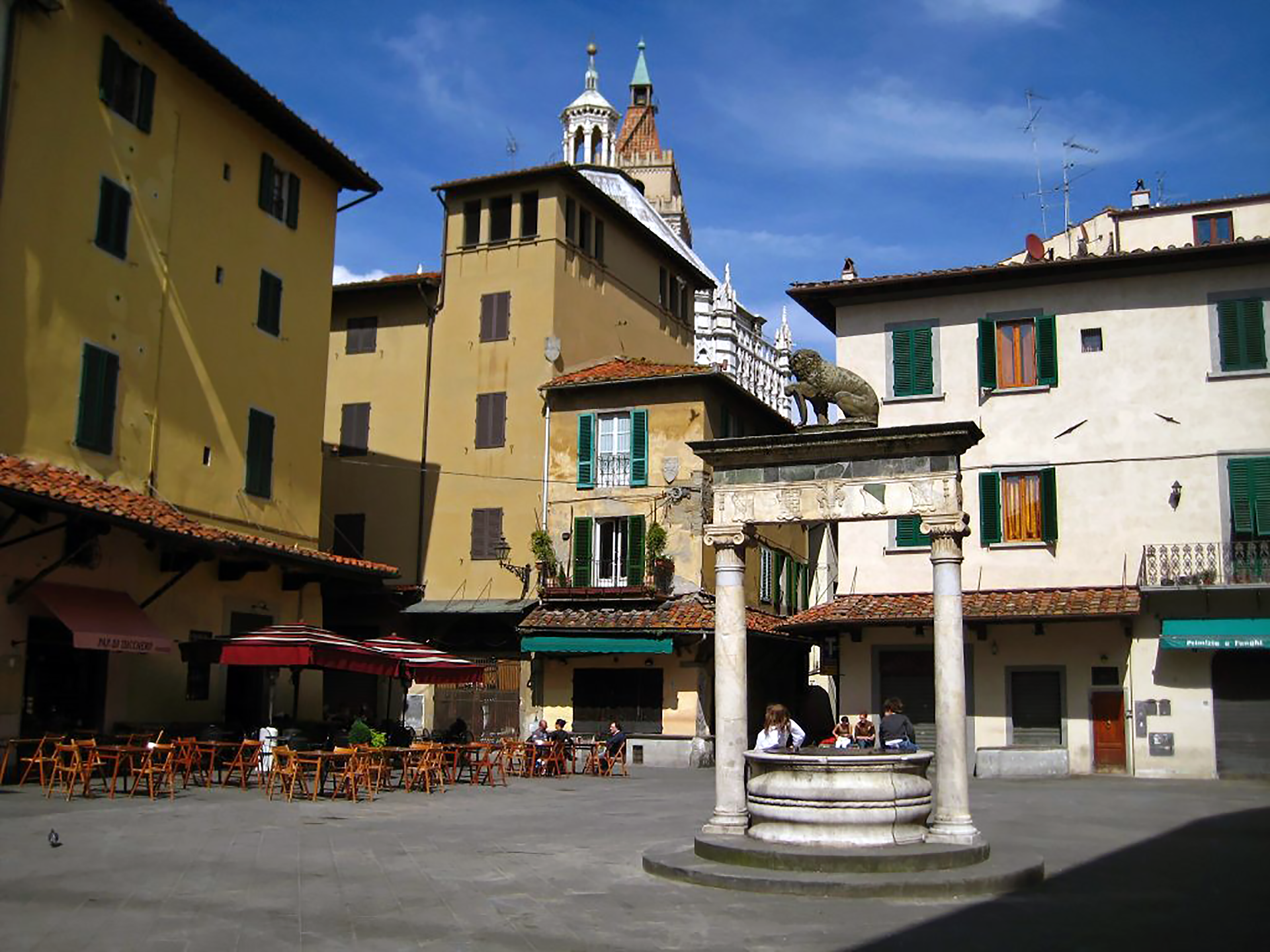
The well of the little lion in Pistoia.
 Samuele Piccoli is a little handcraft camera maker located in Pistoia, Tuscany, Italy. He loves photography, and in particular large format, collodion, pinhole photography and wood… so with the union of this passions StenopeiKa was born in 2009.
Samuele Piccoli is a little handcraft camera maker located in Pistoia, Tuscany, Italy. He loves photography, and in particular large format, collodion, pinhole photography and wood… so with the union of this passions StenopeiKa was born in 2009.
In the first years the company produced wooden pinhole cameras, but since 2013 they started production of large format cameras and accessories for alternative photographic processes too.
After 9 years,so in 2018, the day arrived, when I said “goodbye” to the pinhole cameras. From then on the company stopped the production of this type of cameras. But, be sure that the first love is never forgotten. Goodbye … maybe there will be a revival in the next years…
Below are a few examples of large format cameras from this tiny company. But maybe the company is small, the owner’s passion is inversely large.
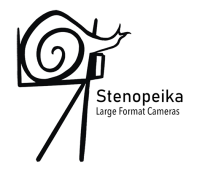

Michelangelo 4×5 folding camera is the top of the range large format camera in the Stenopeika line.
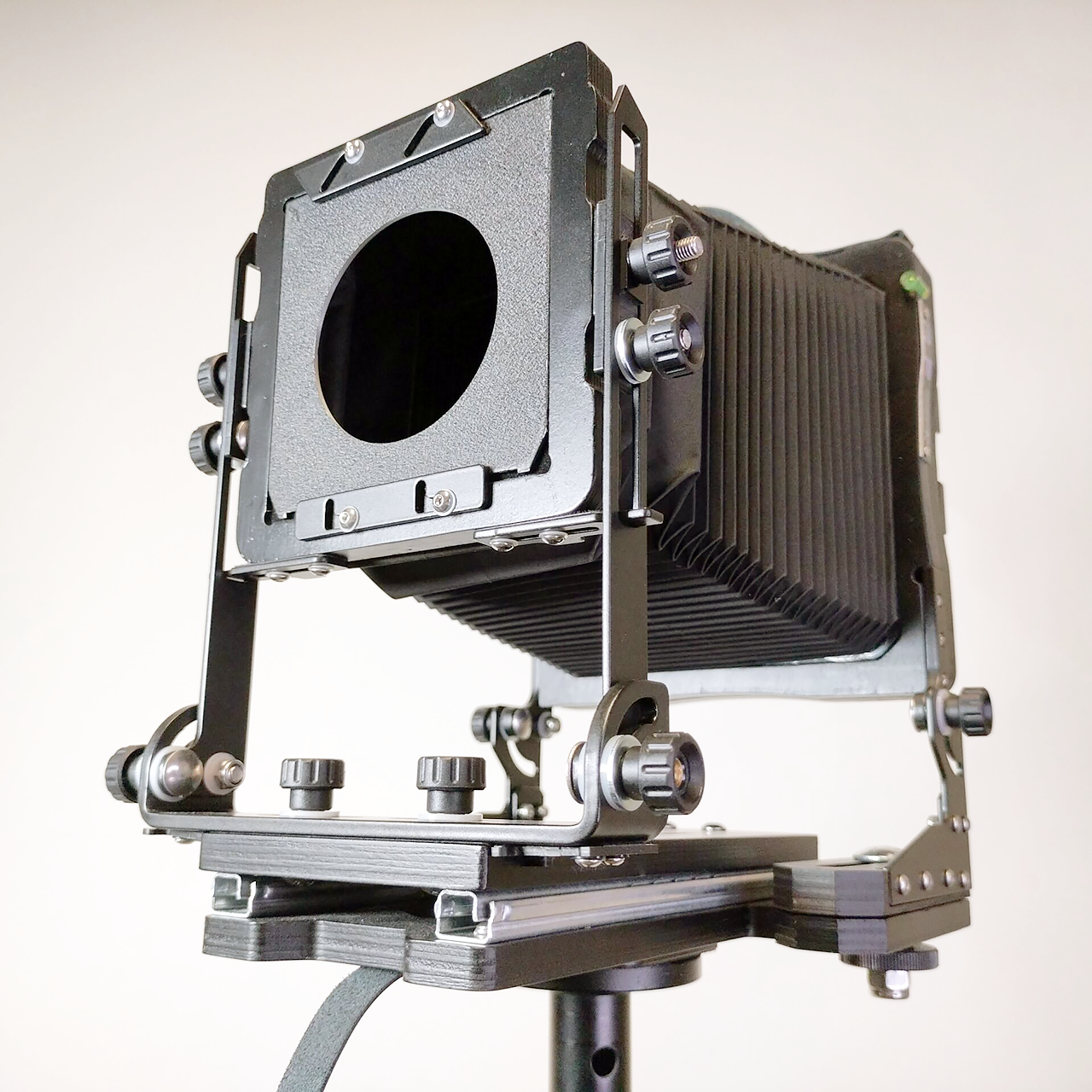
Air Force 4×5 is a new concept of affordable camera from StenopeiKa, is the heir to the legendary Hyper camera 4×5 mk3.
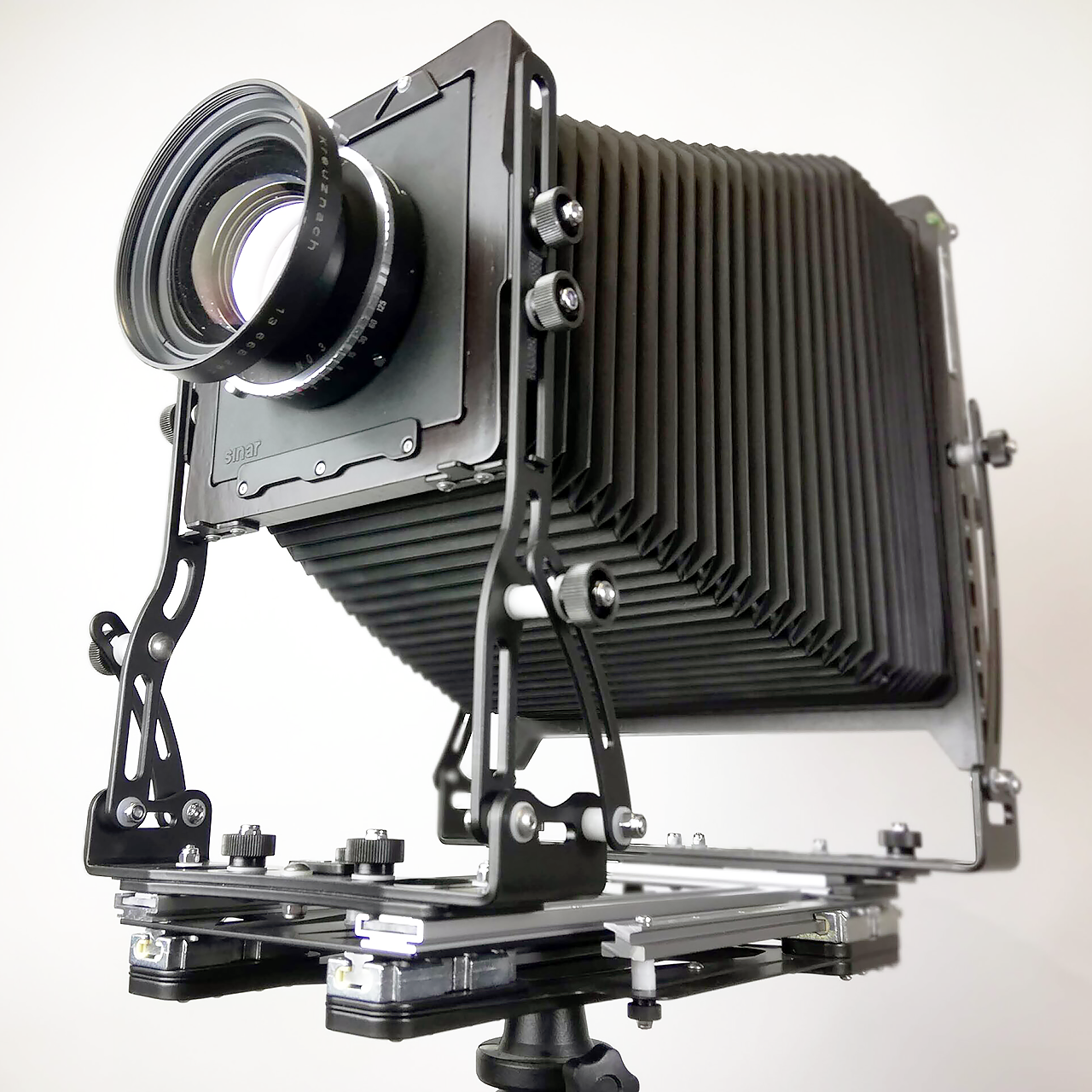
Leonardo 8×10 is an evolution of the 810se2 folding camera. Available in iroko wood, Cypress tuscany wood and exclusive Olive wood.
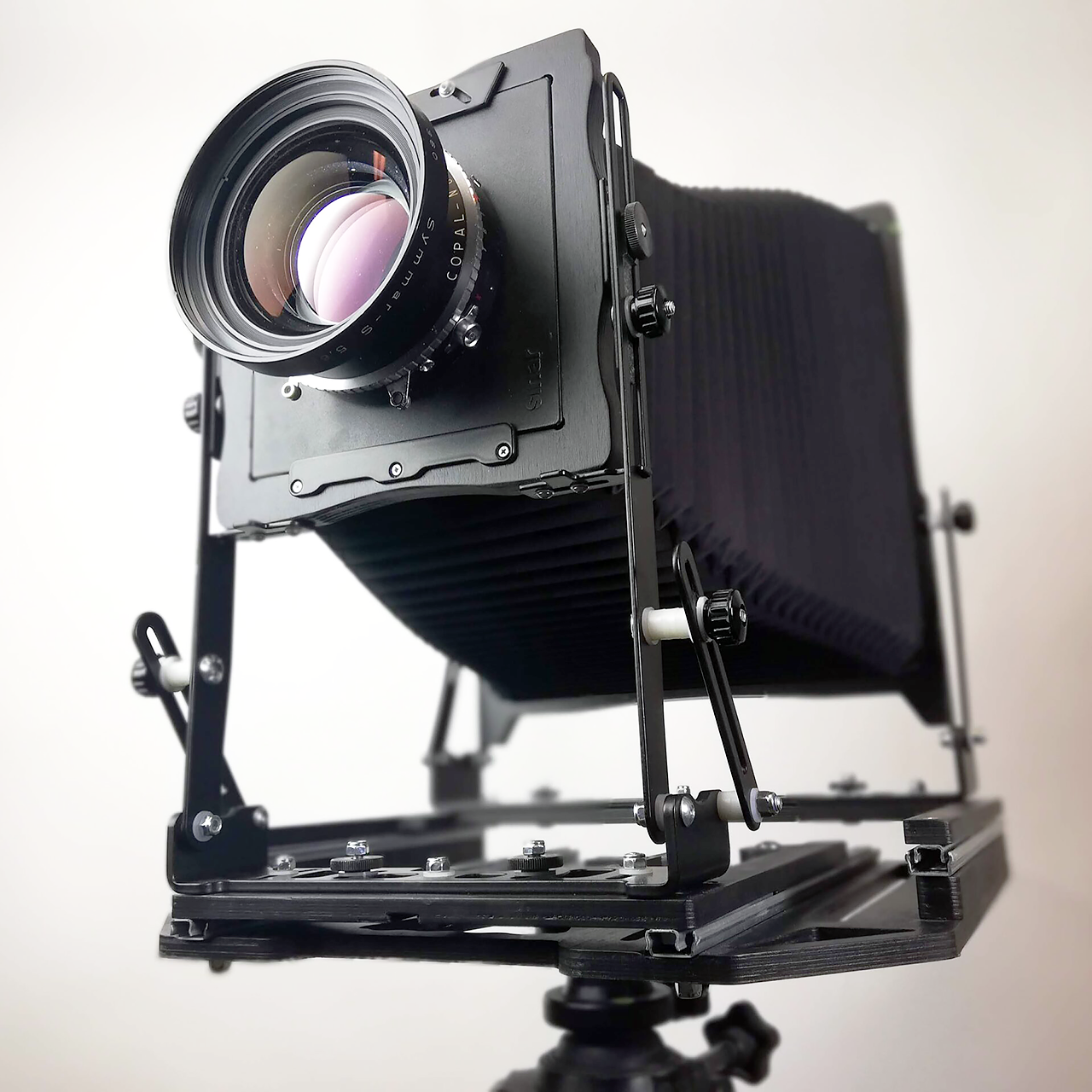
Hyper camera 8×10″ mark 2 is an entry level and affordable 8×10 camera designed to fit into a hiking backpack with lightweight equipment.


